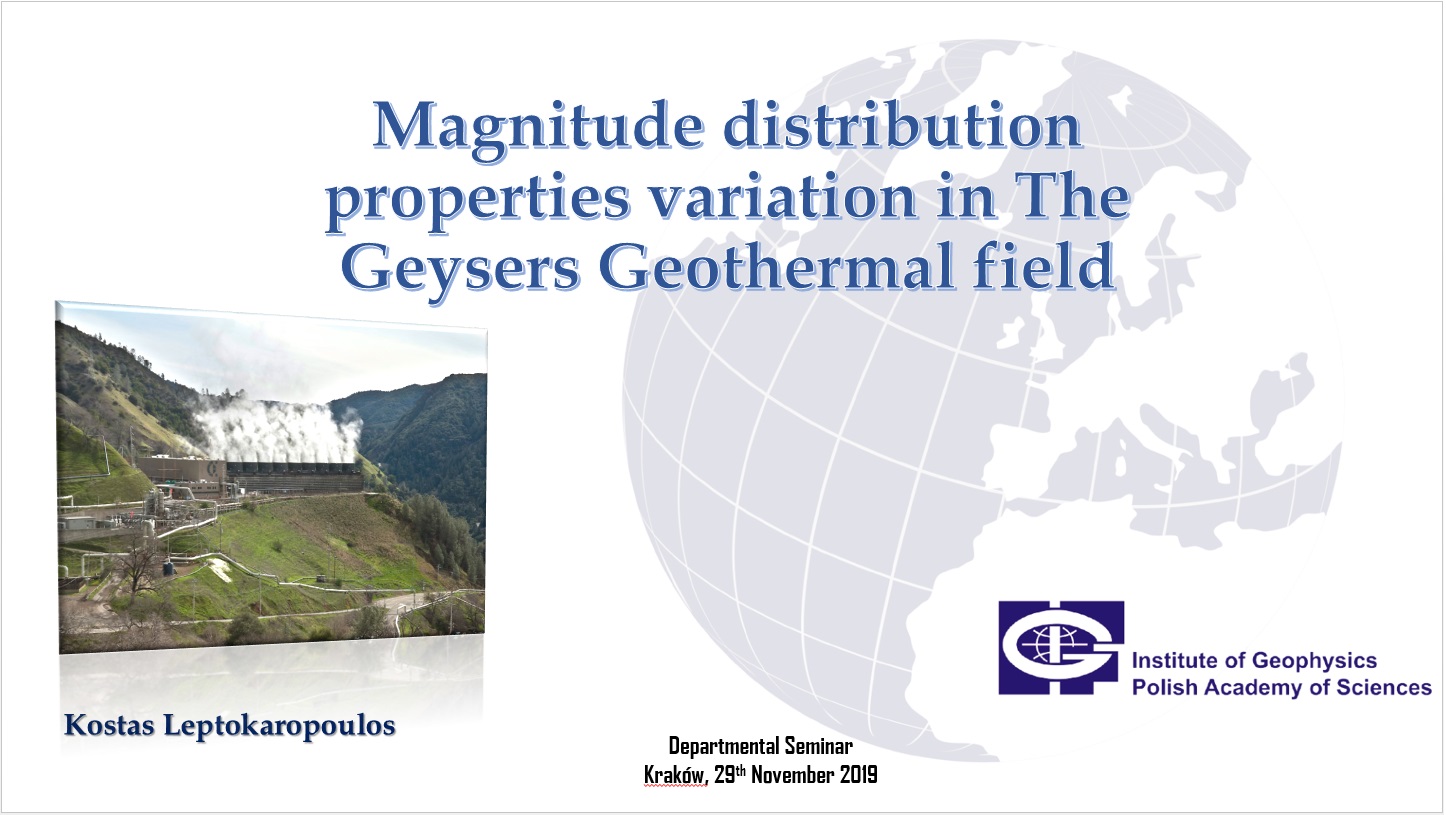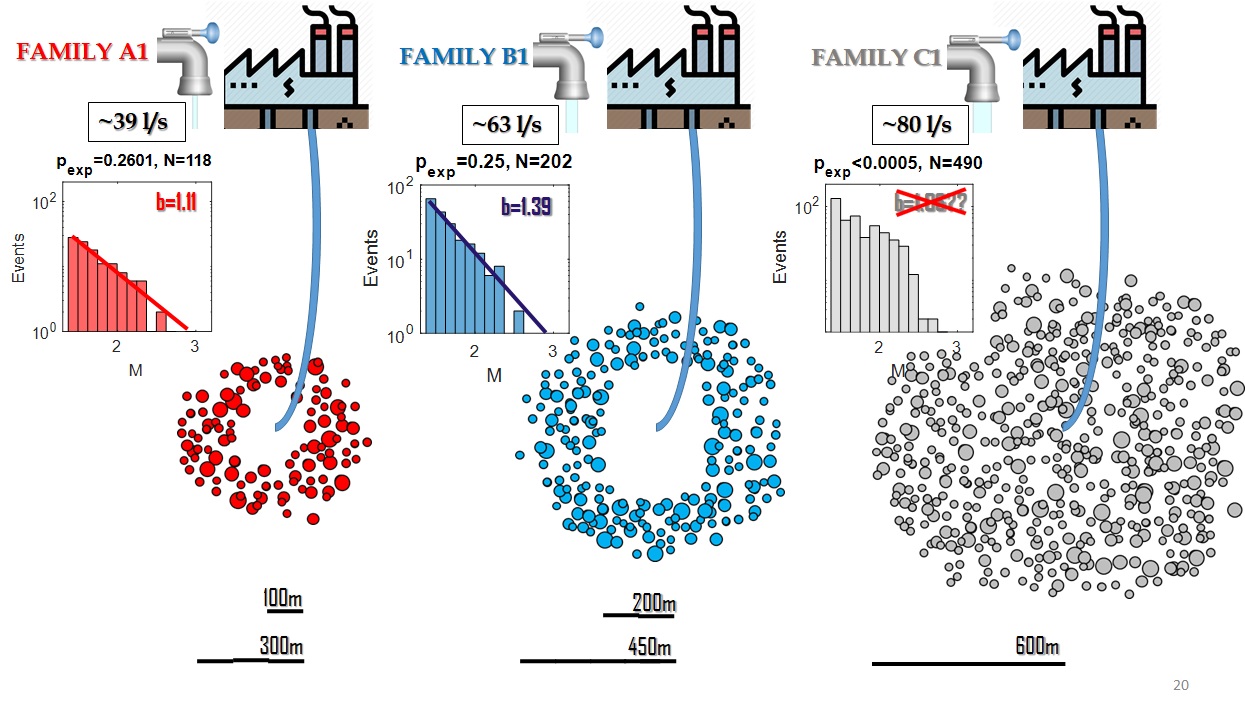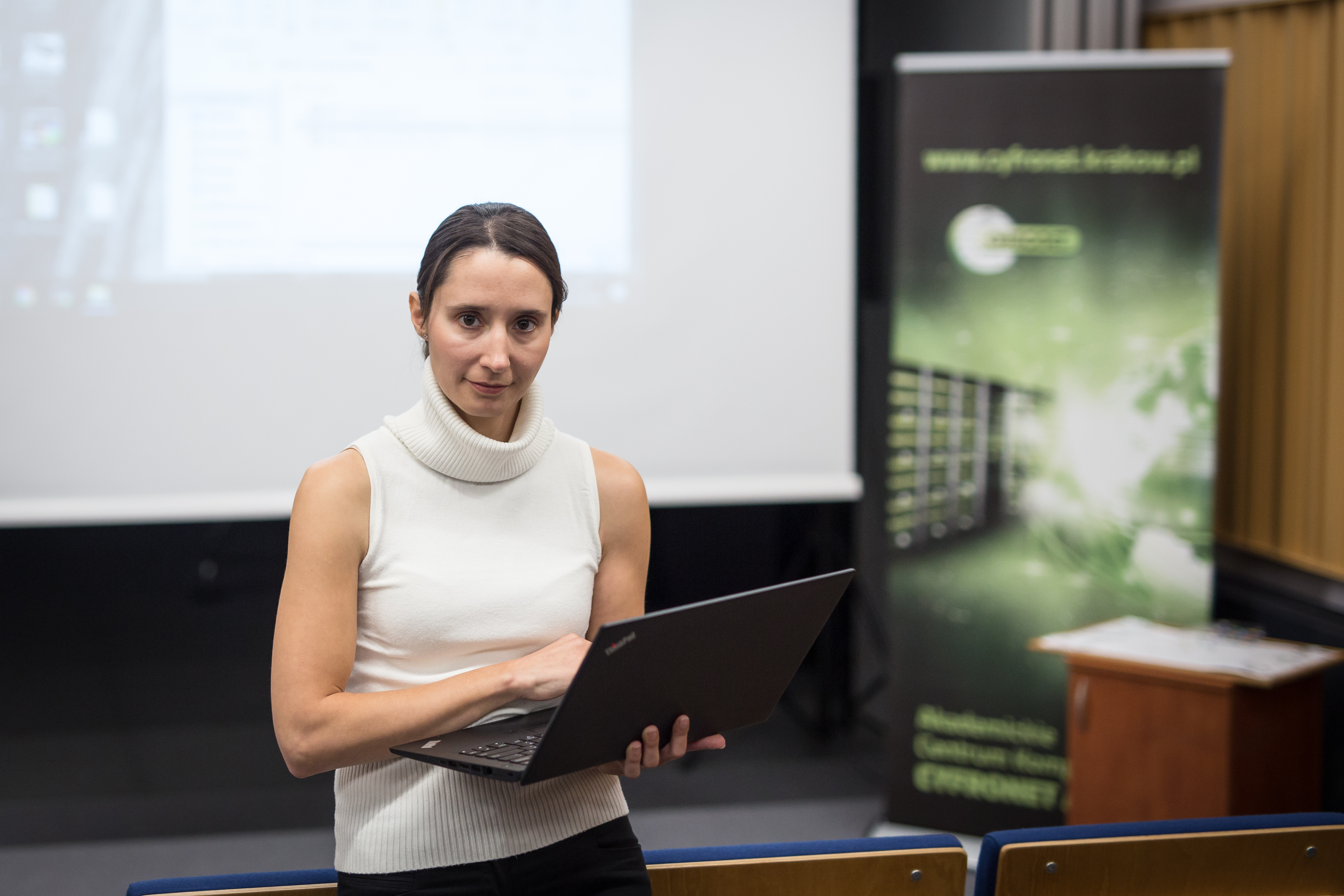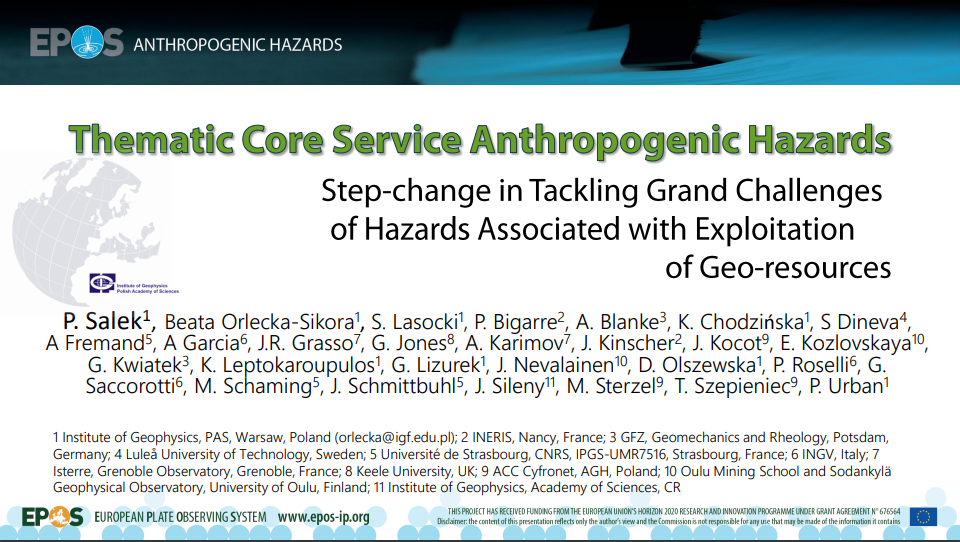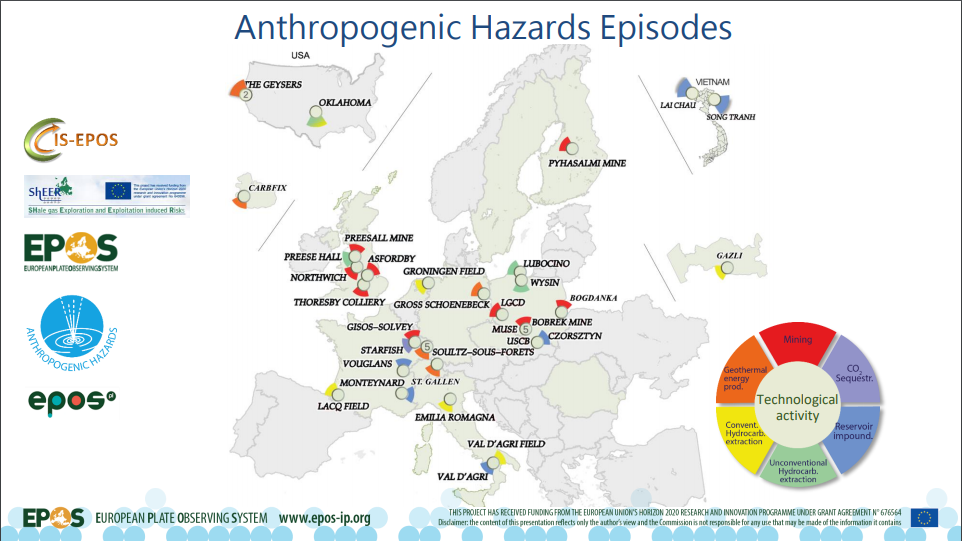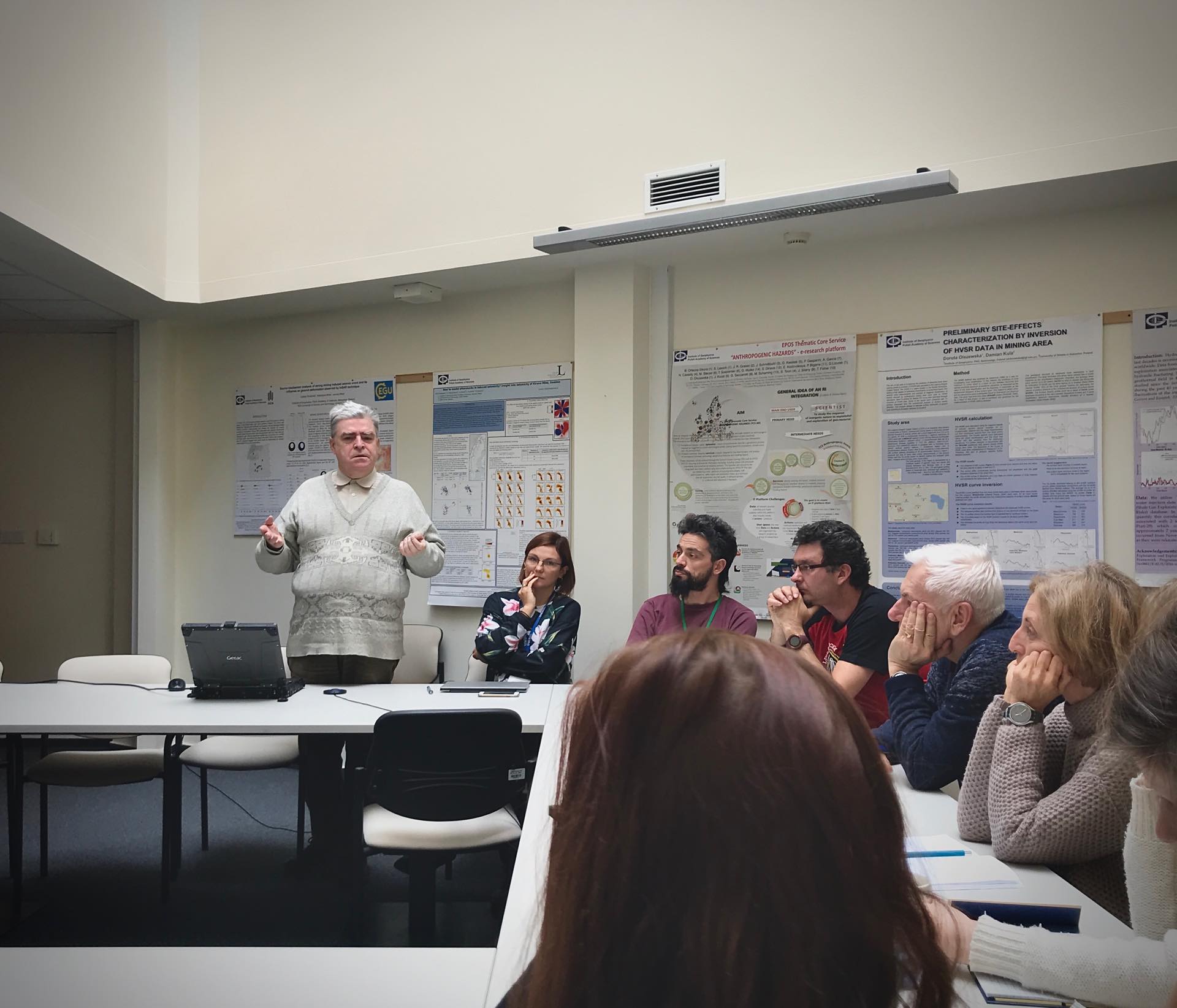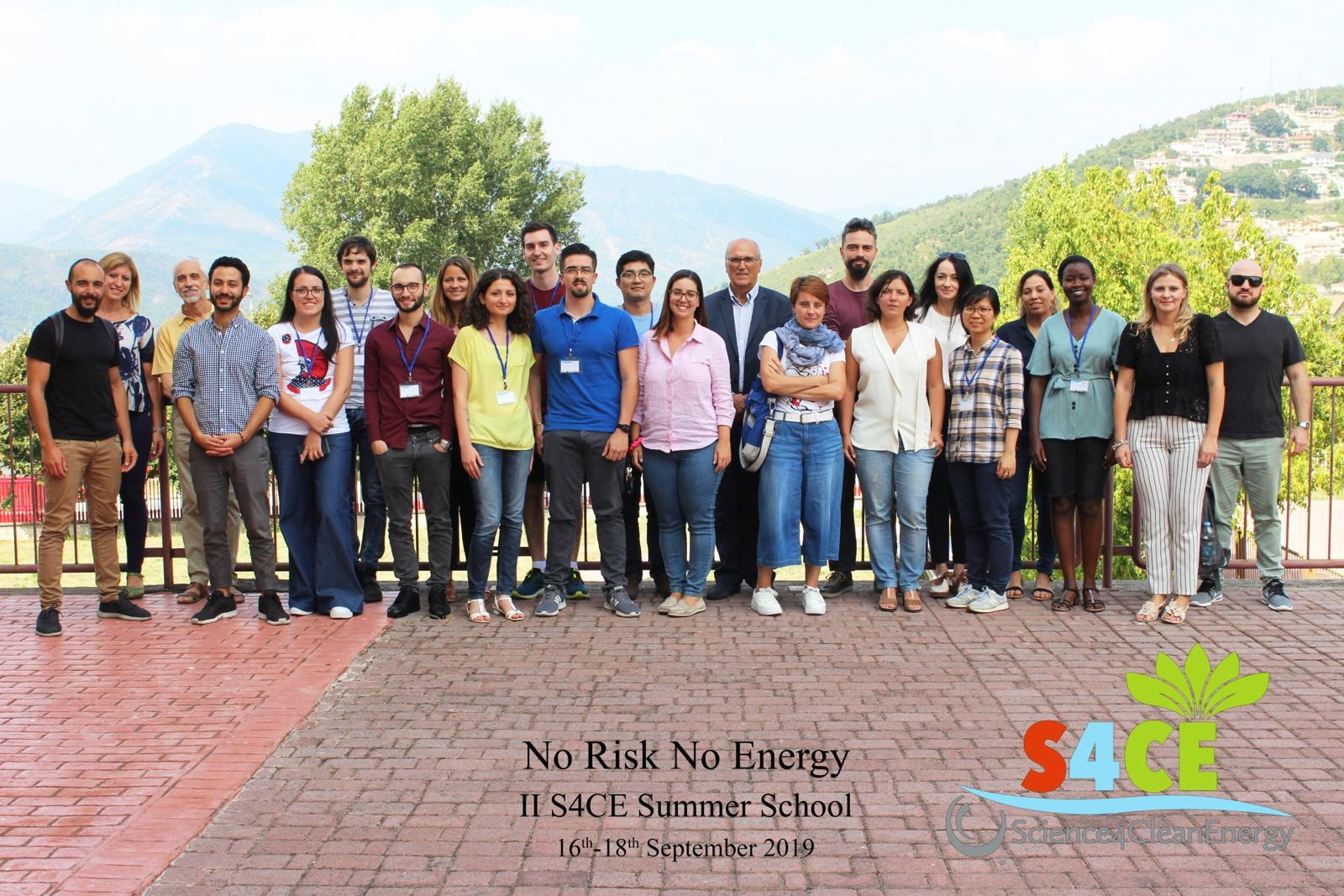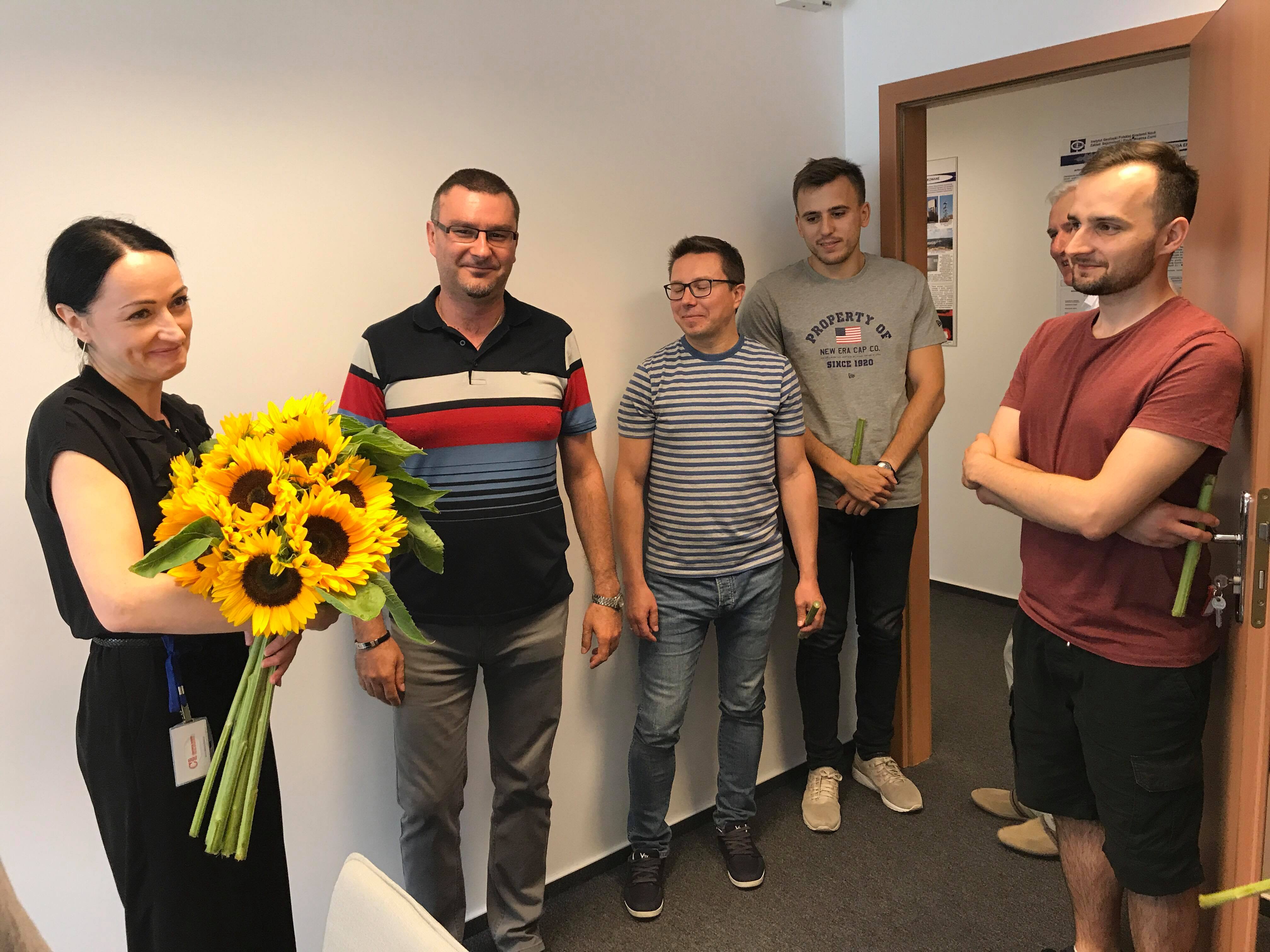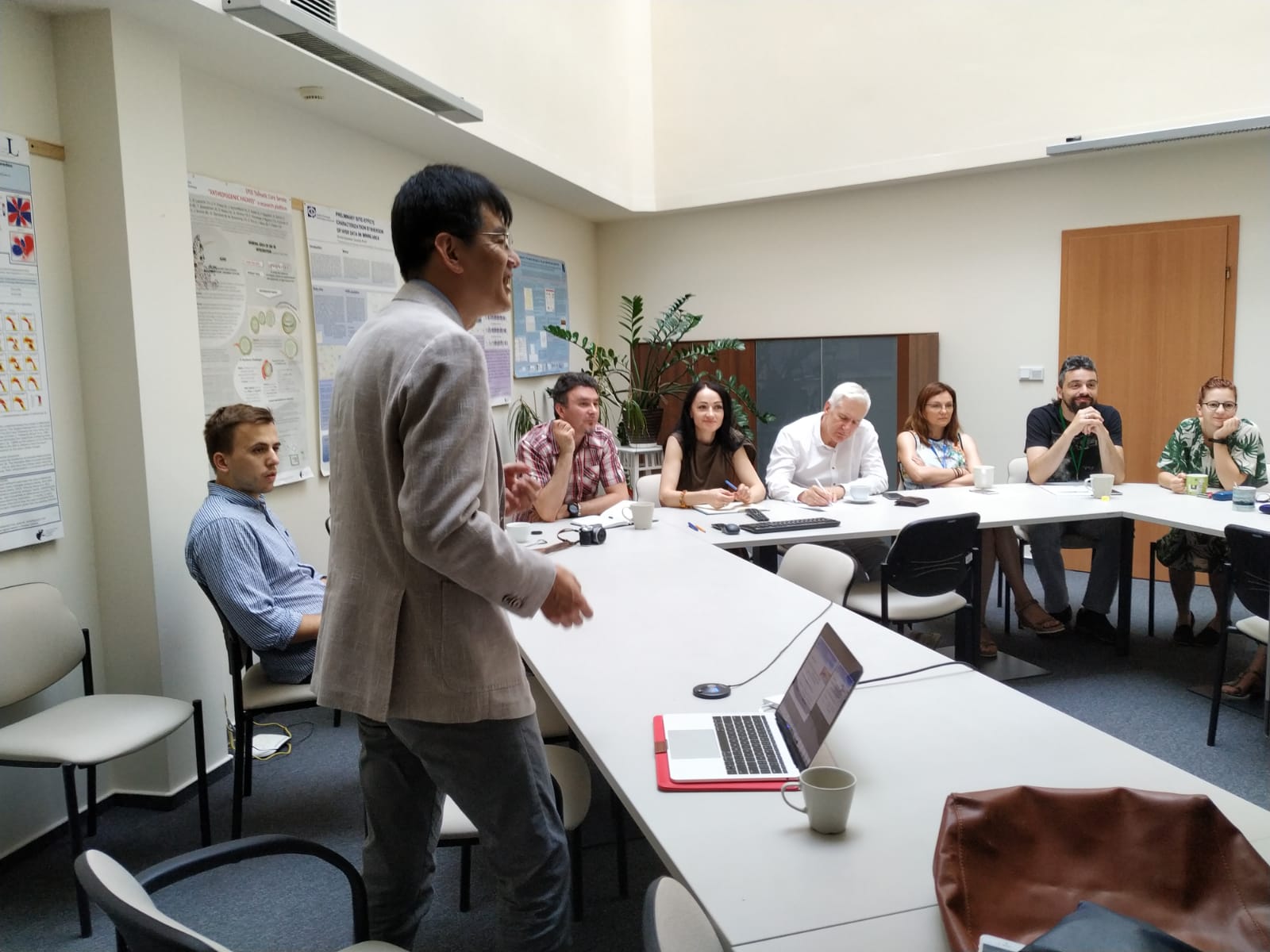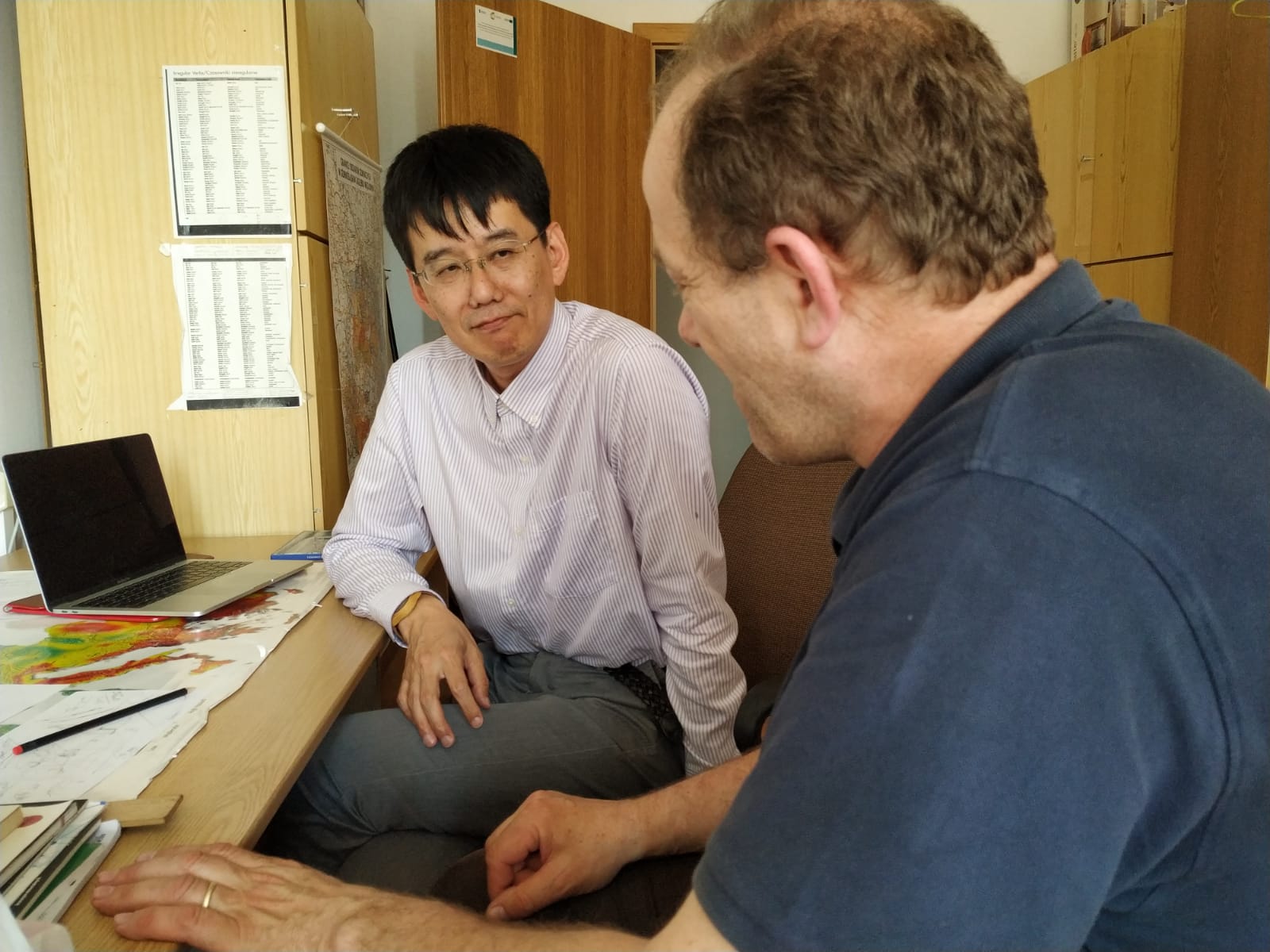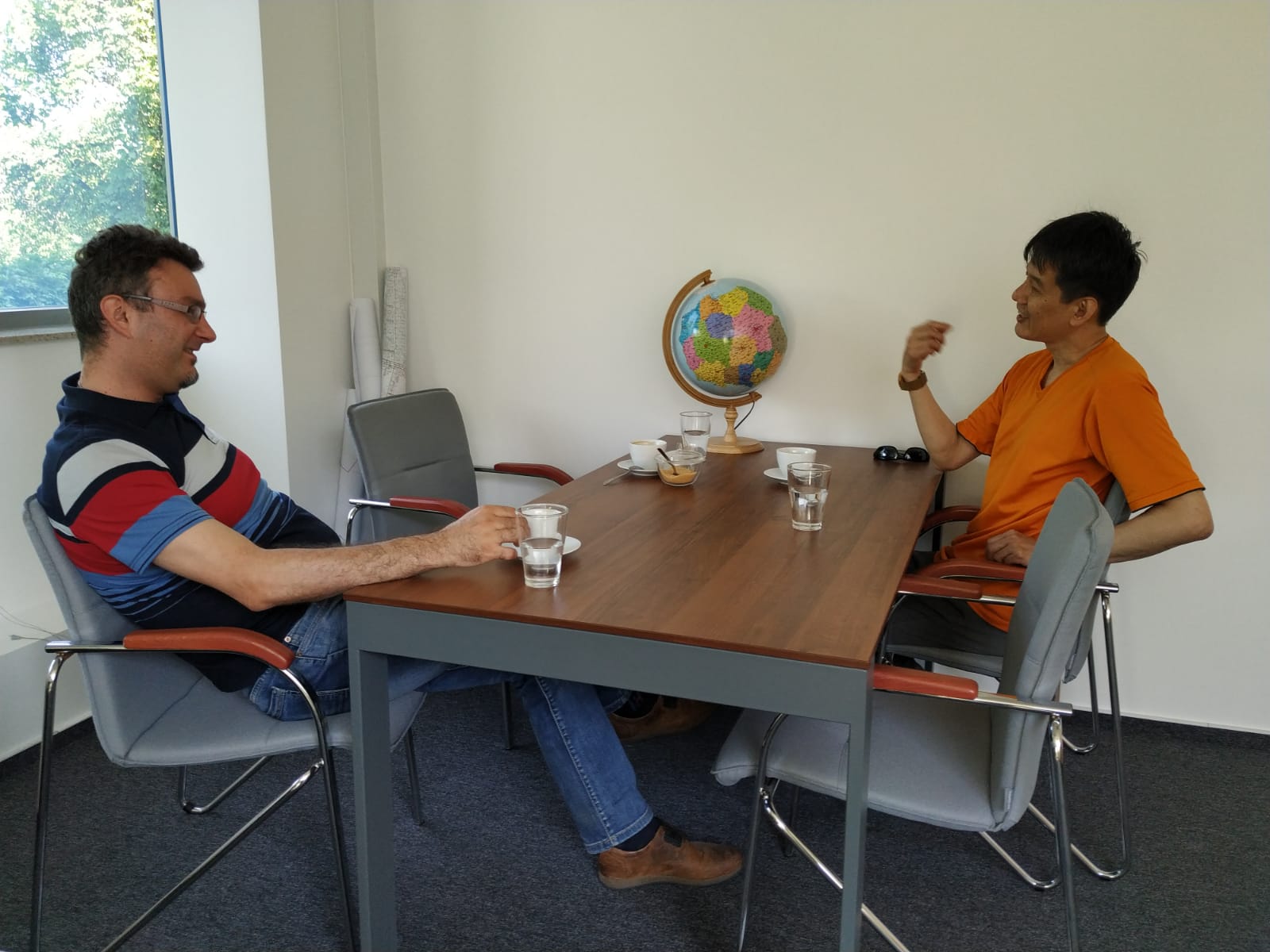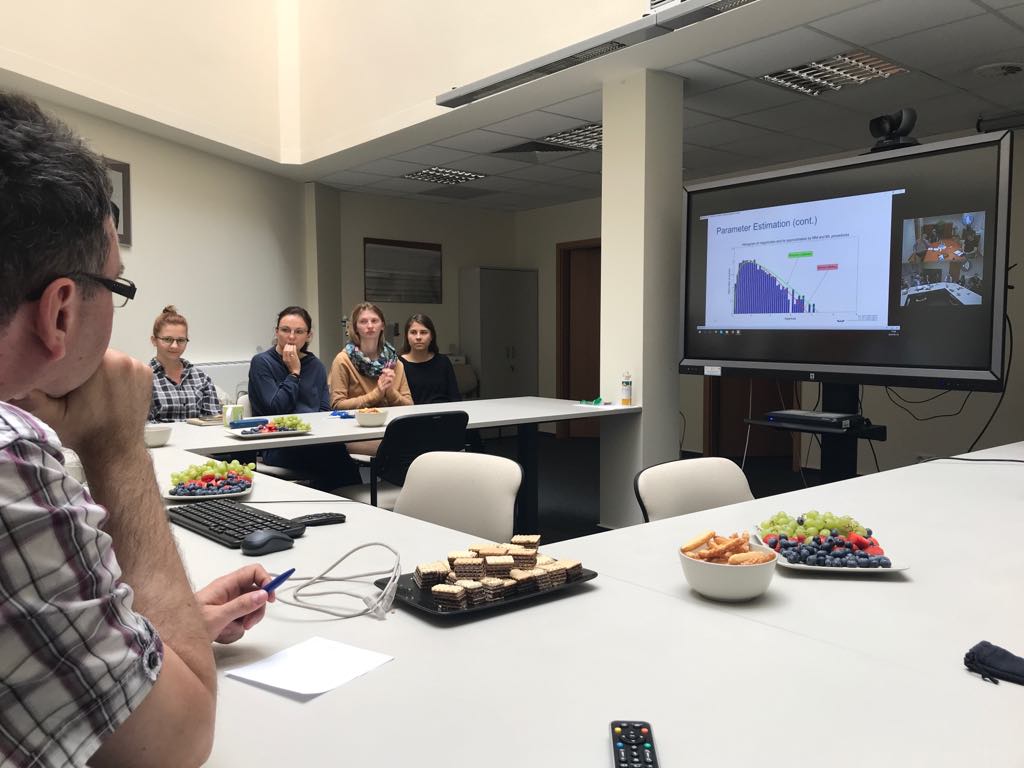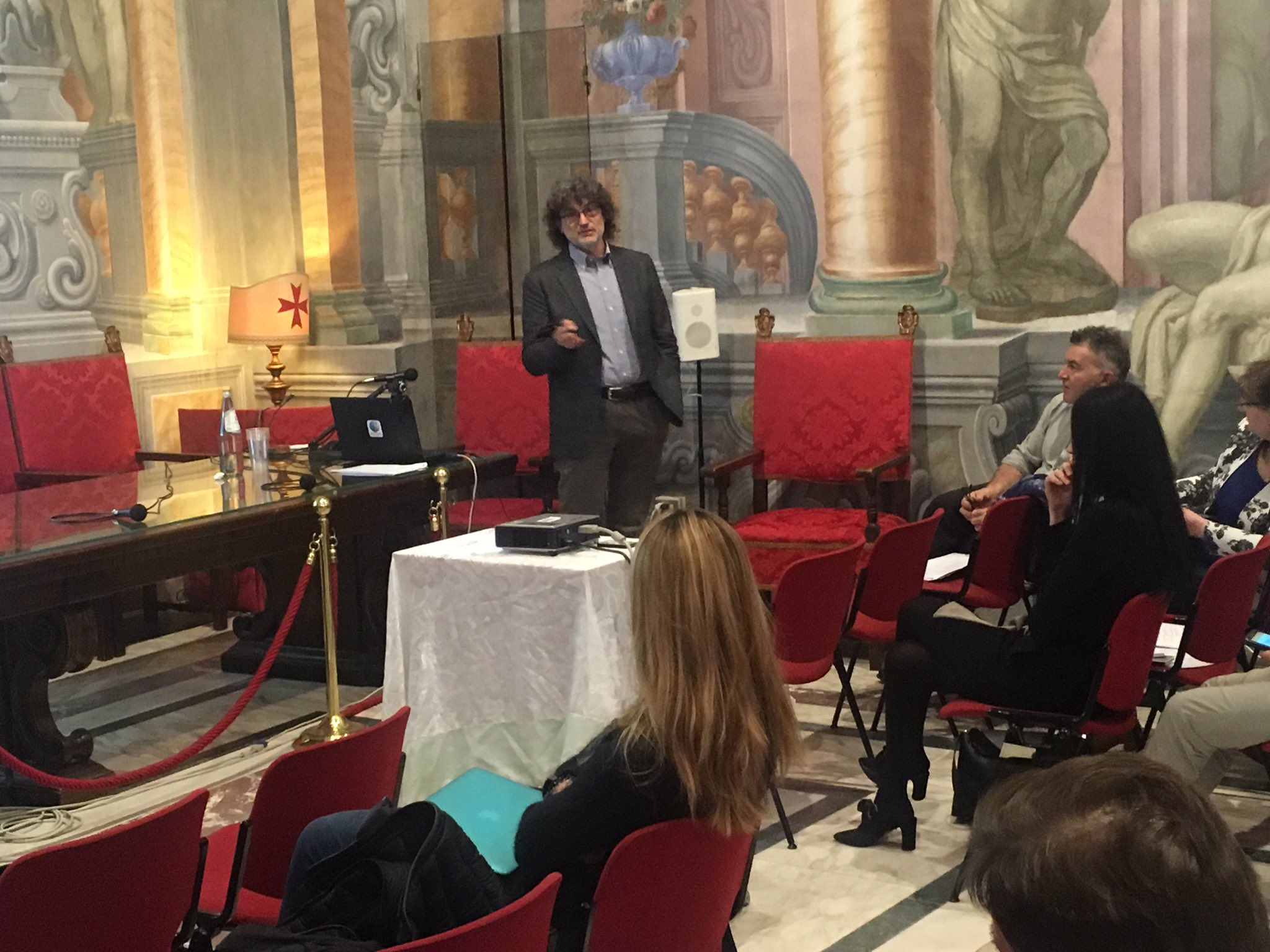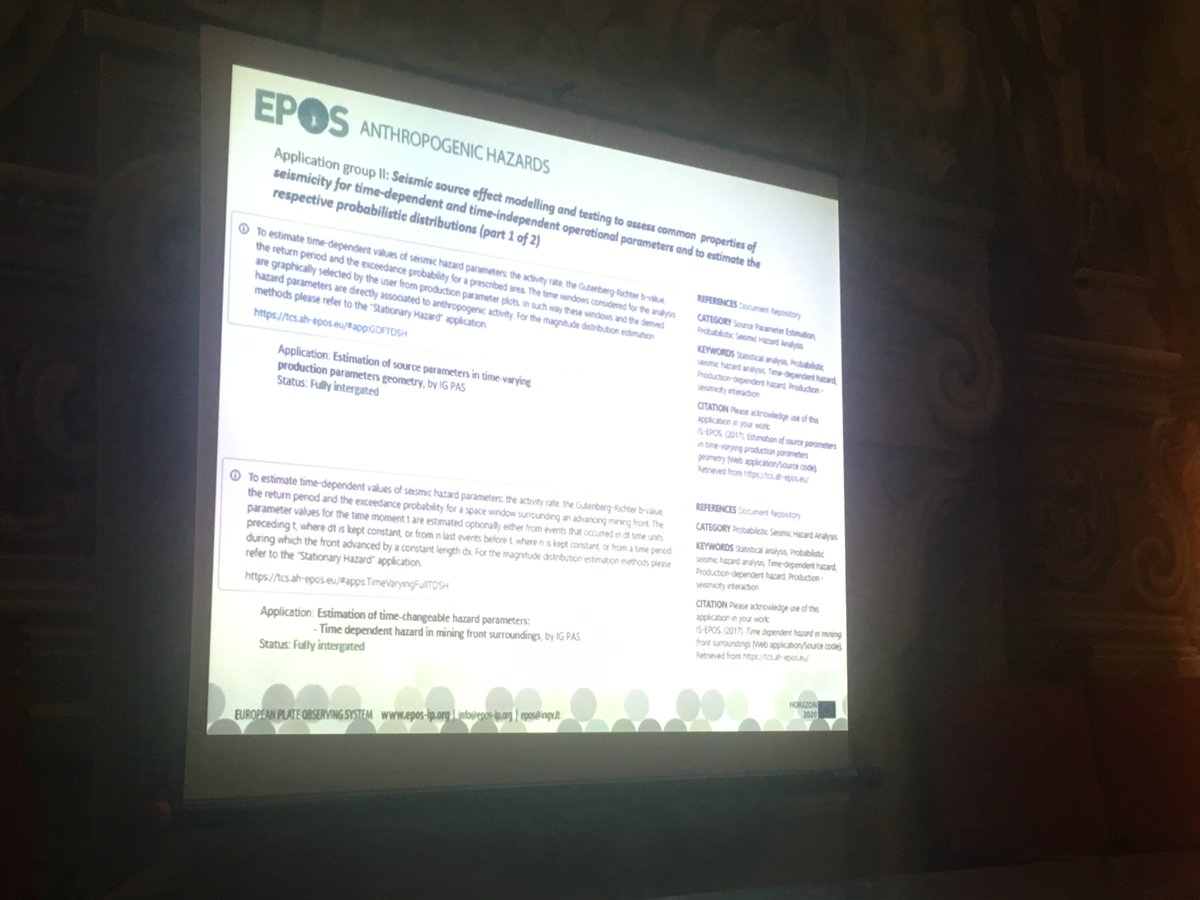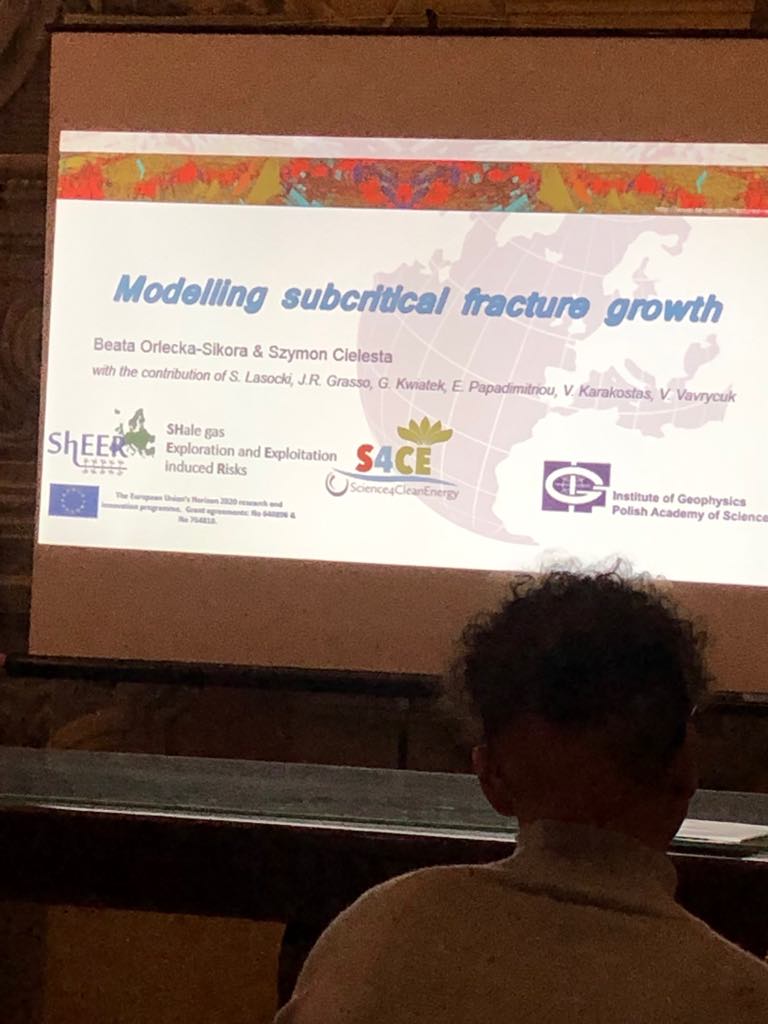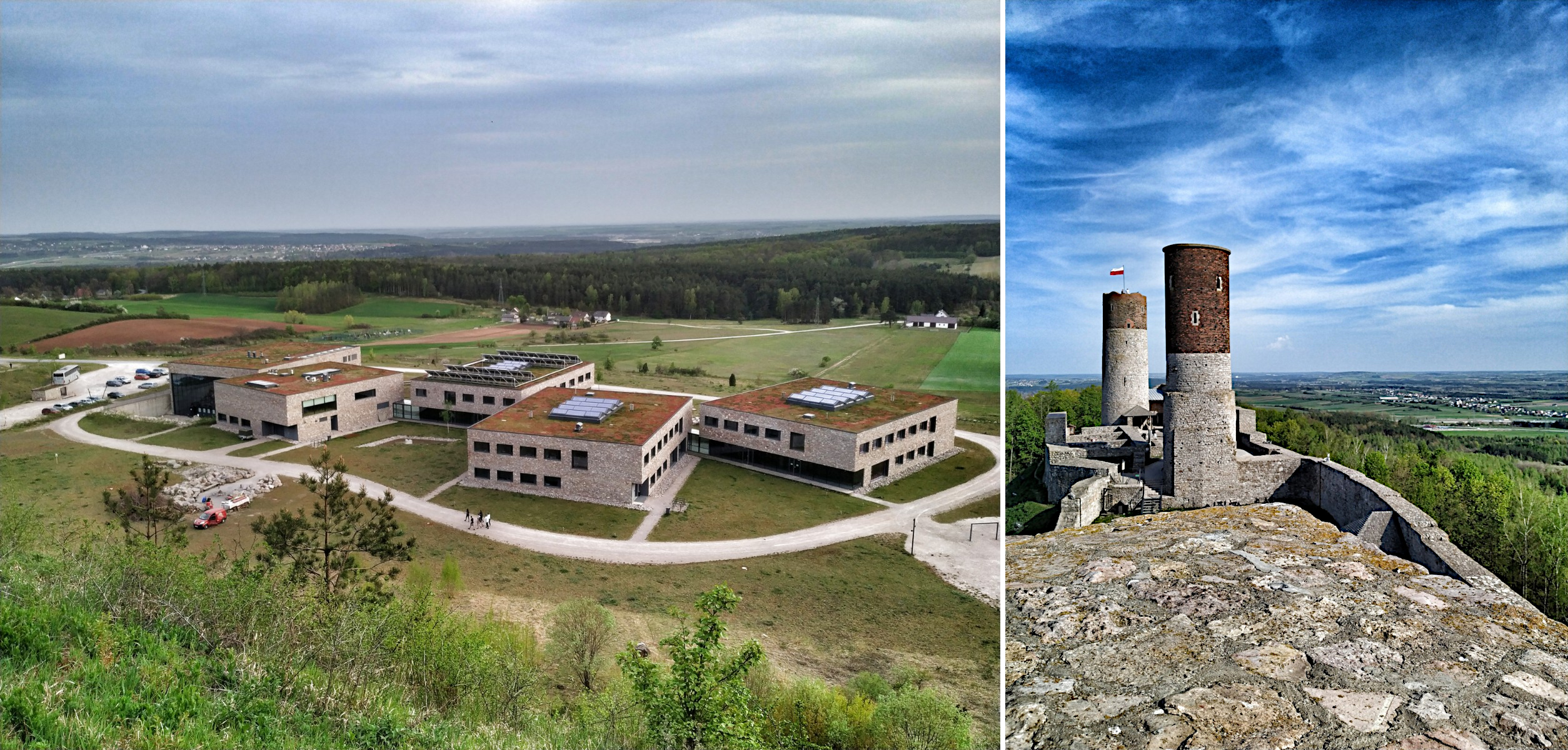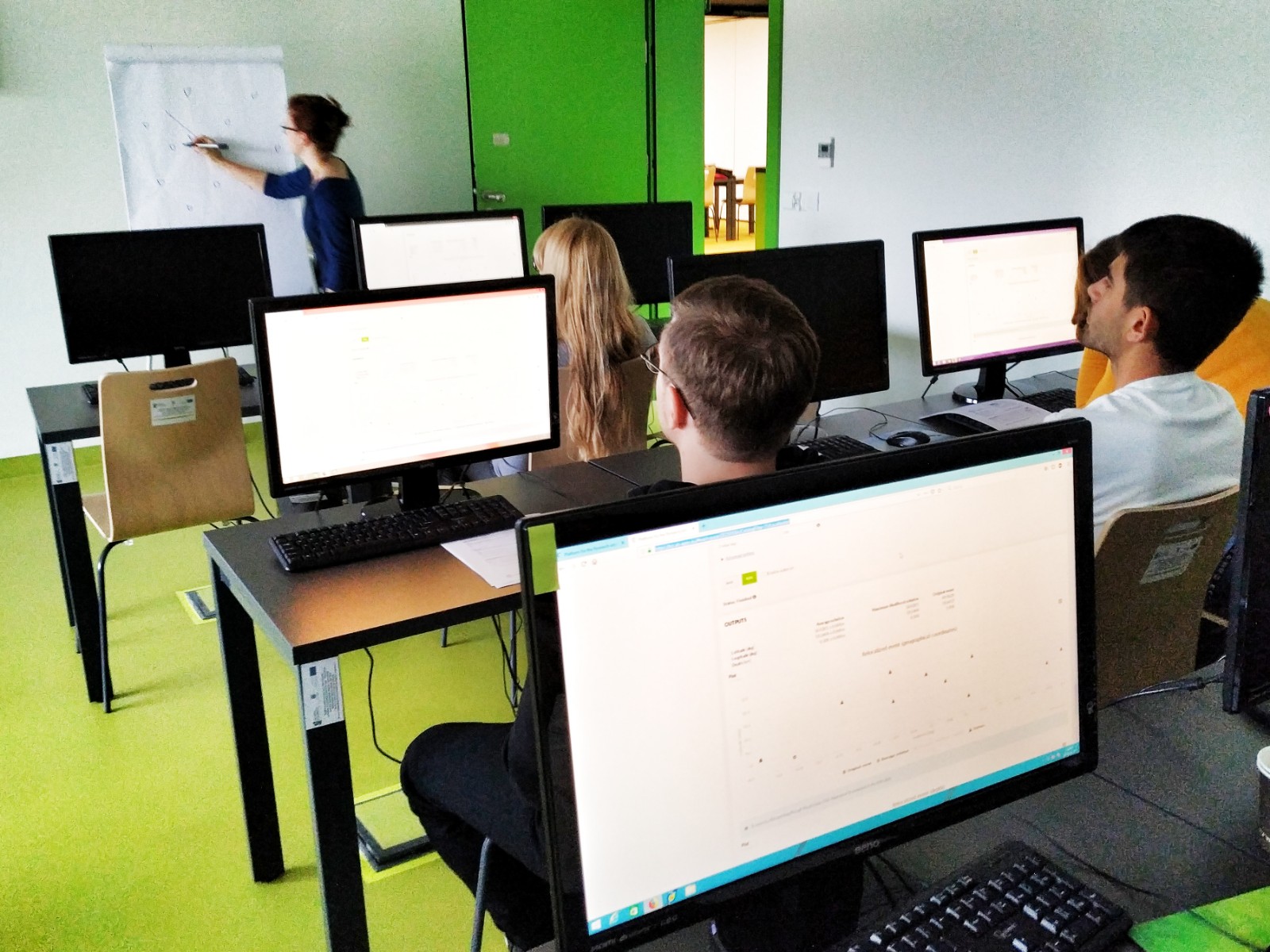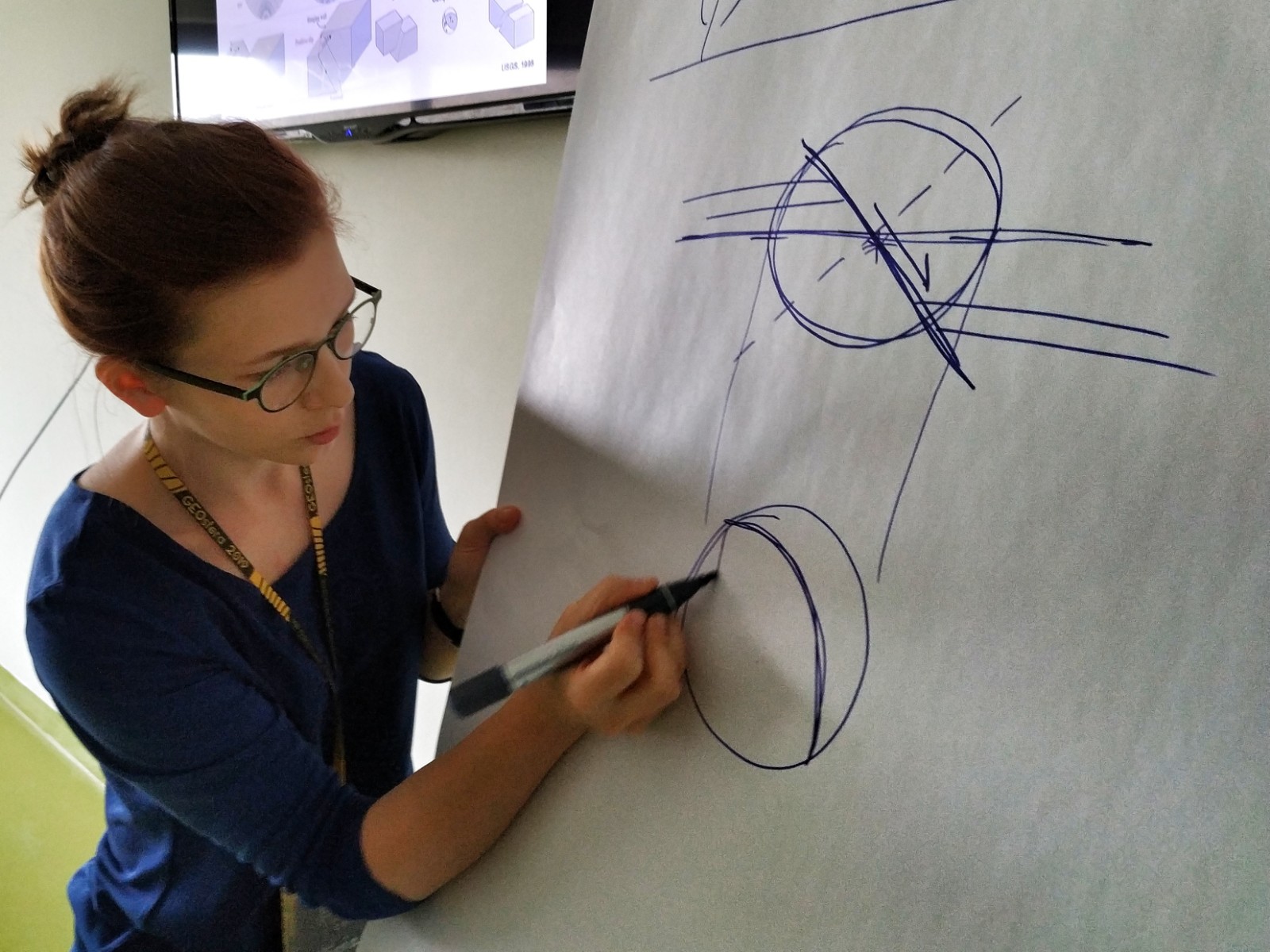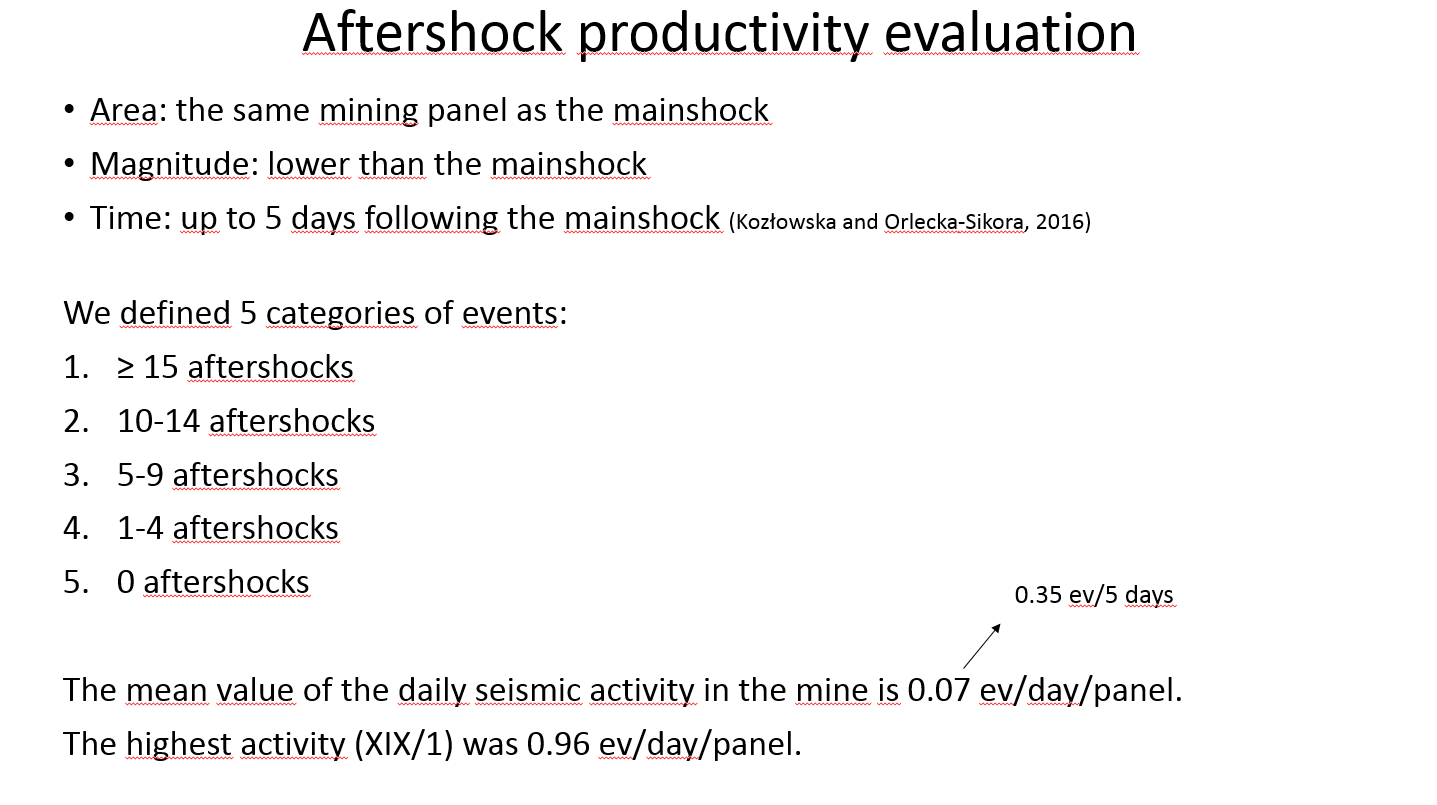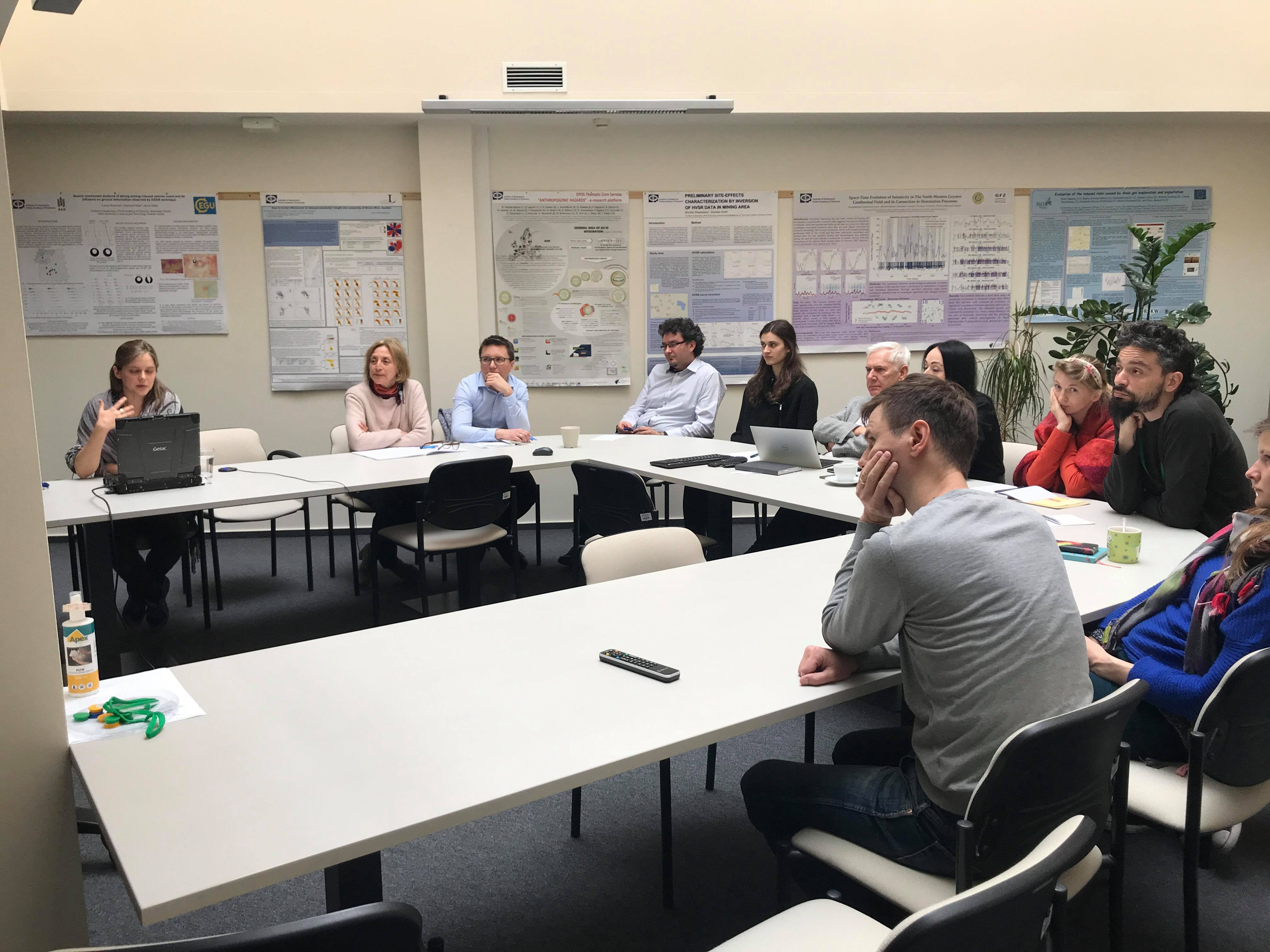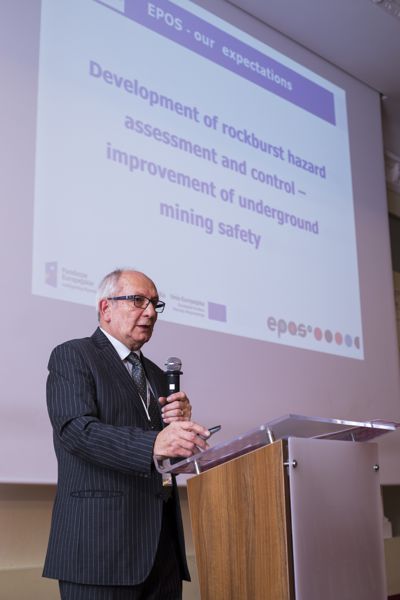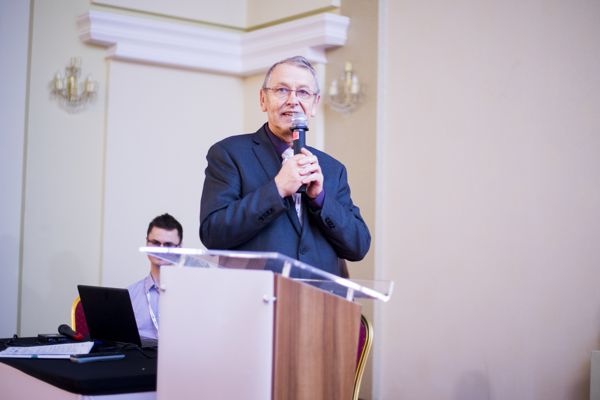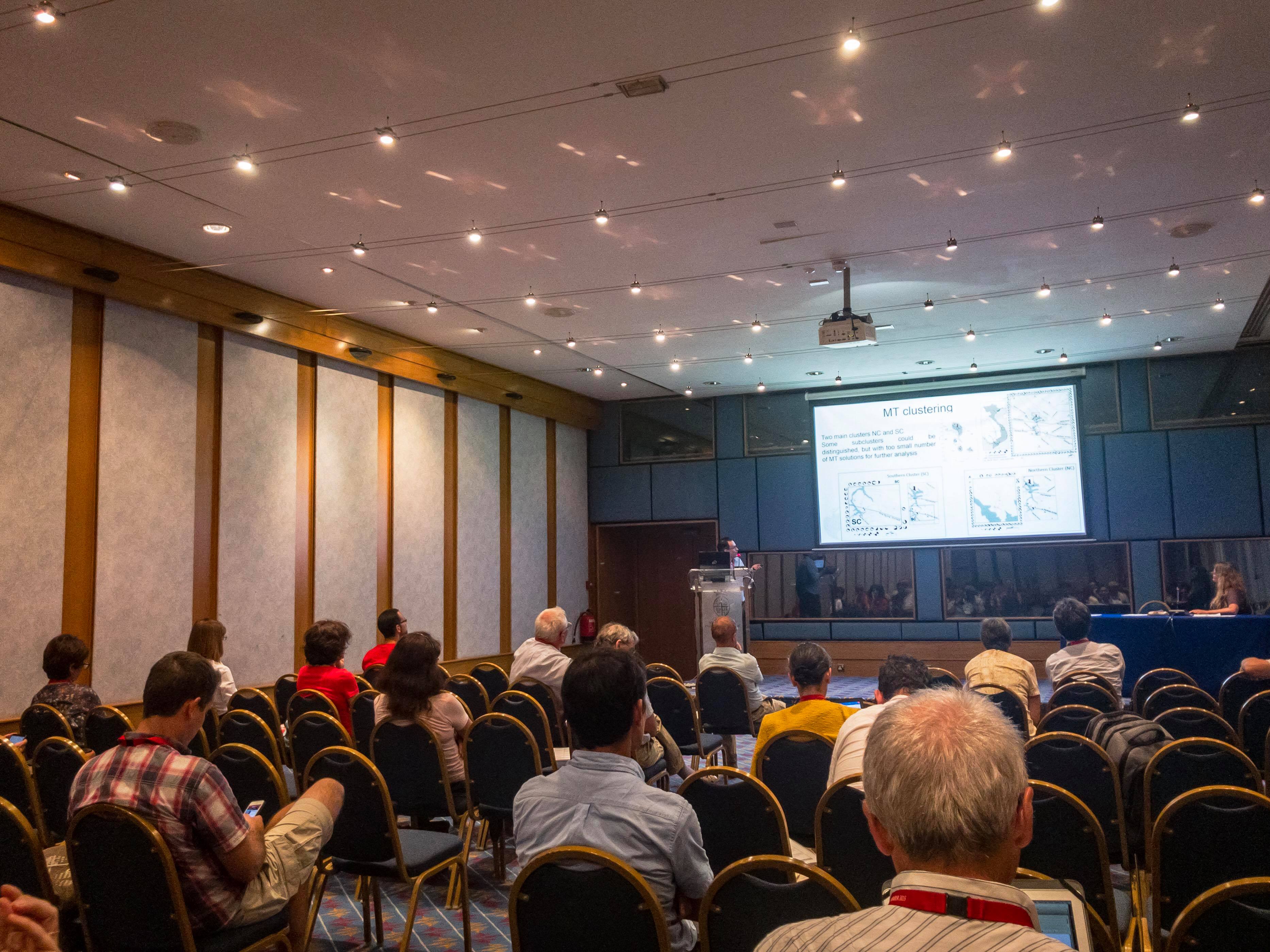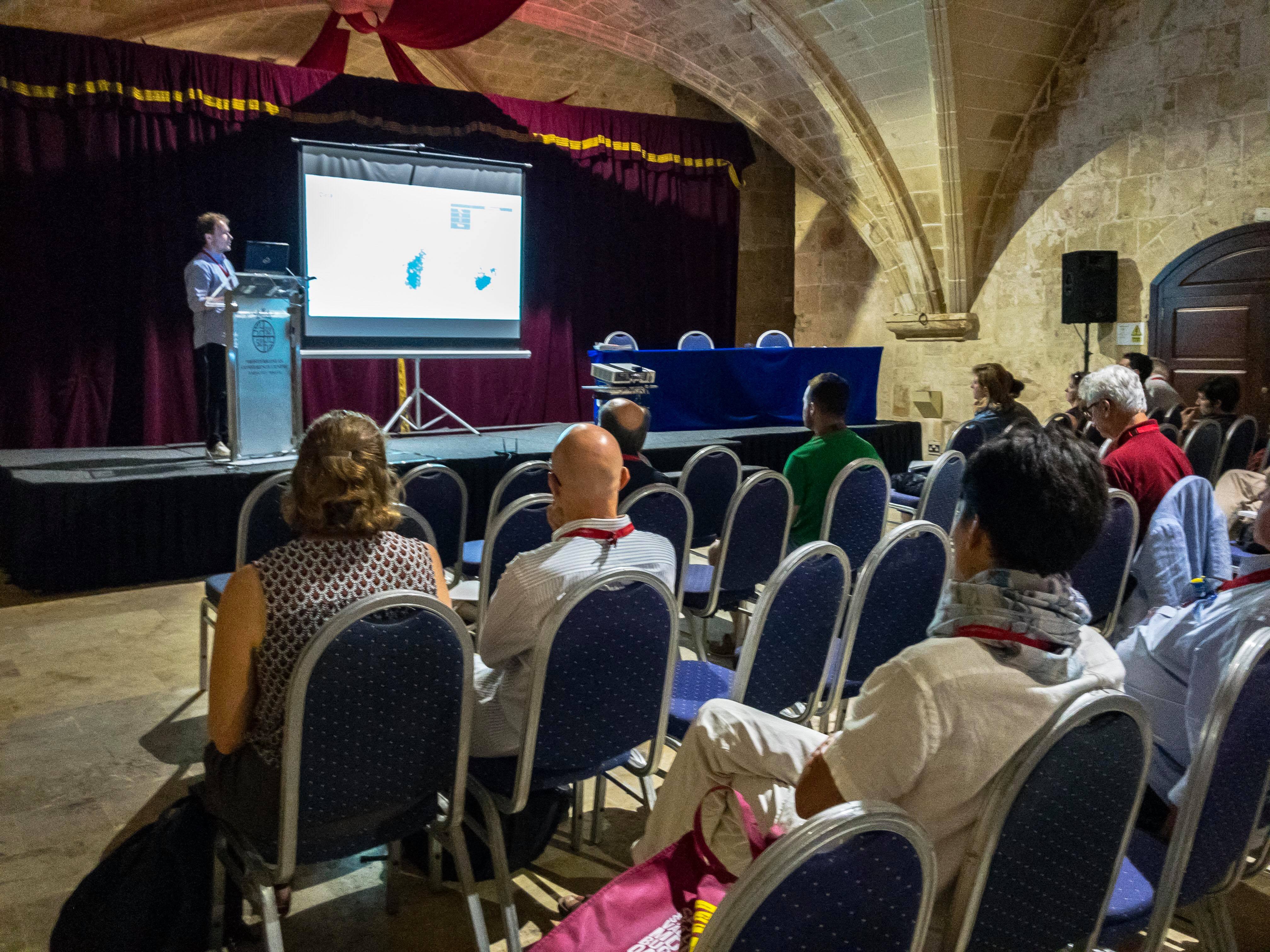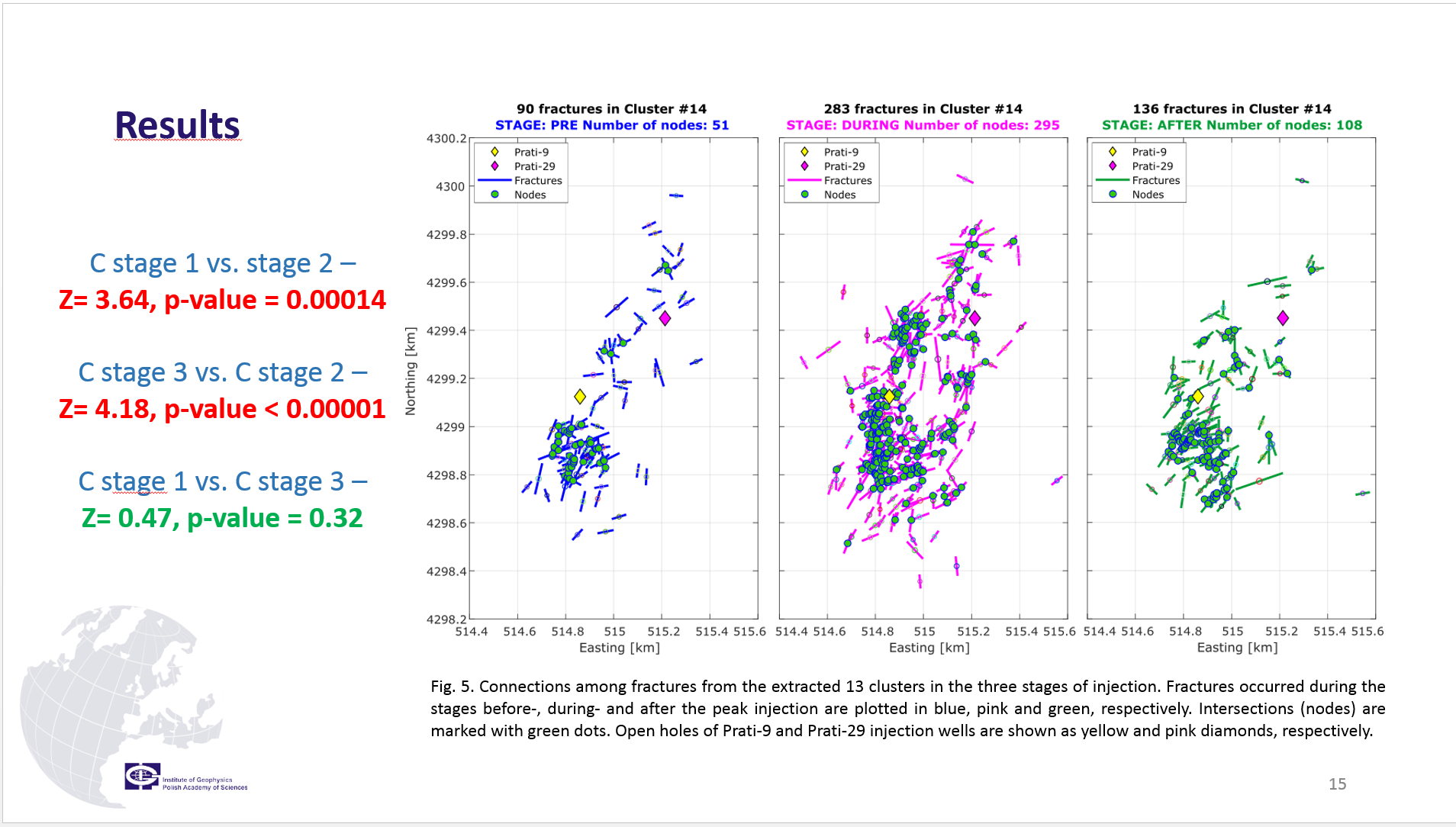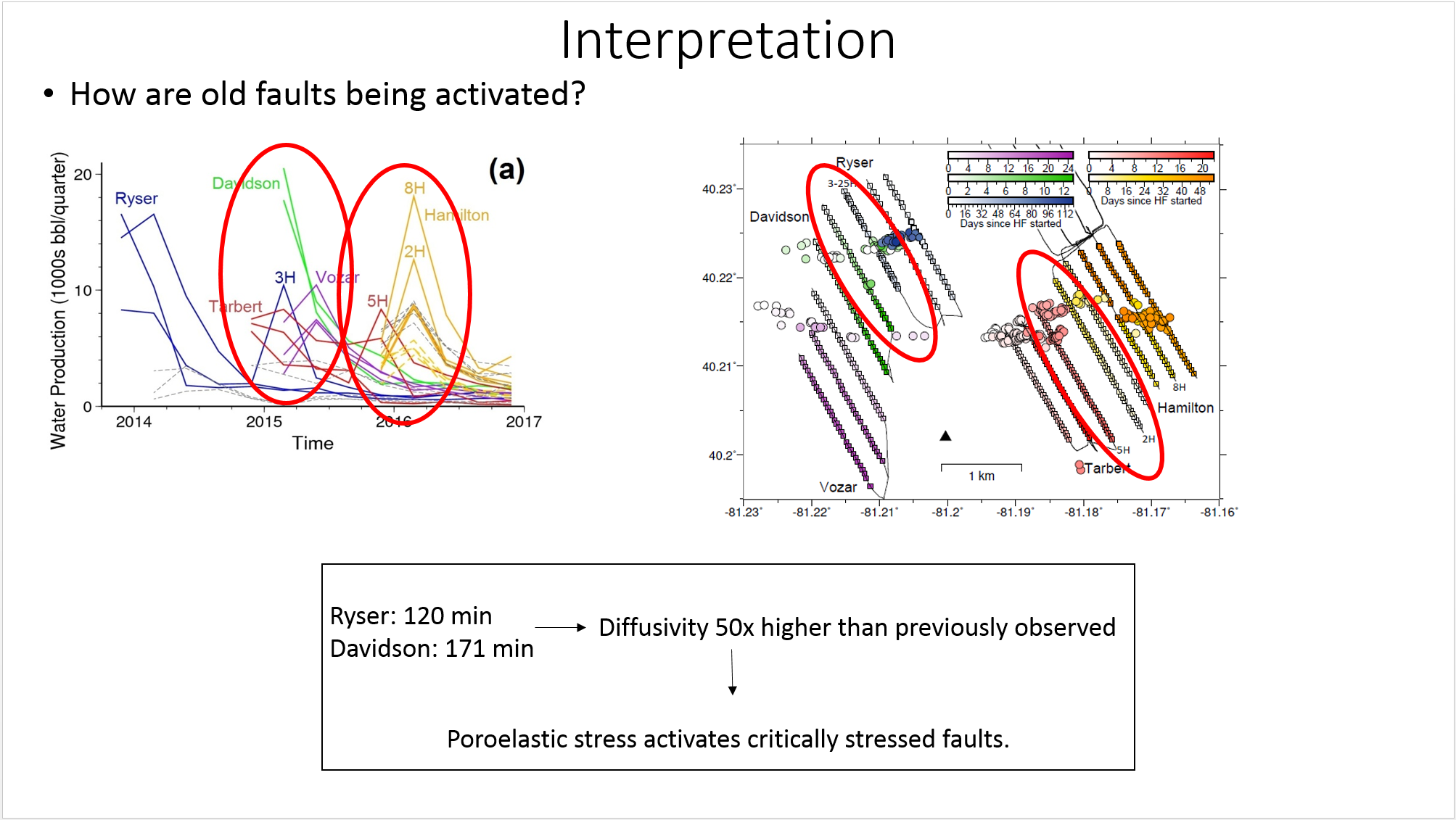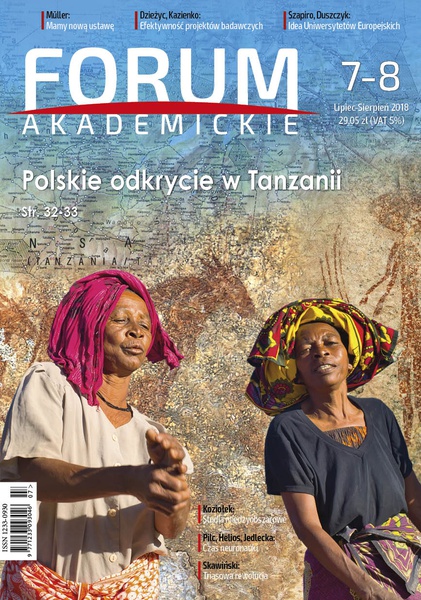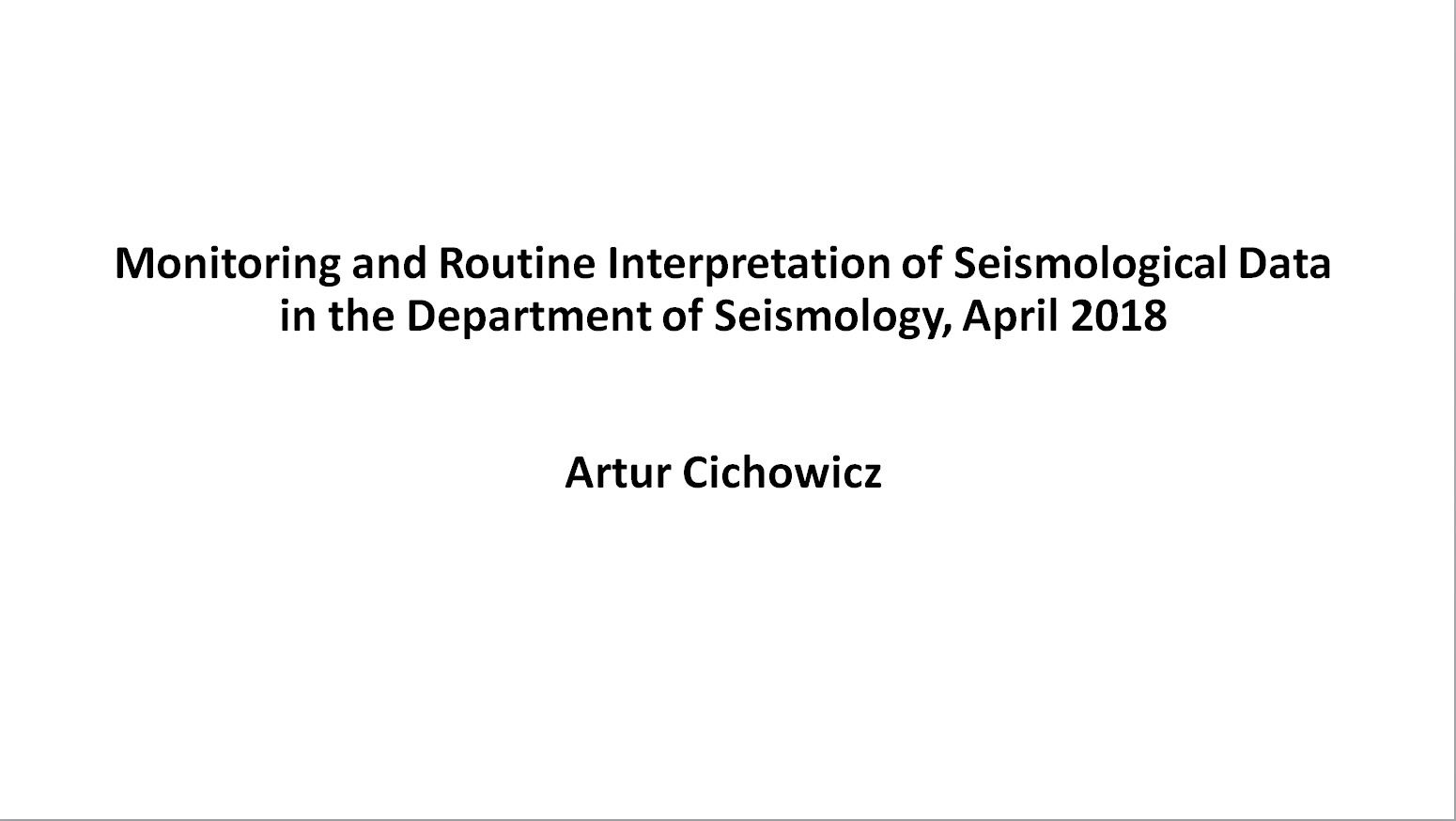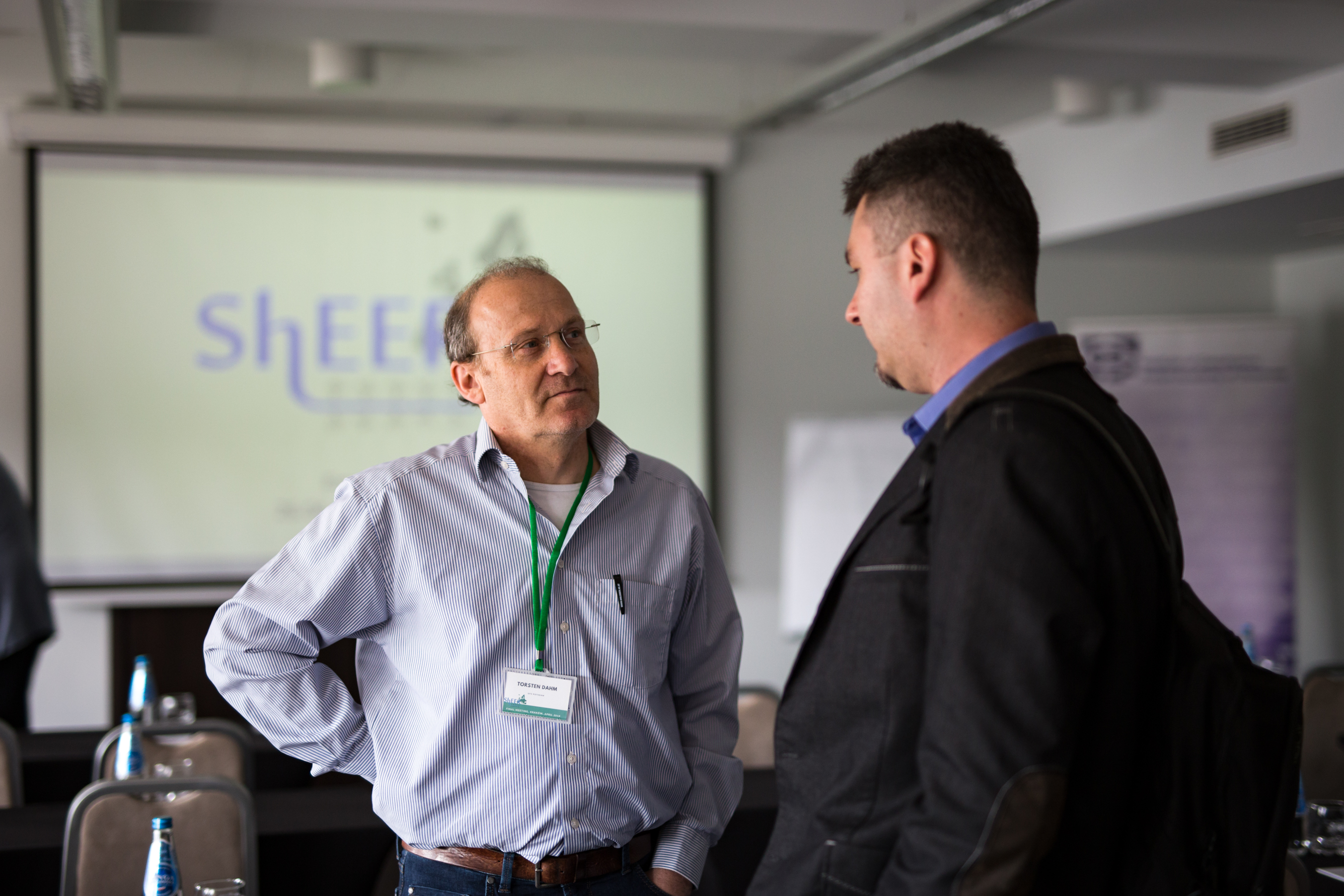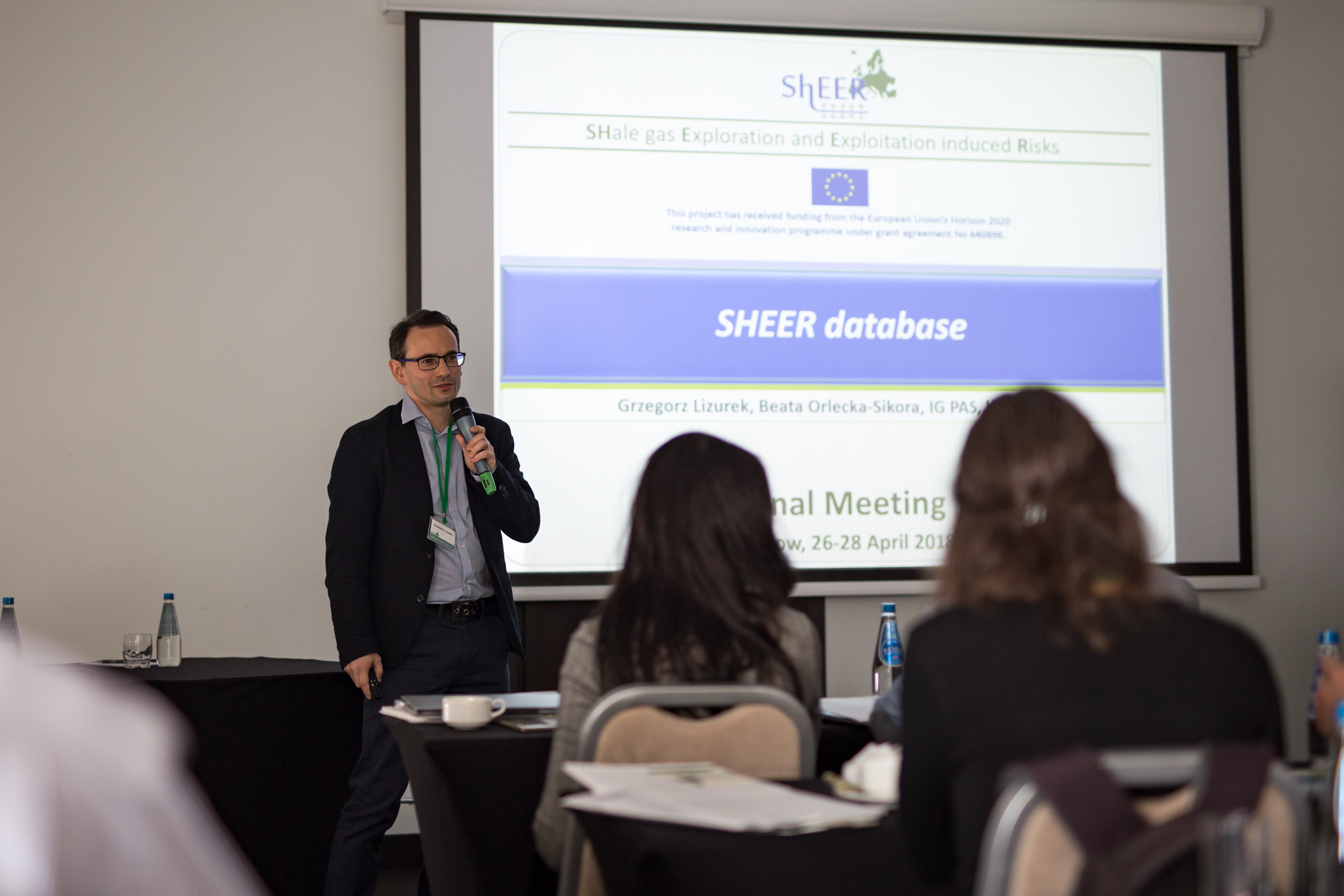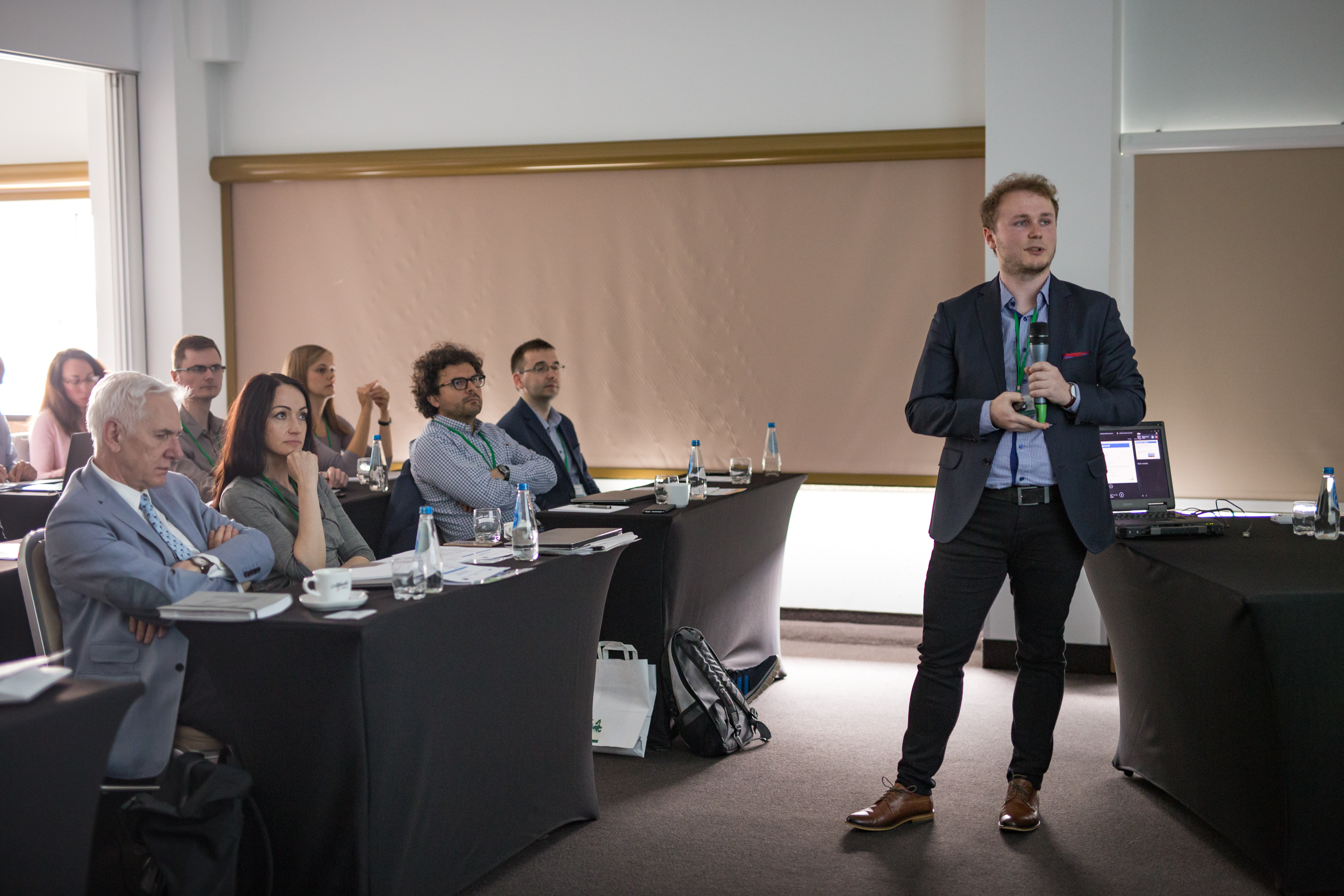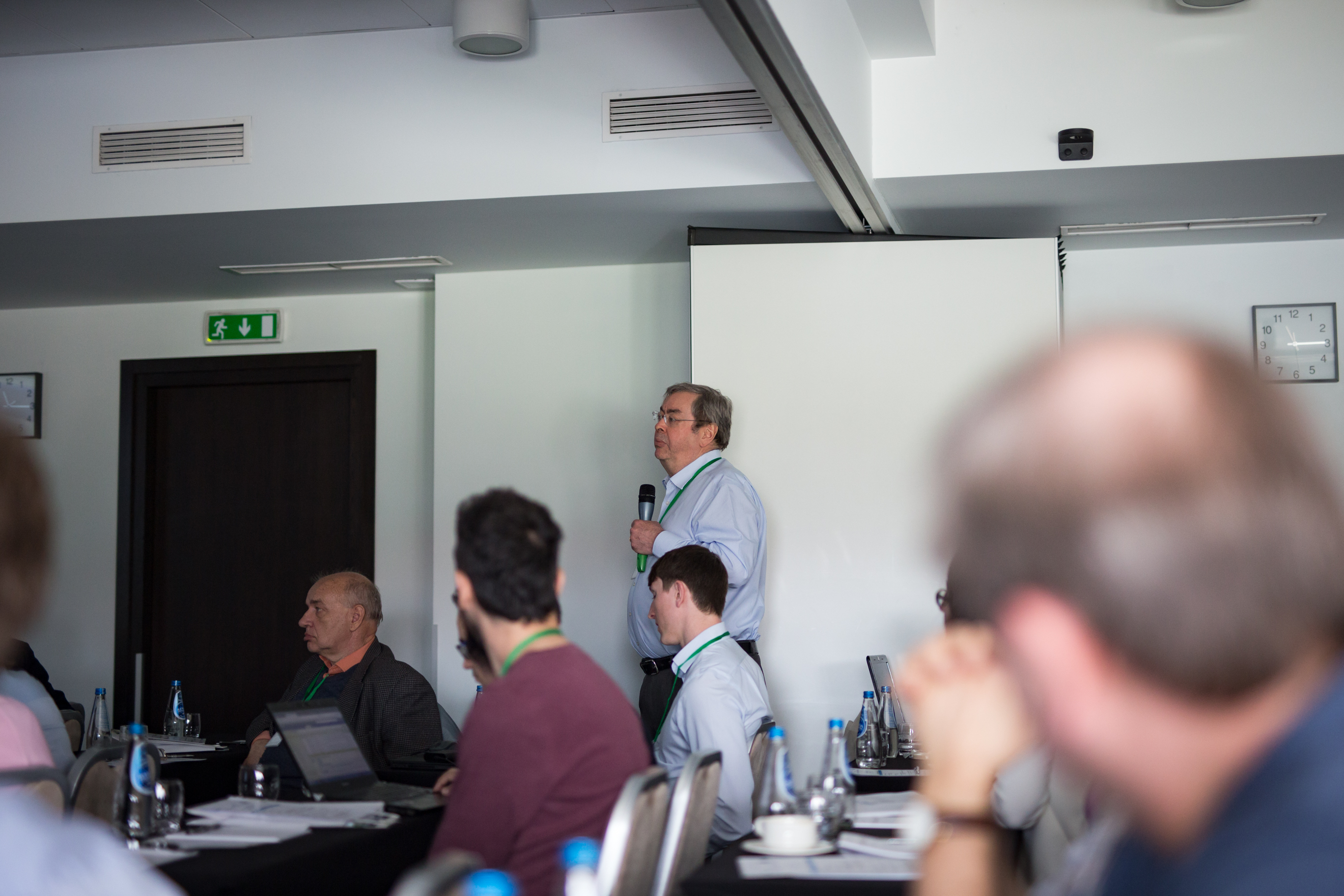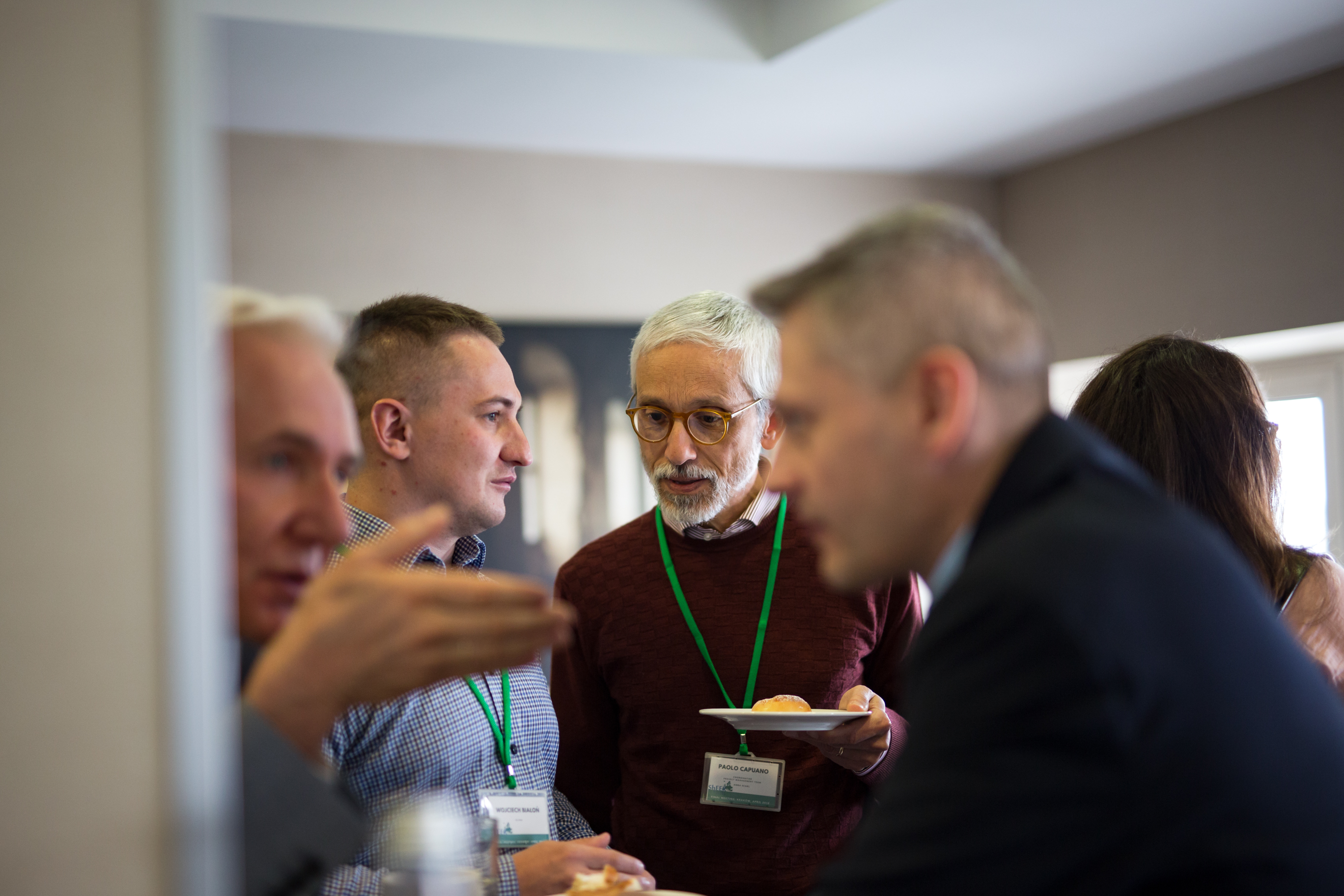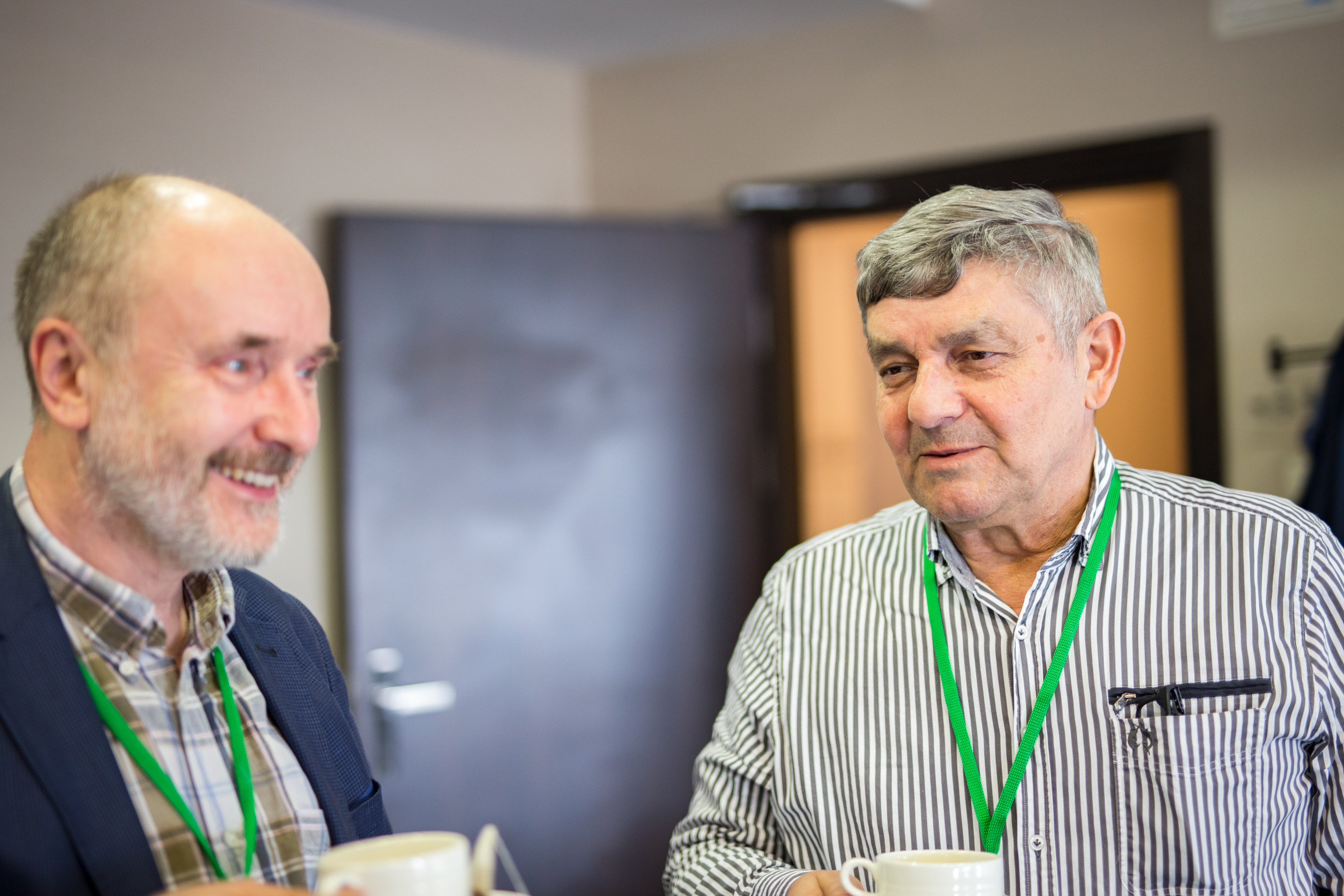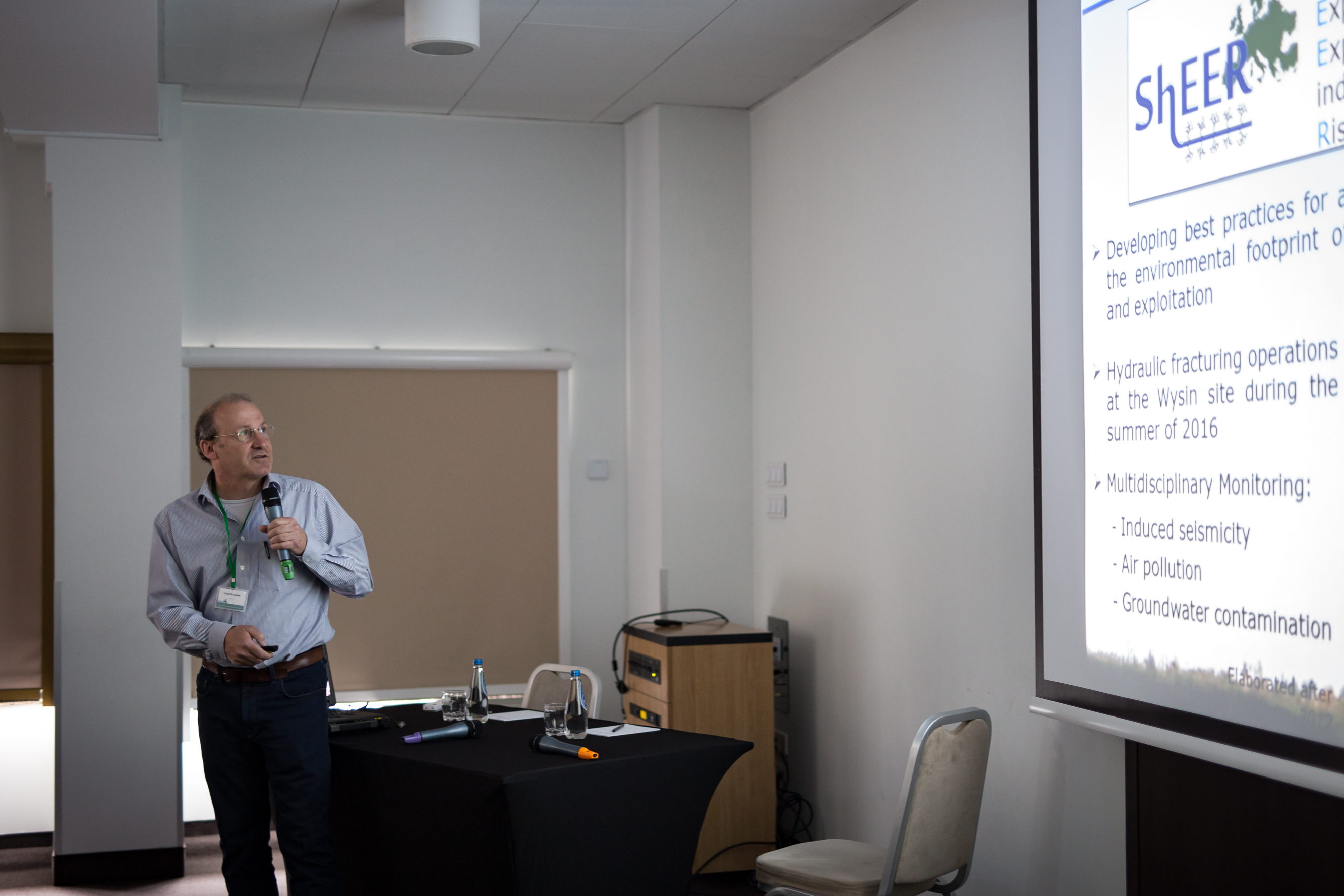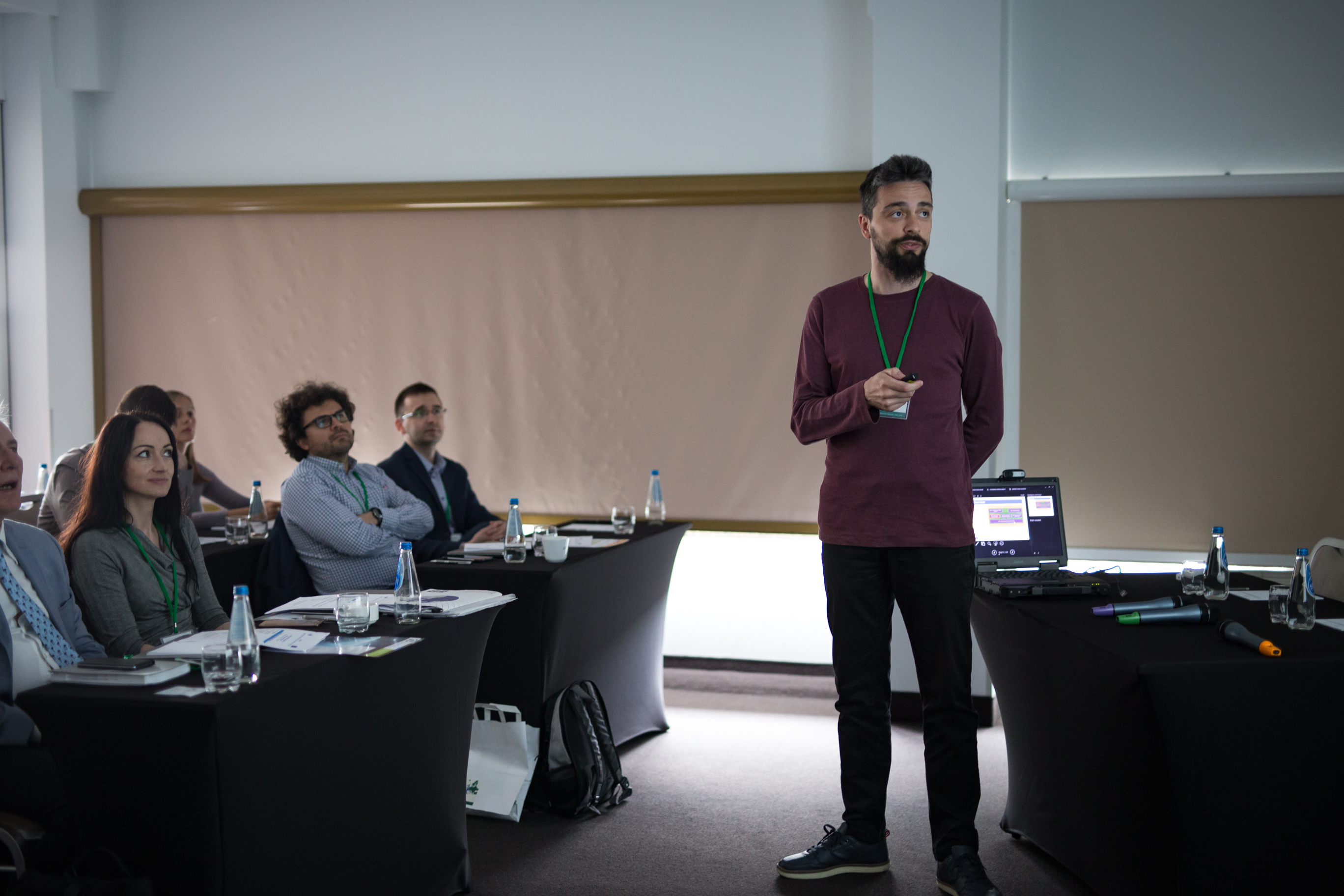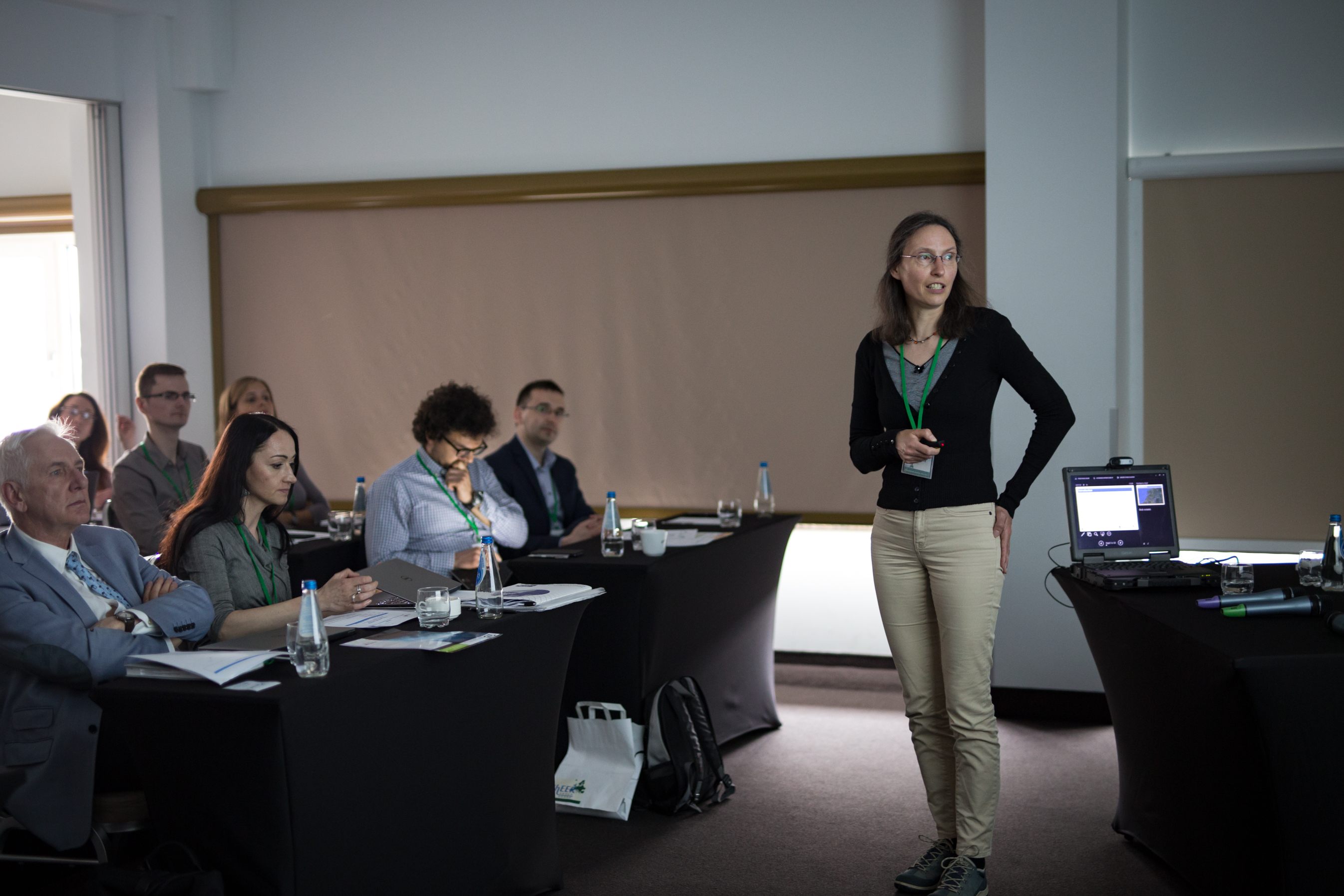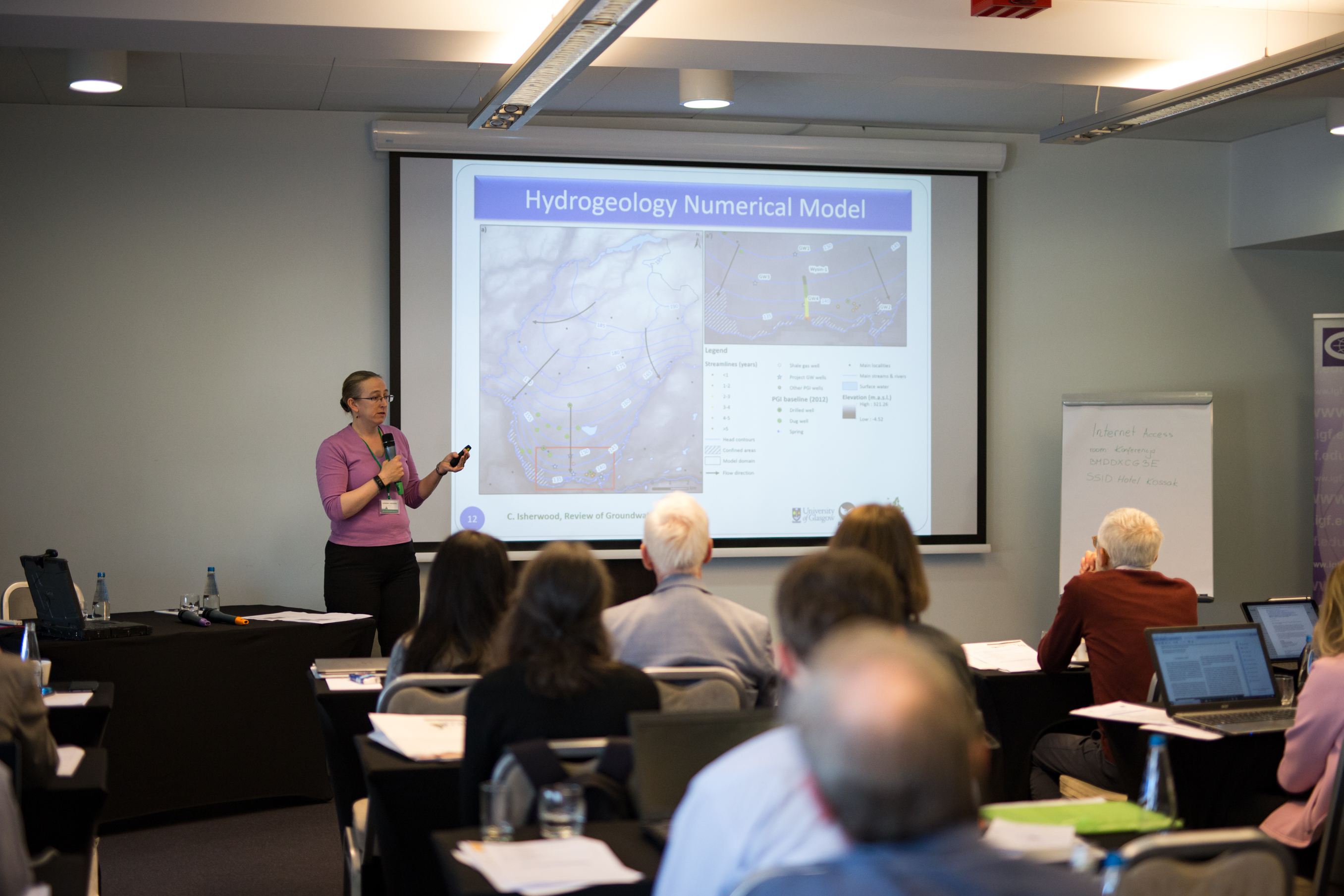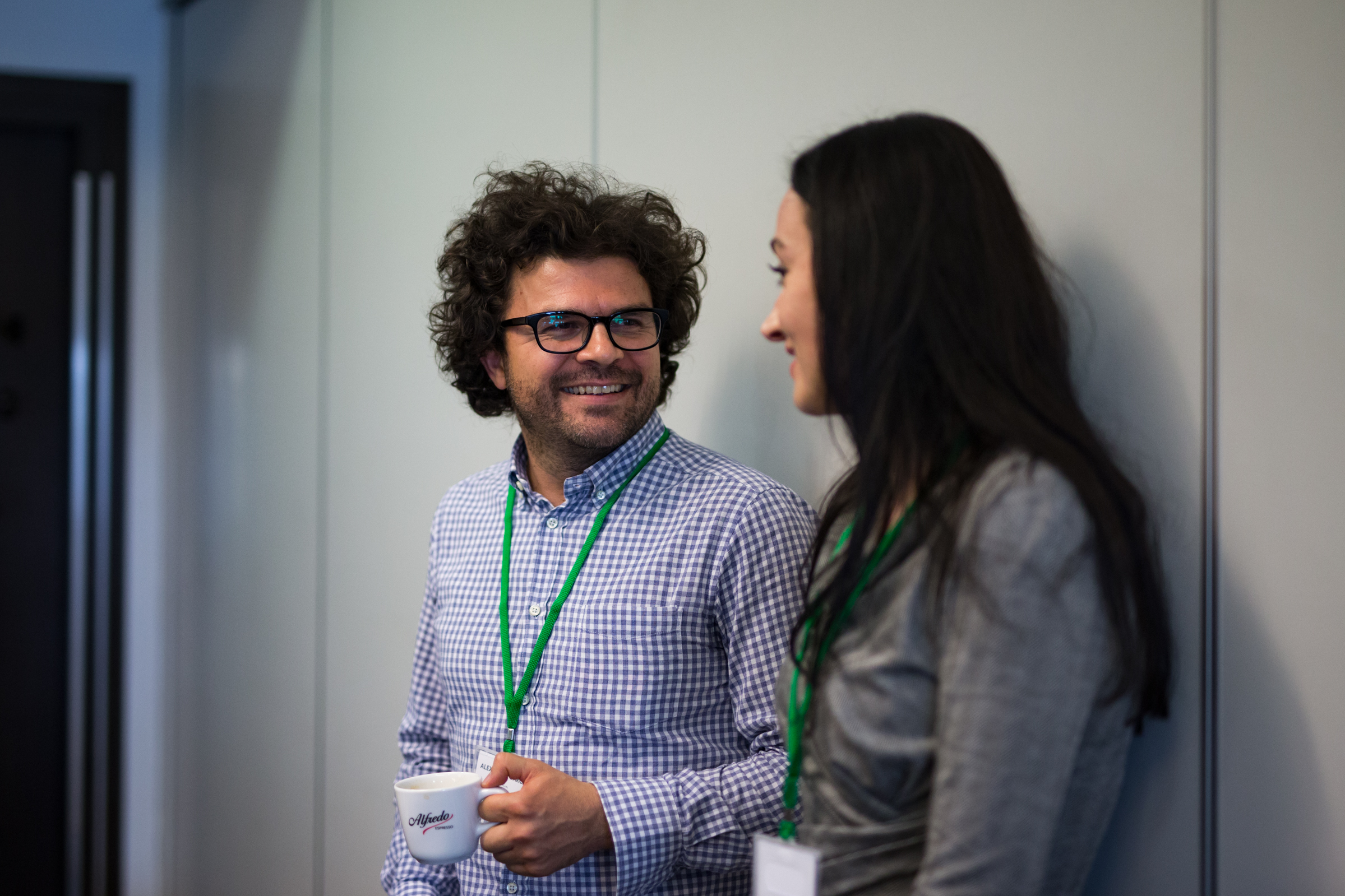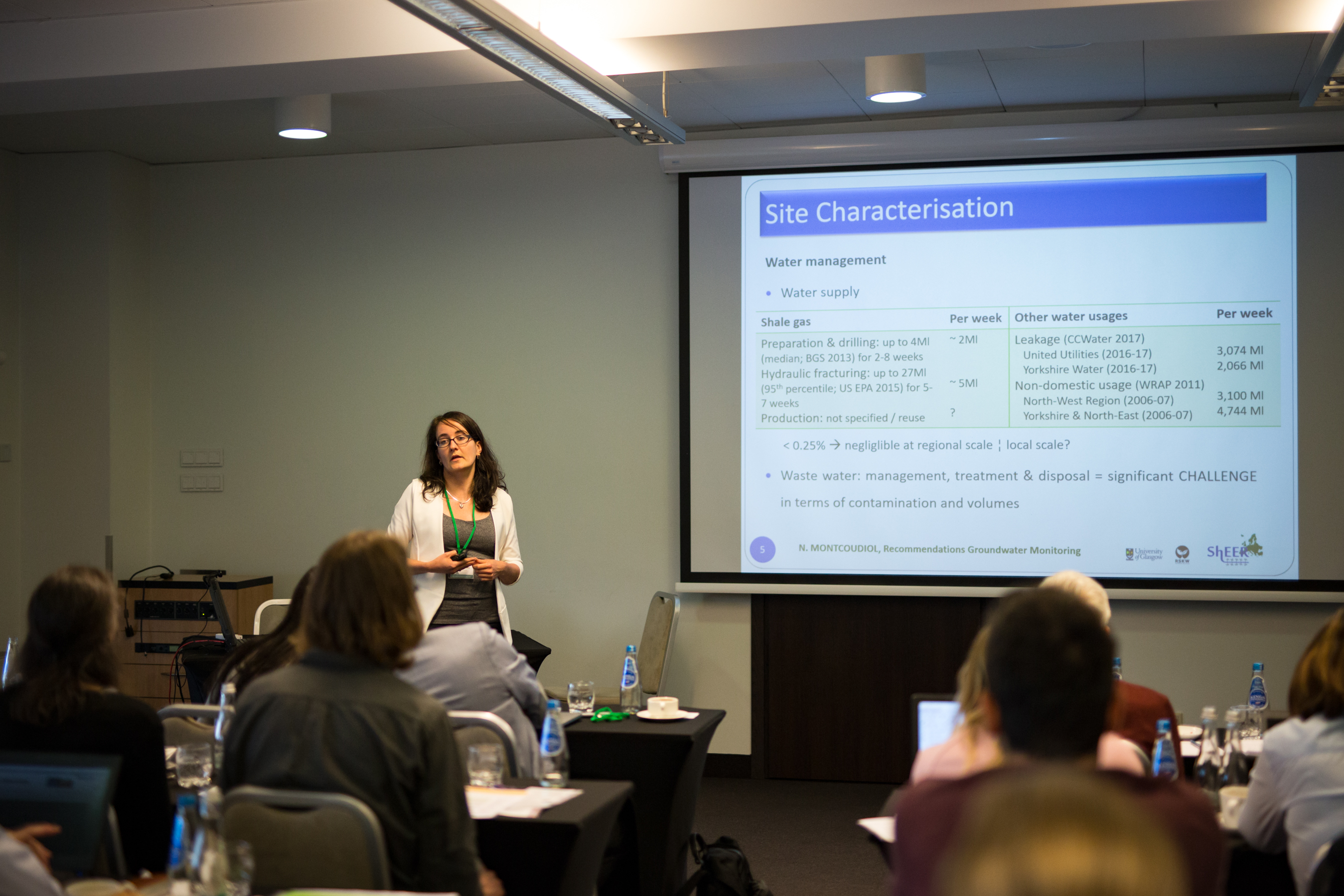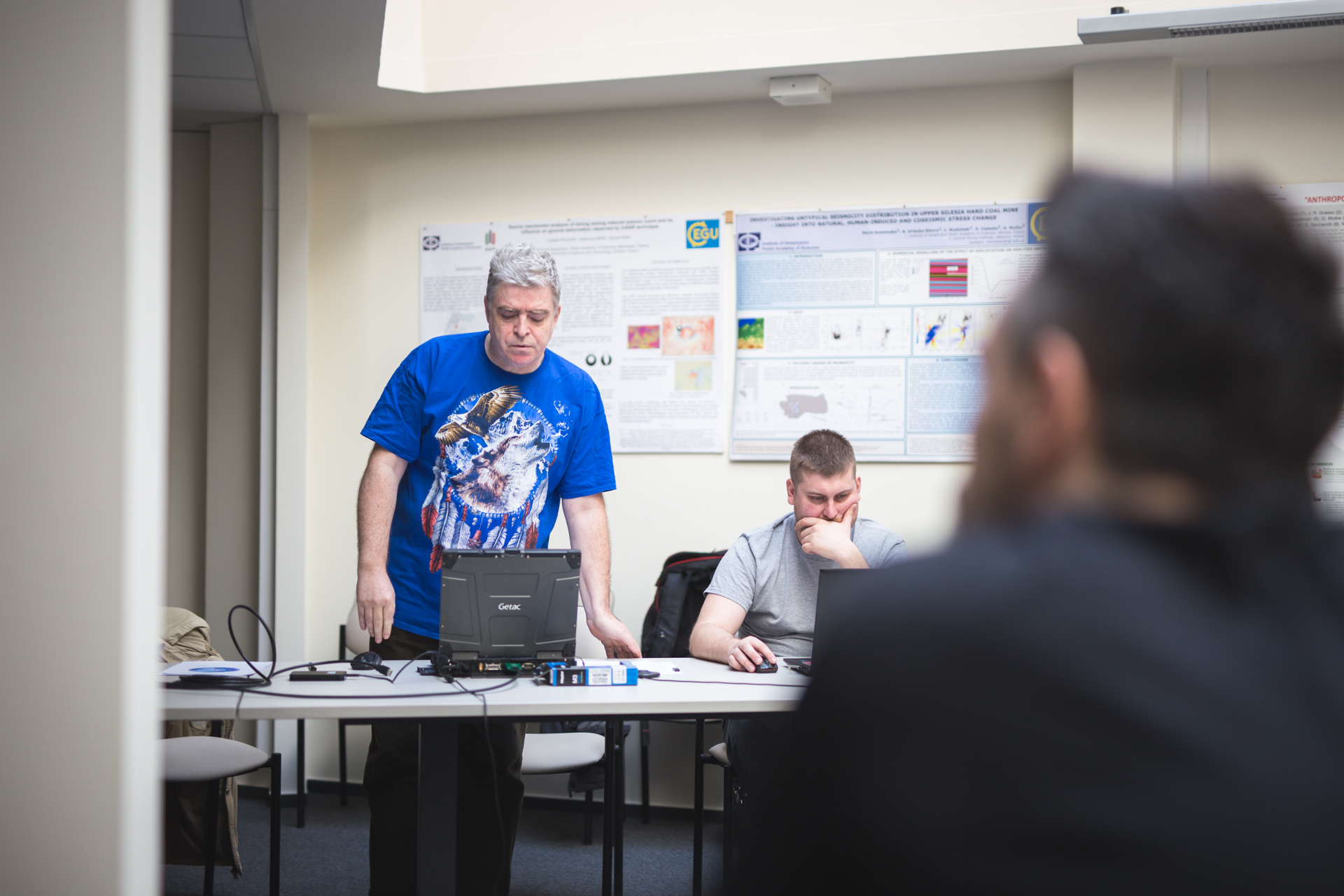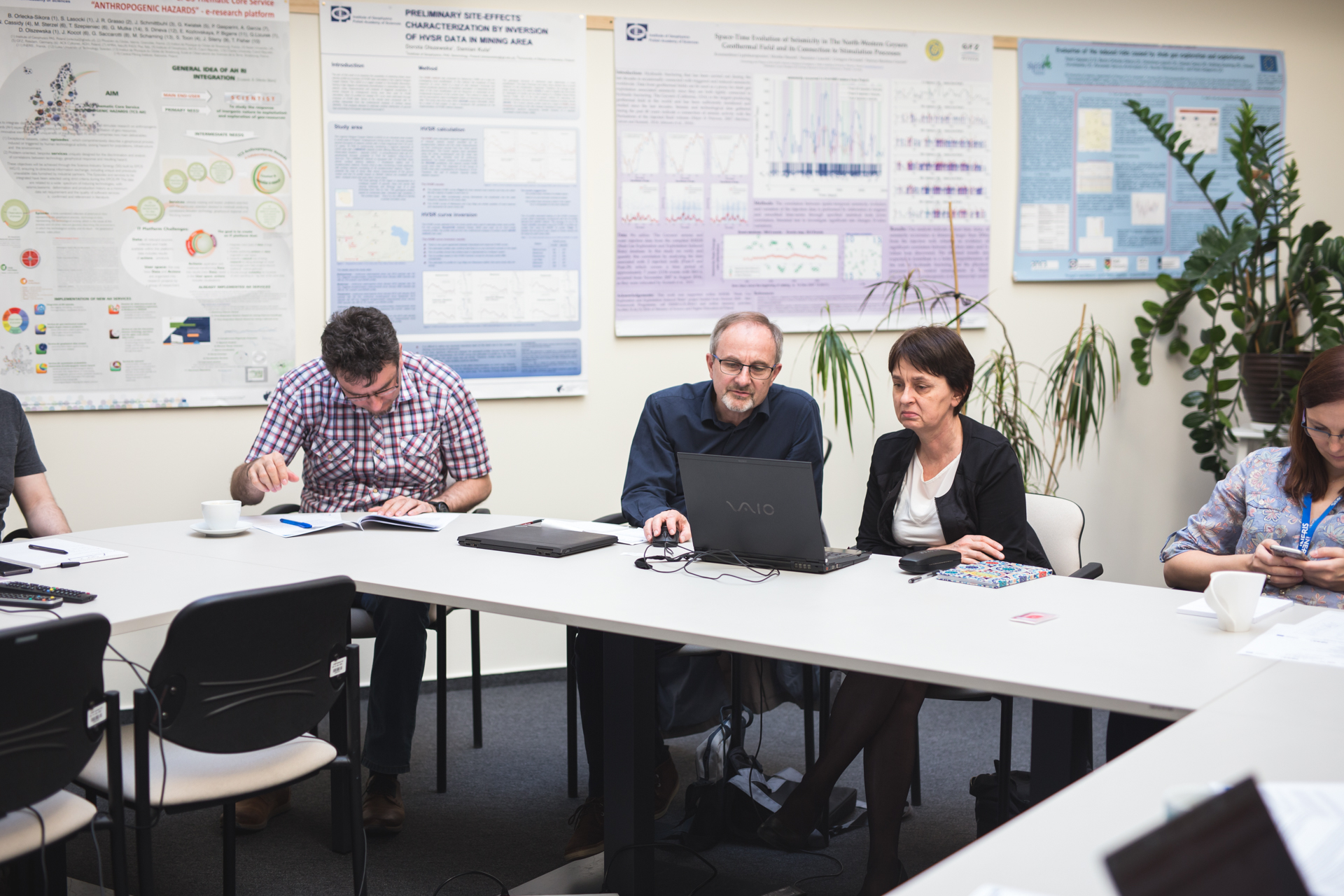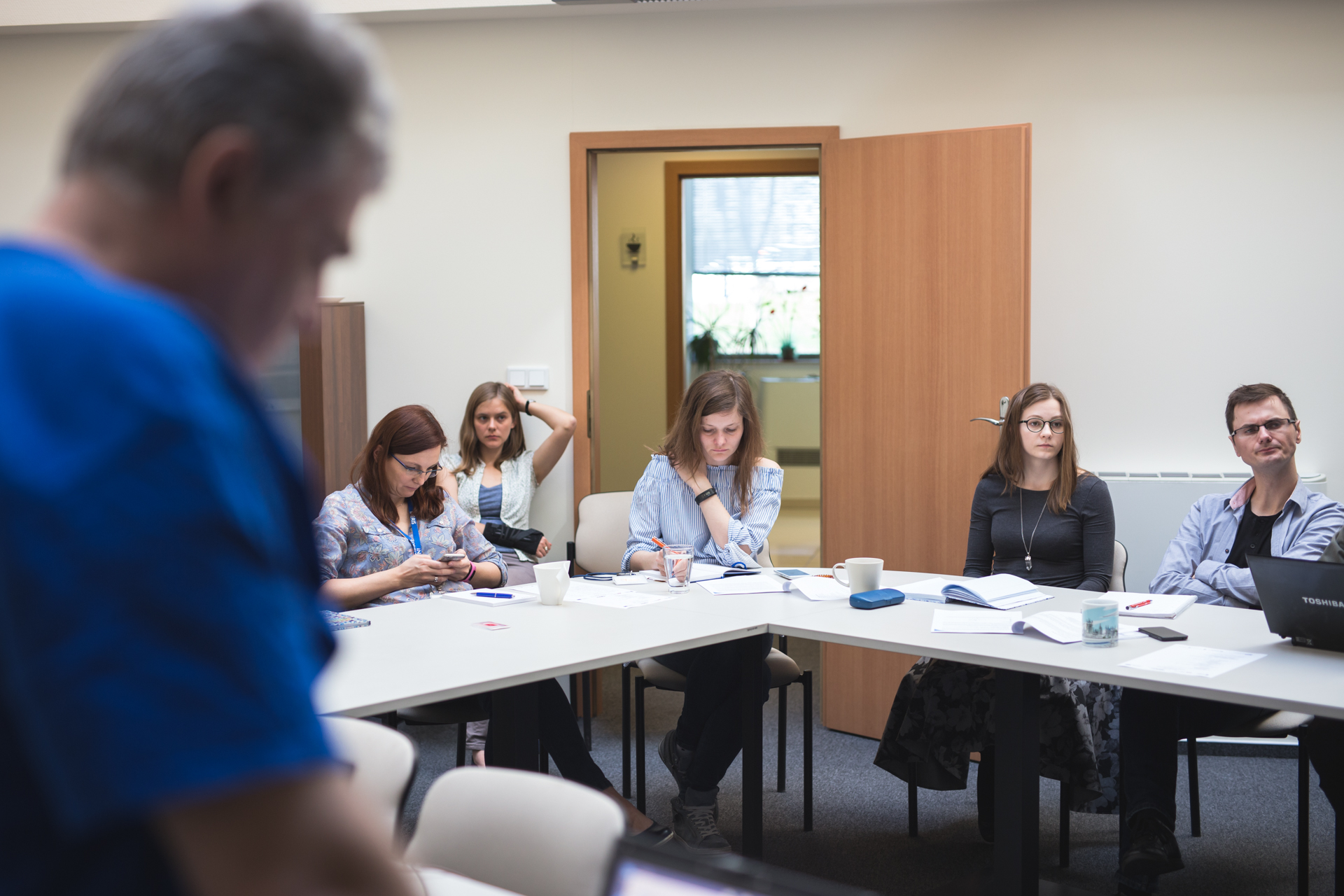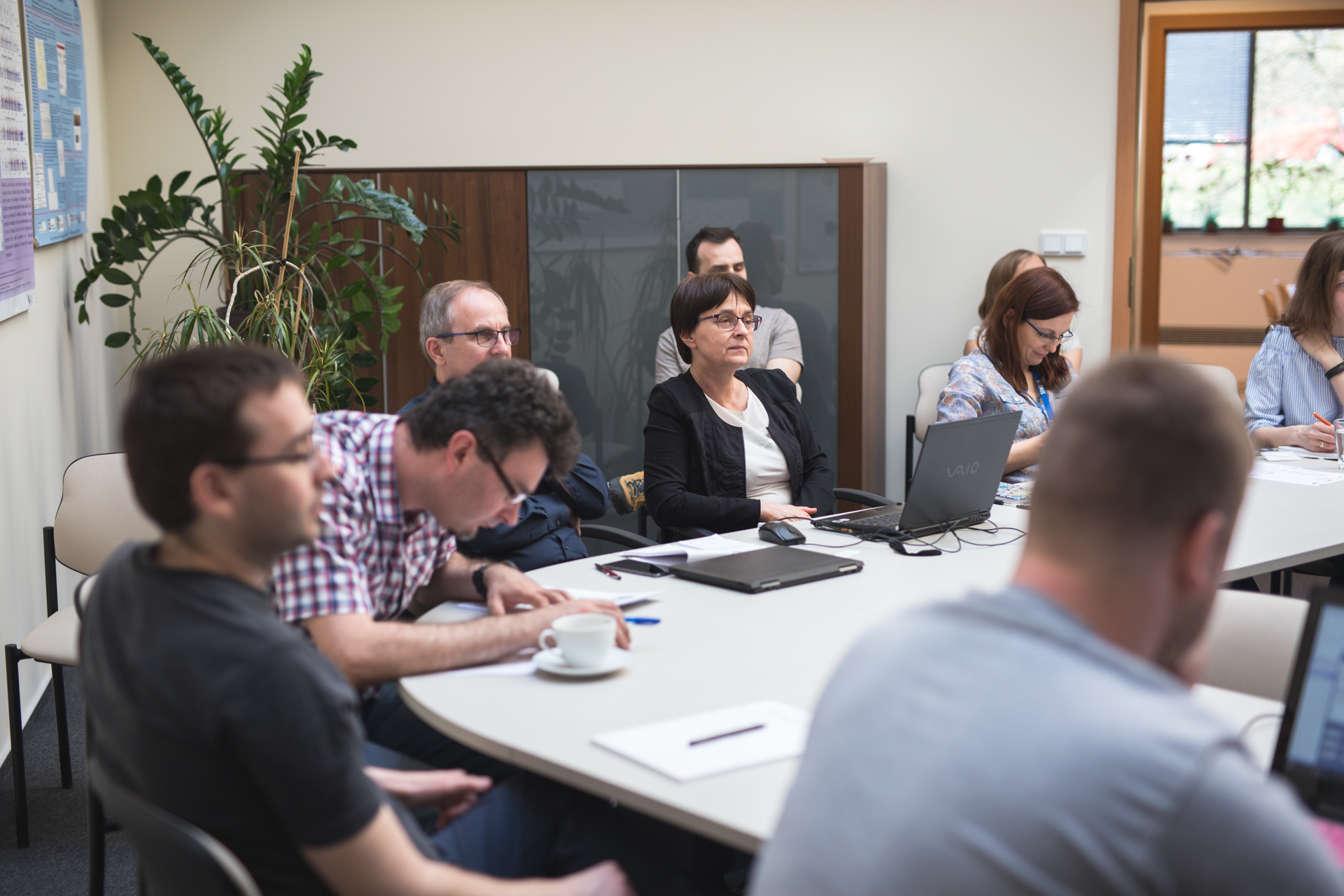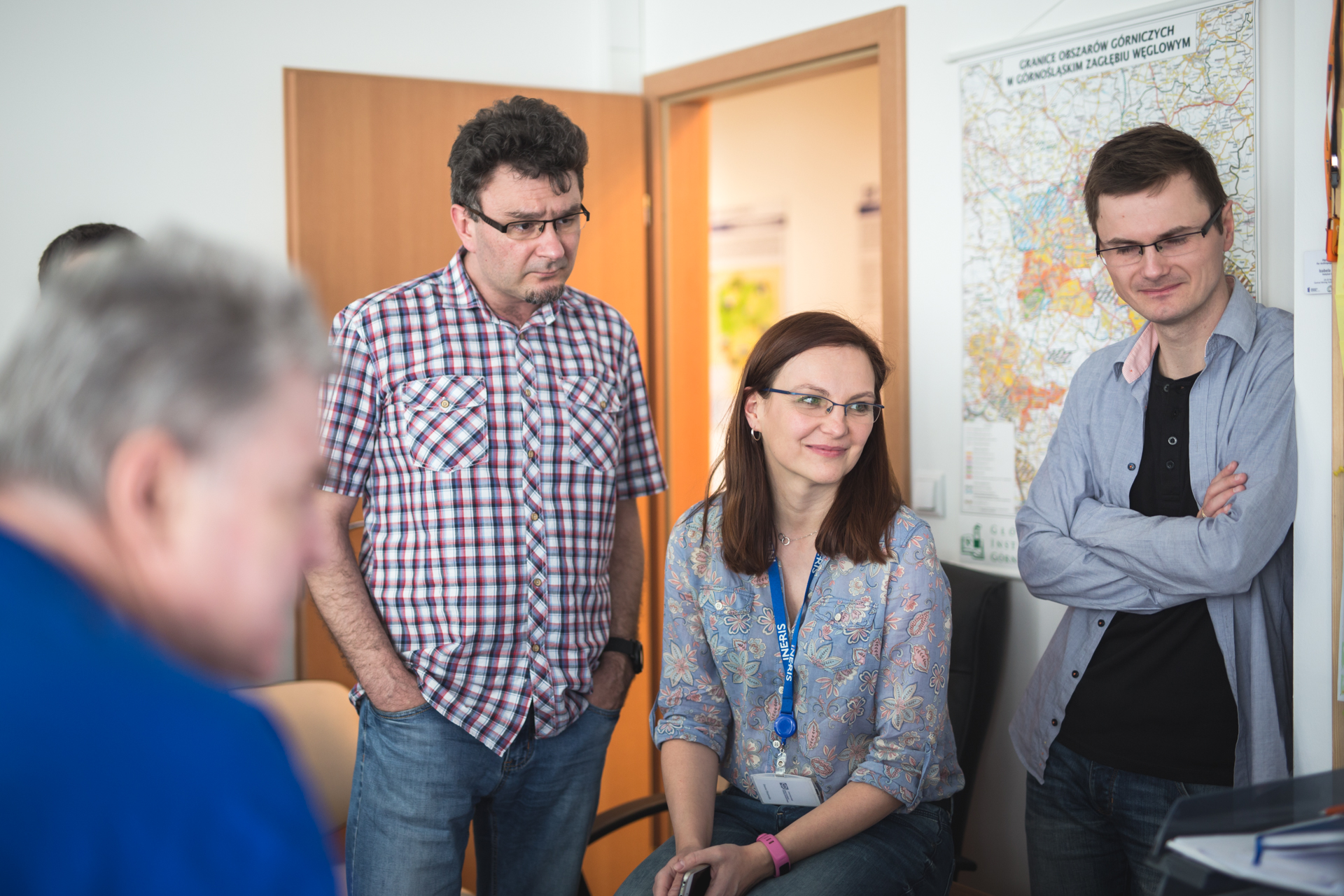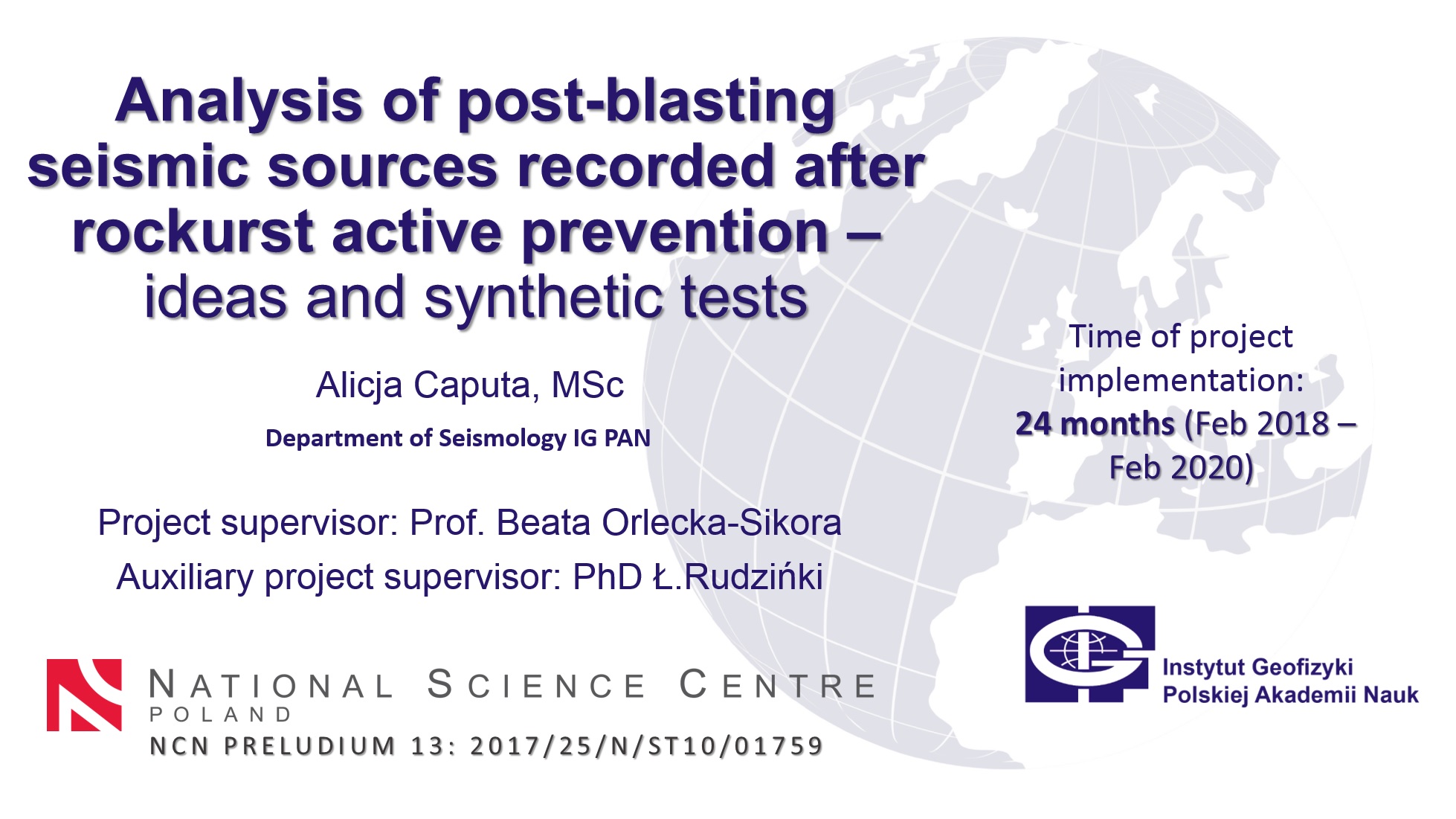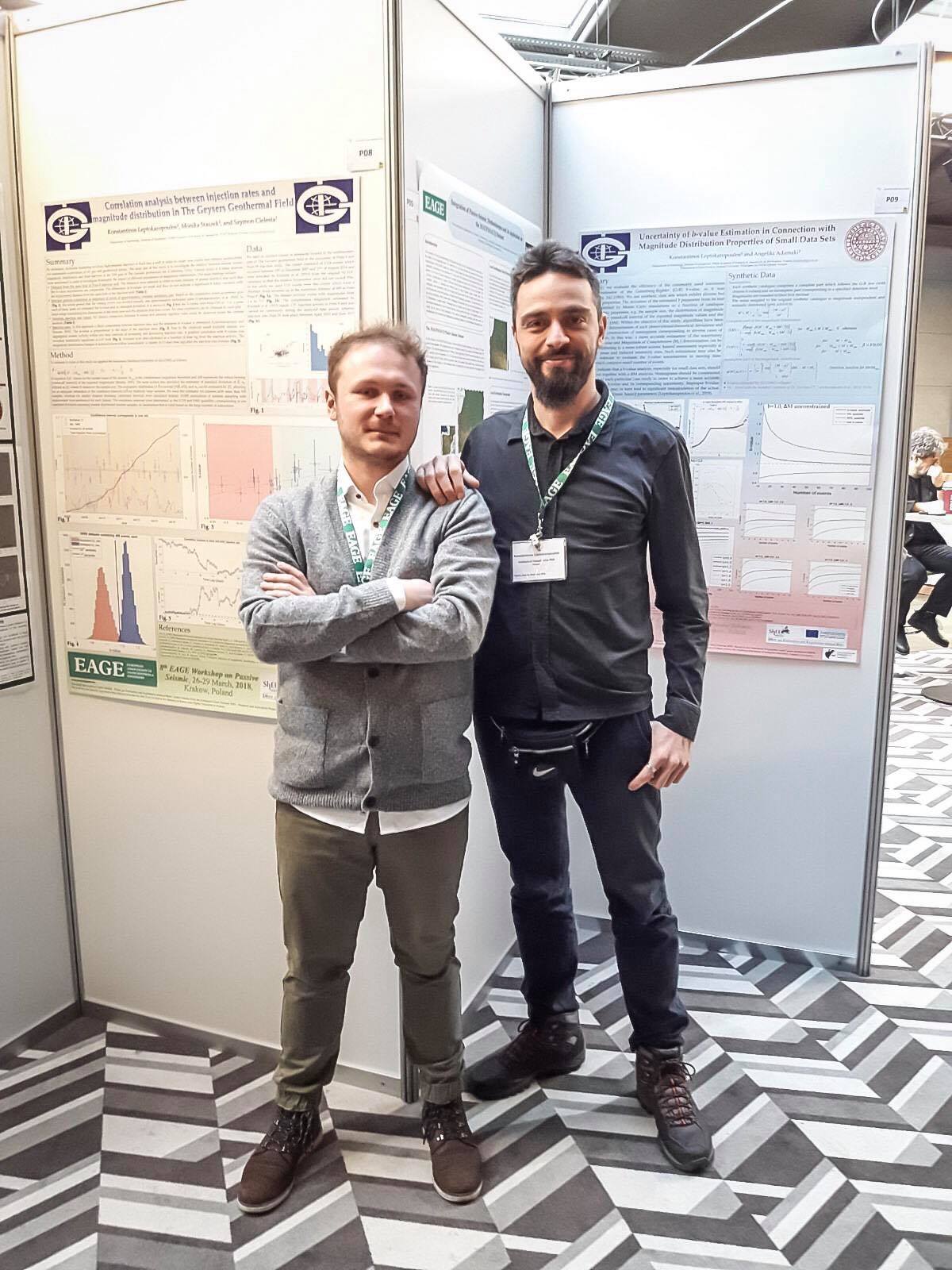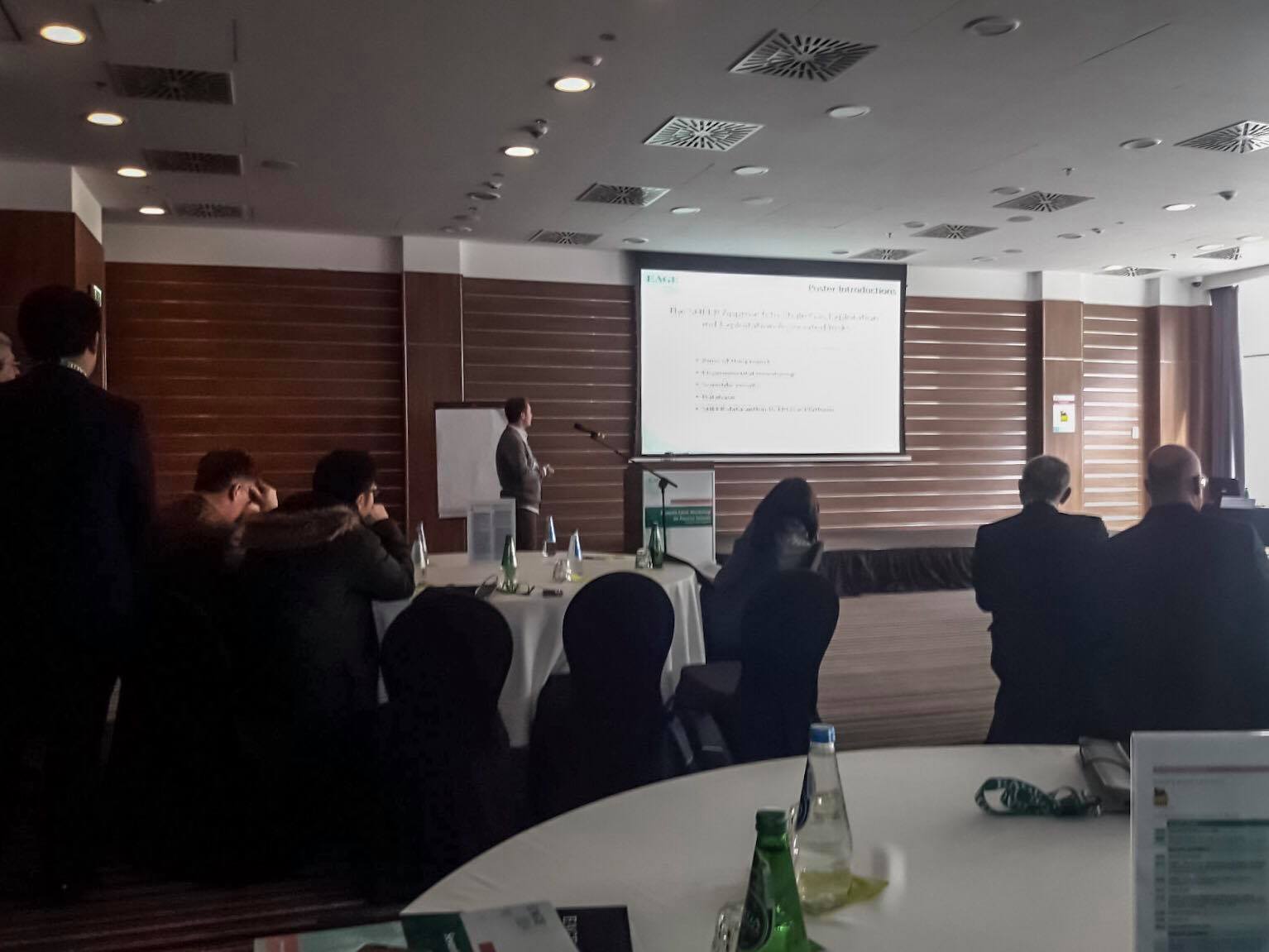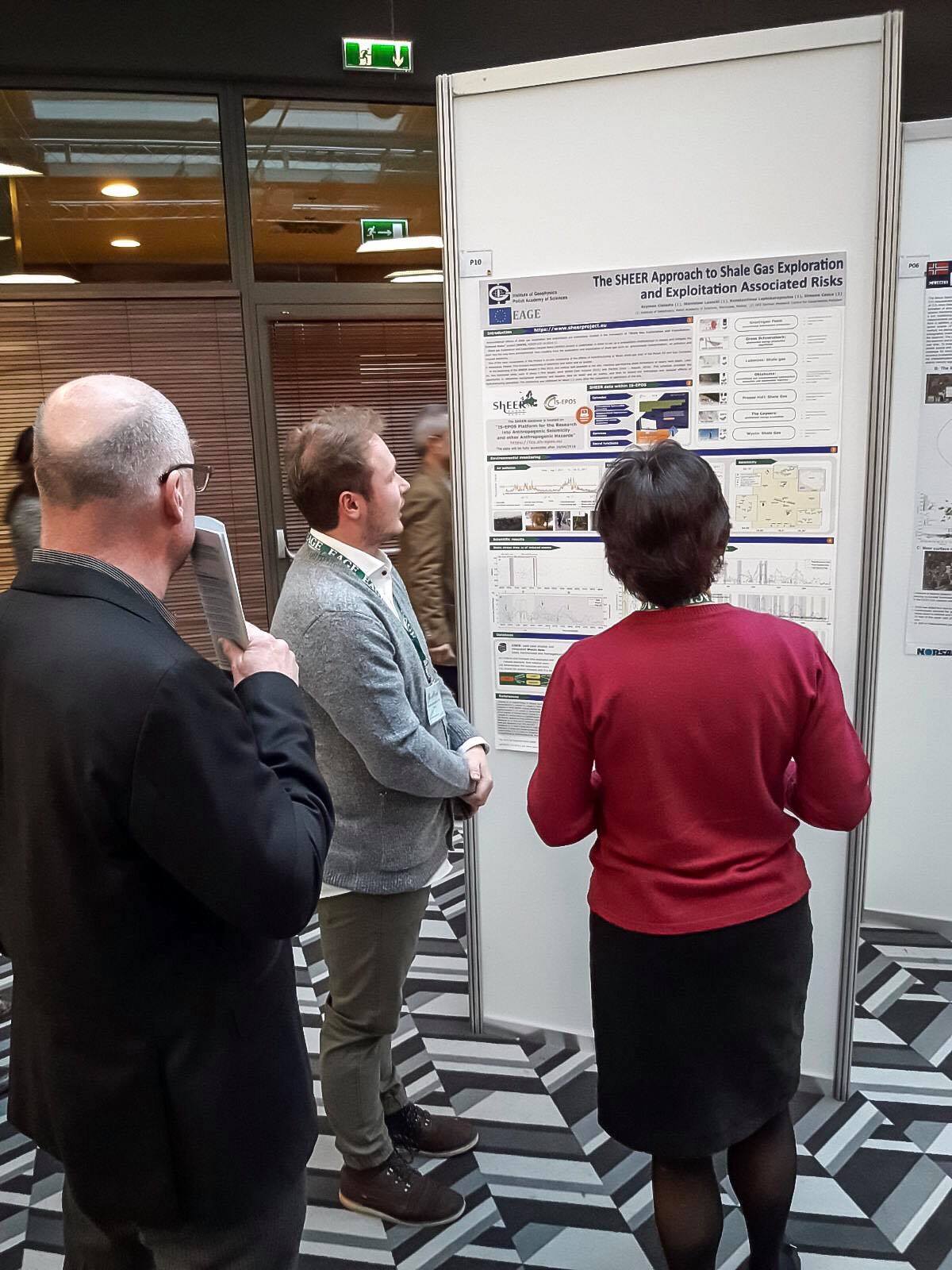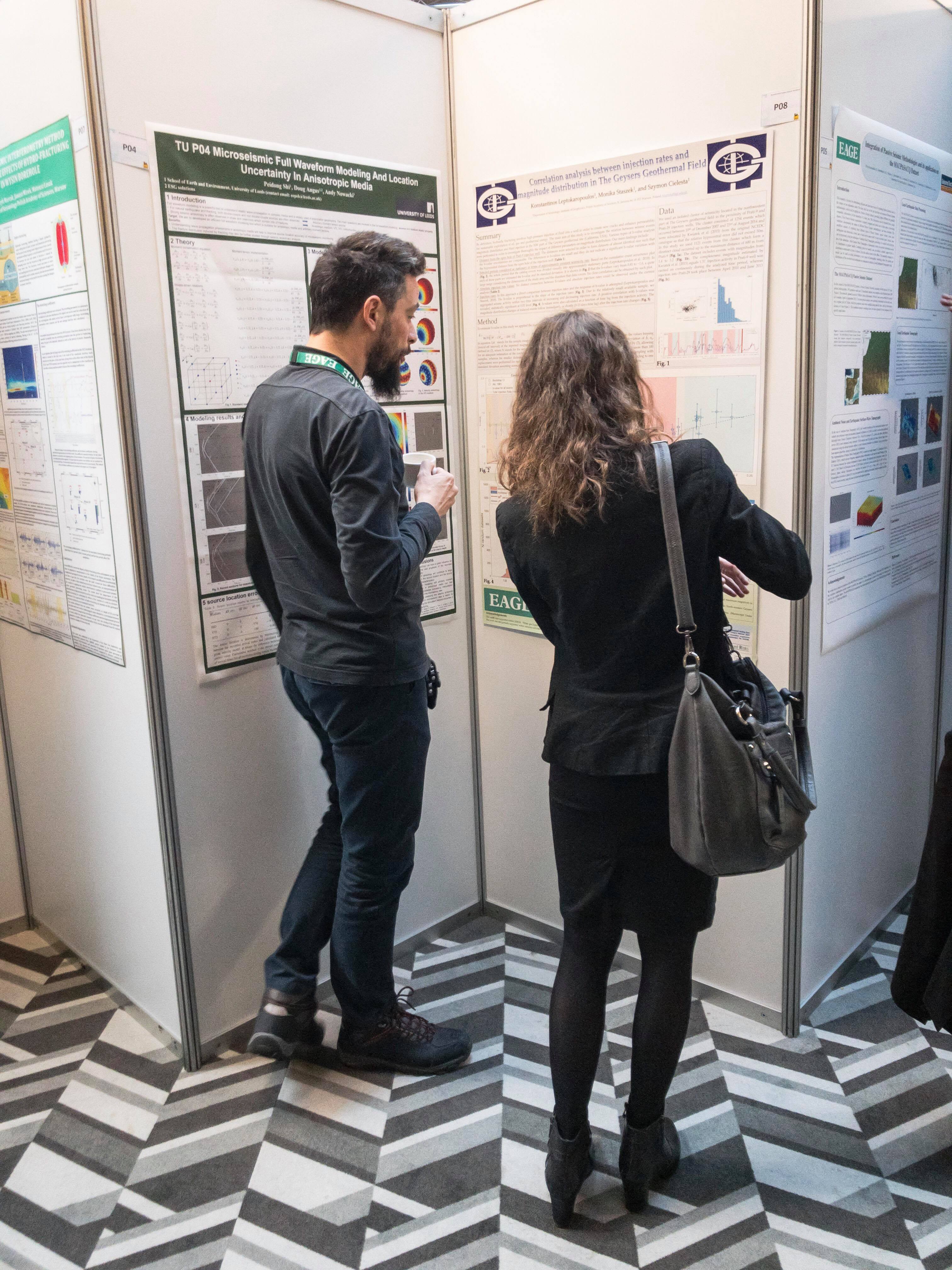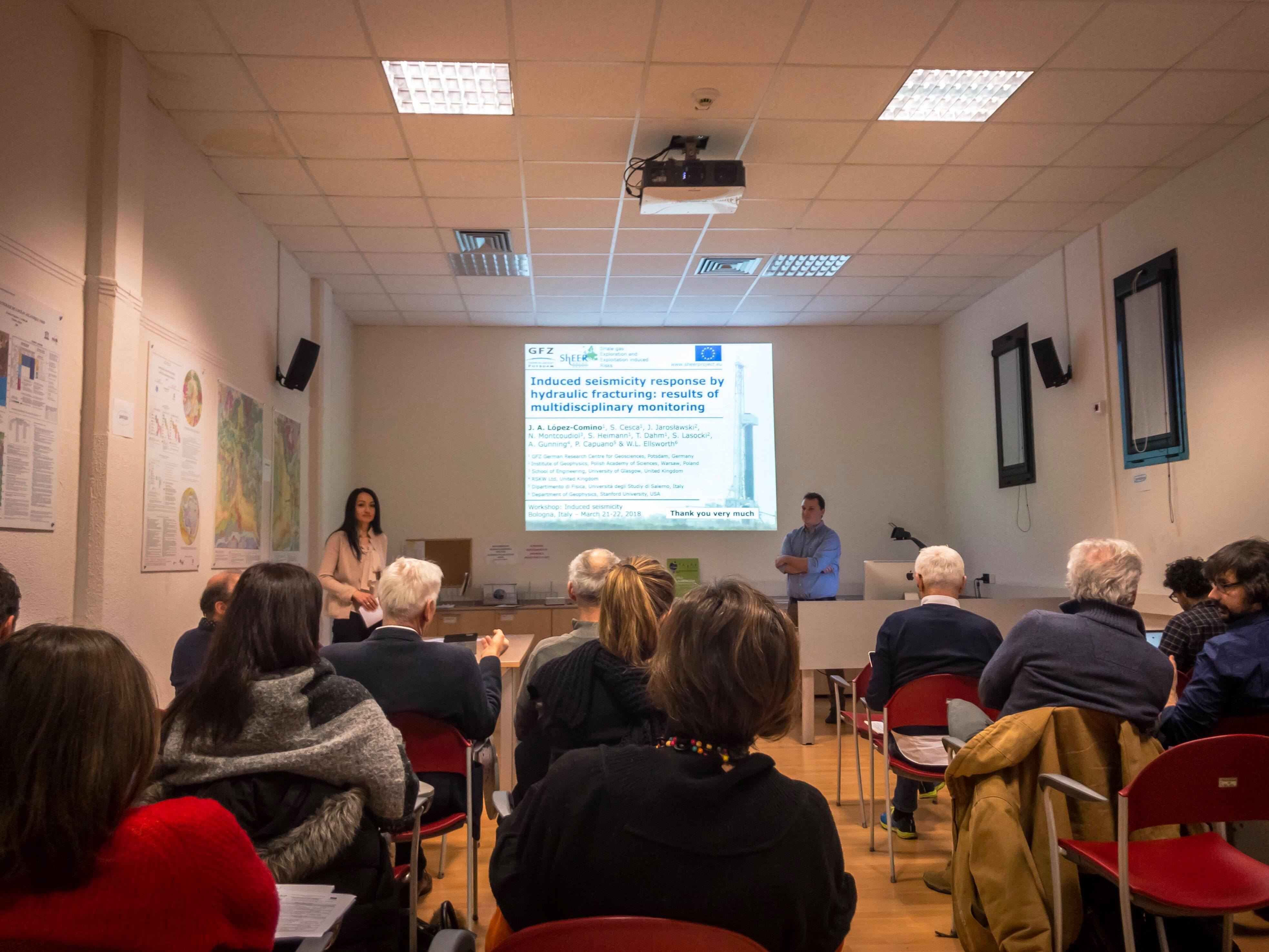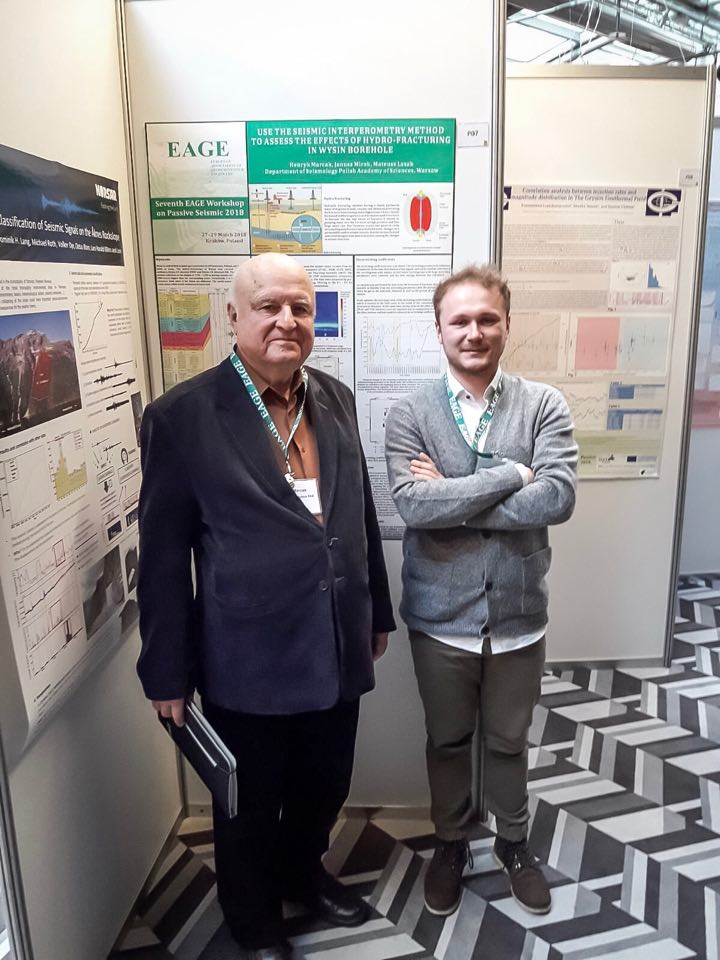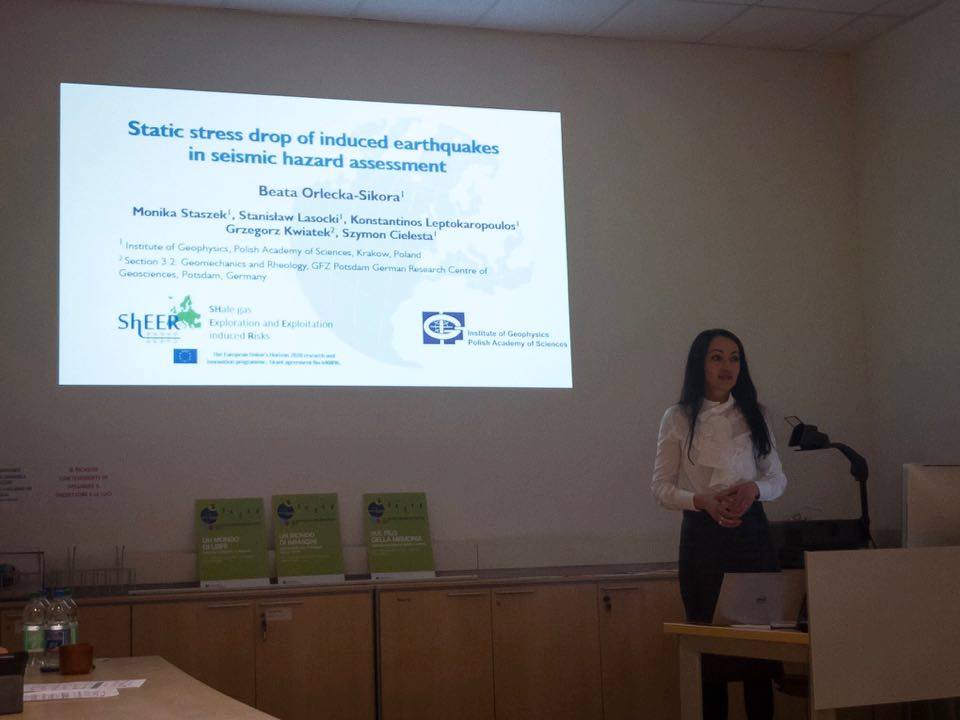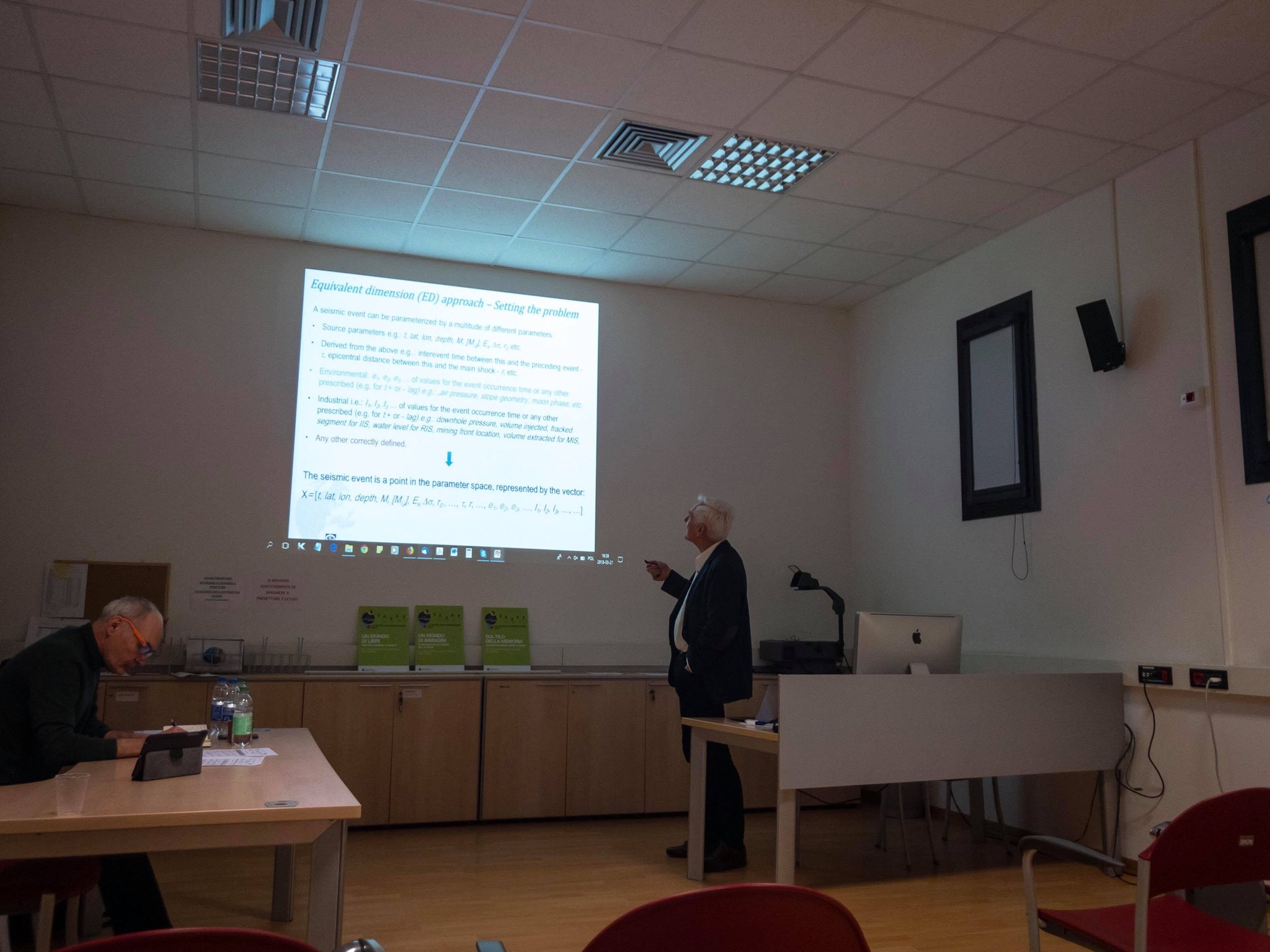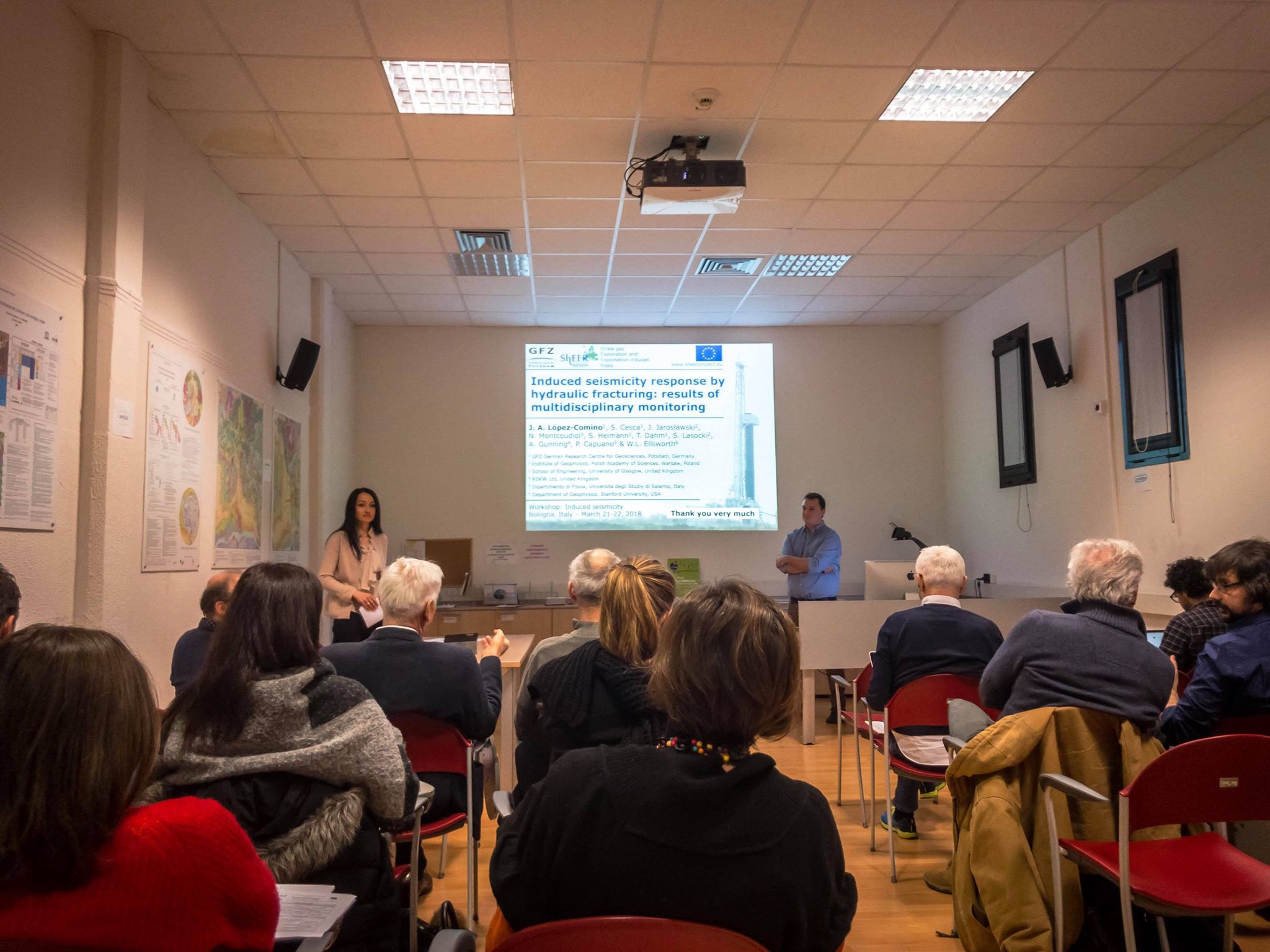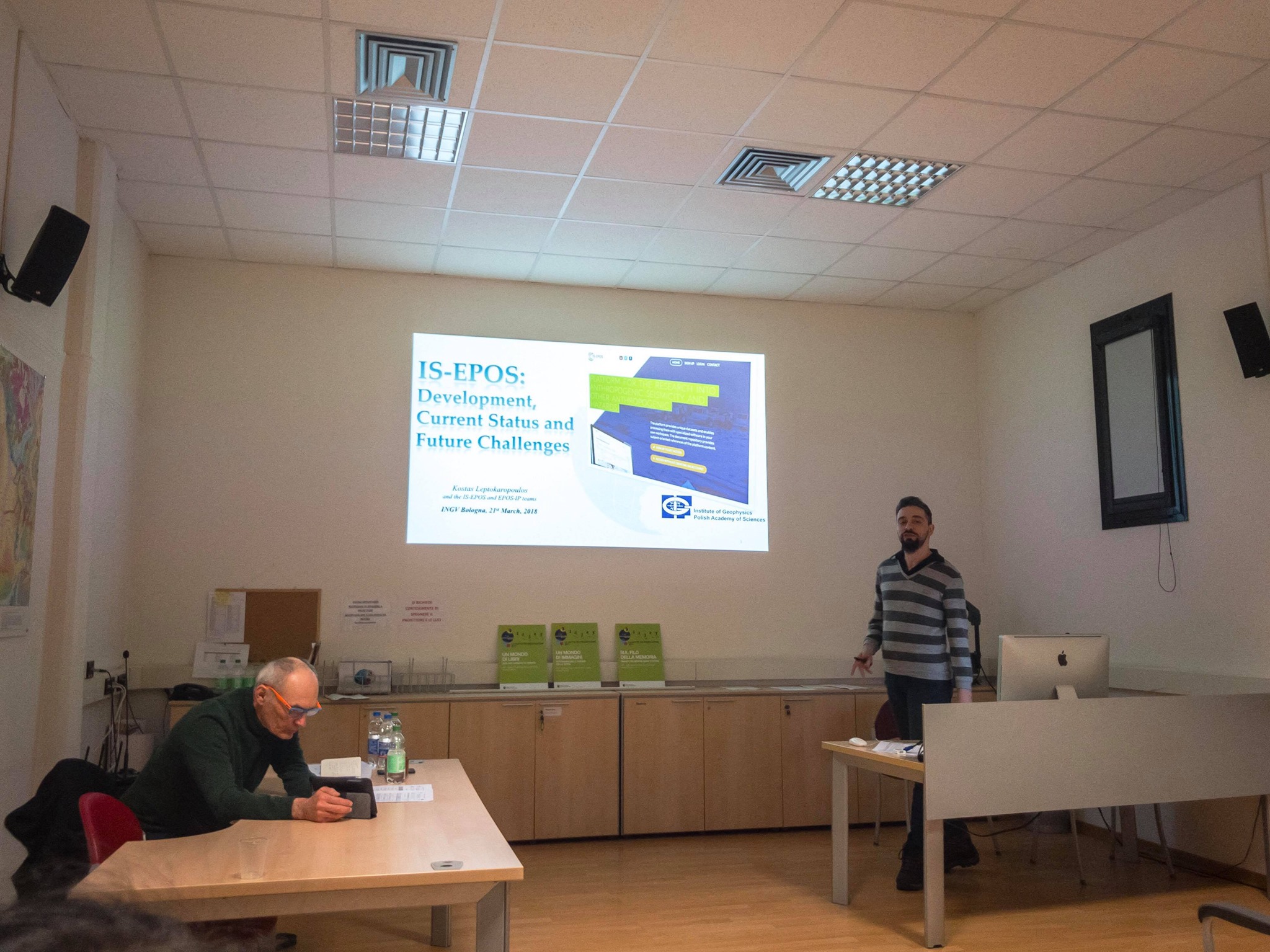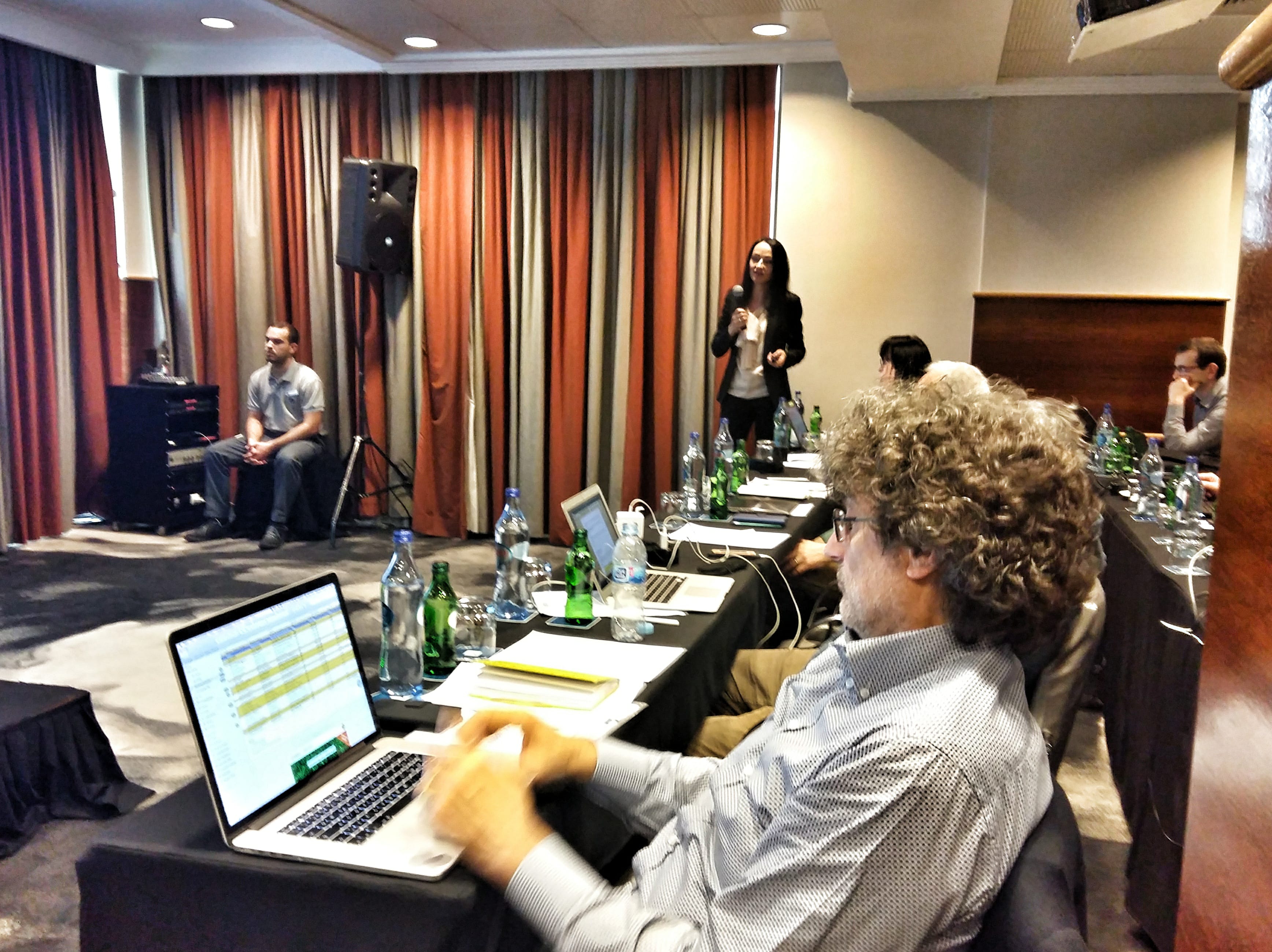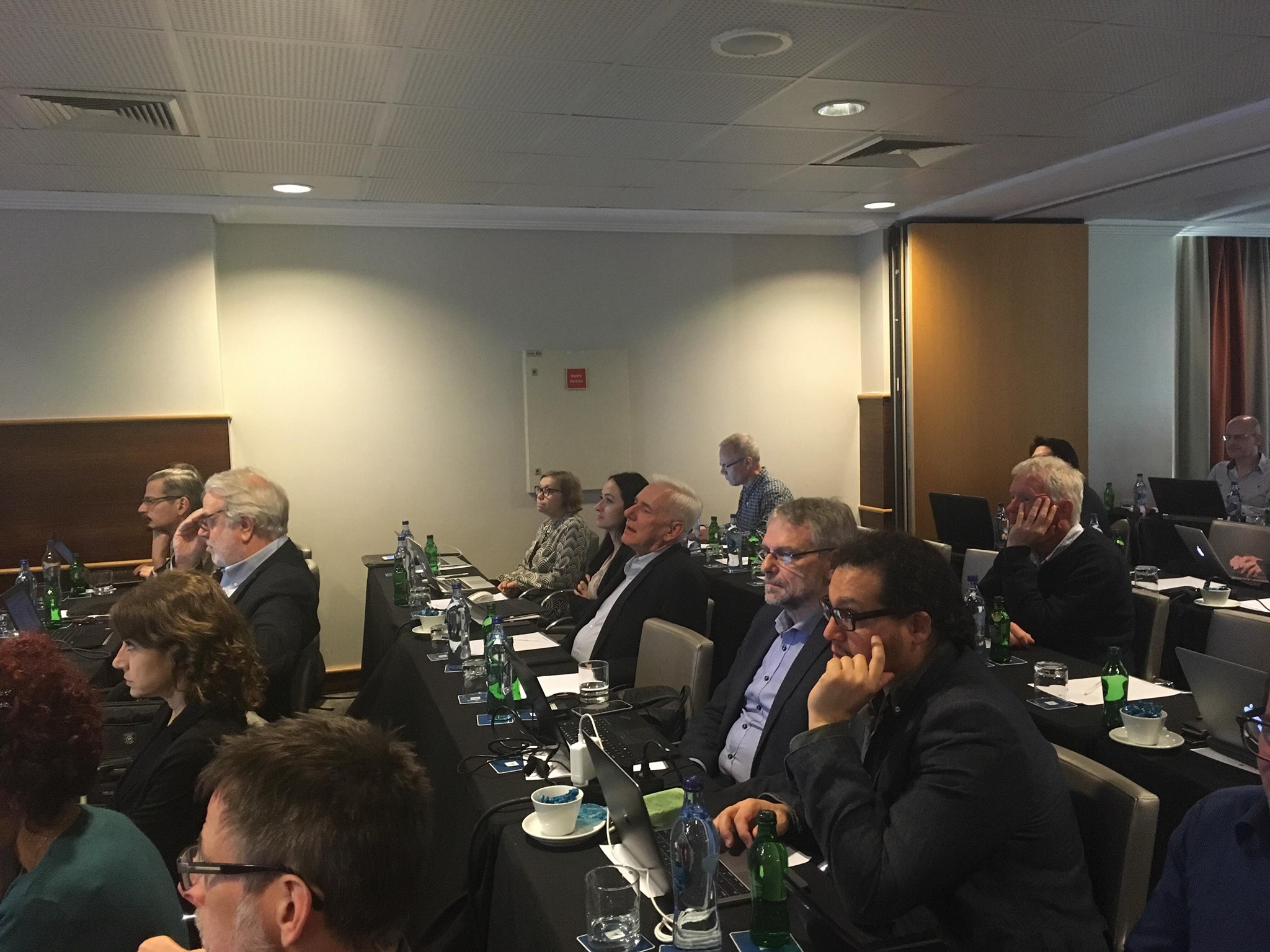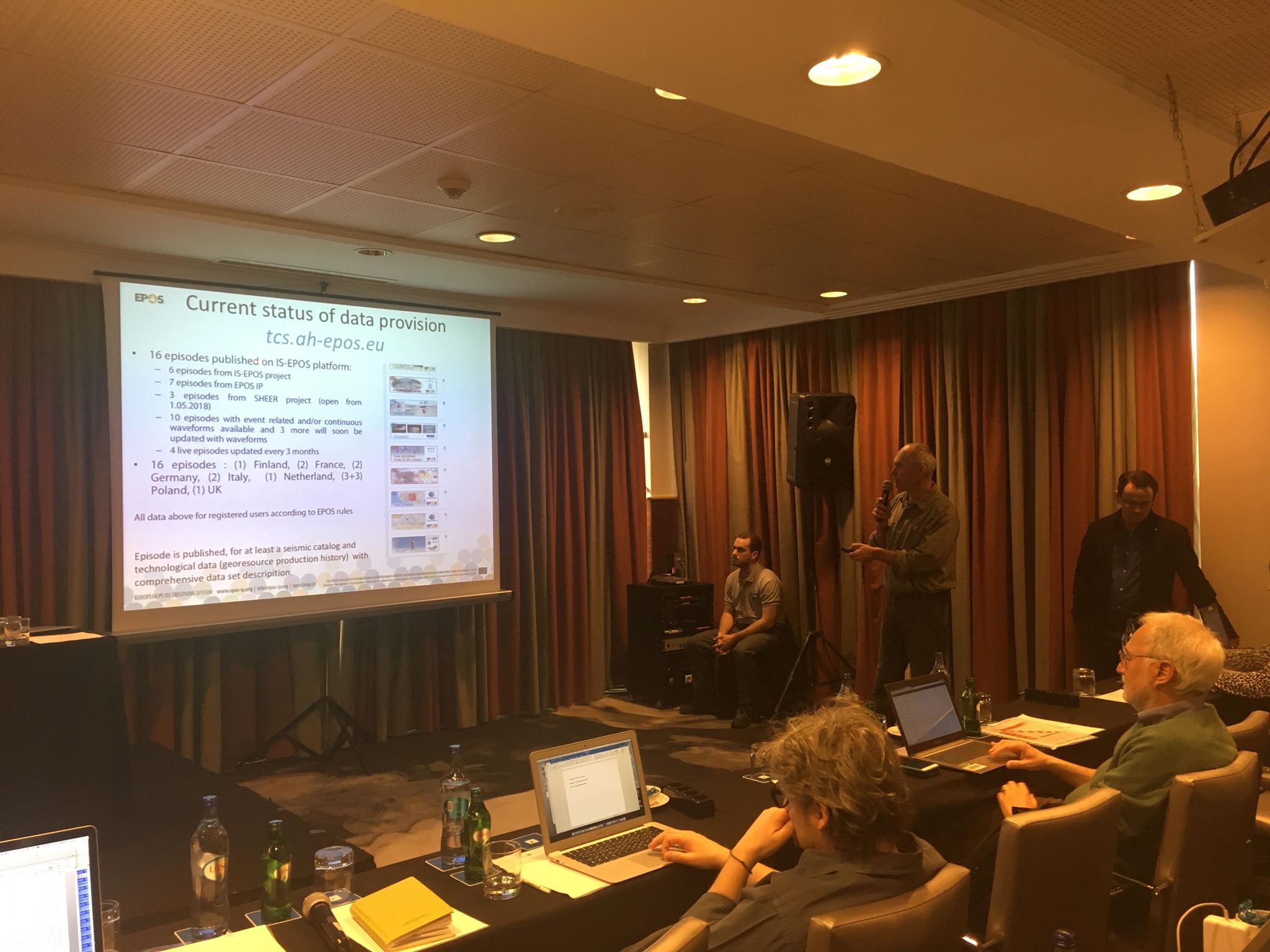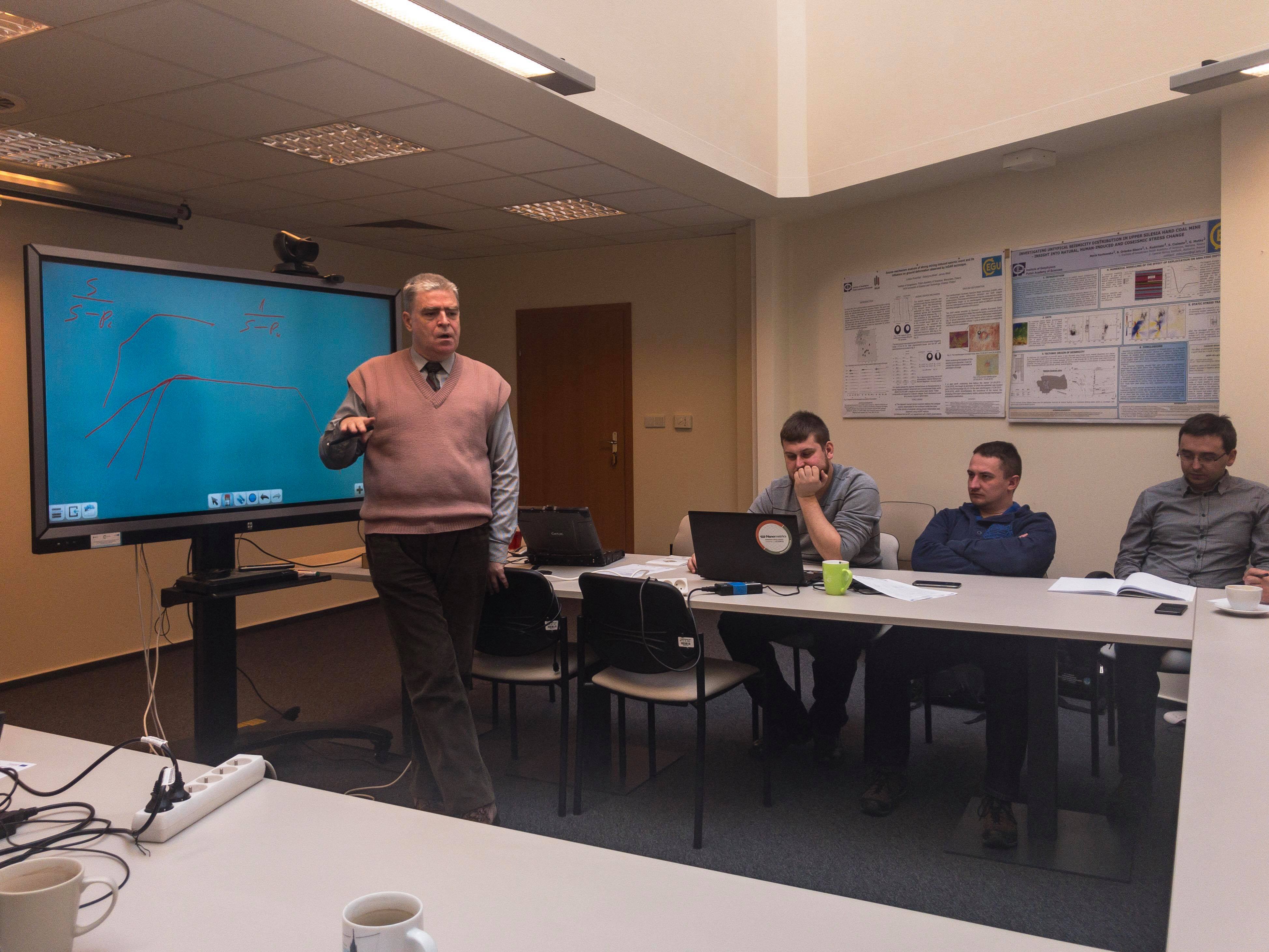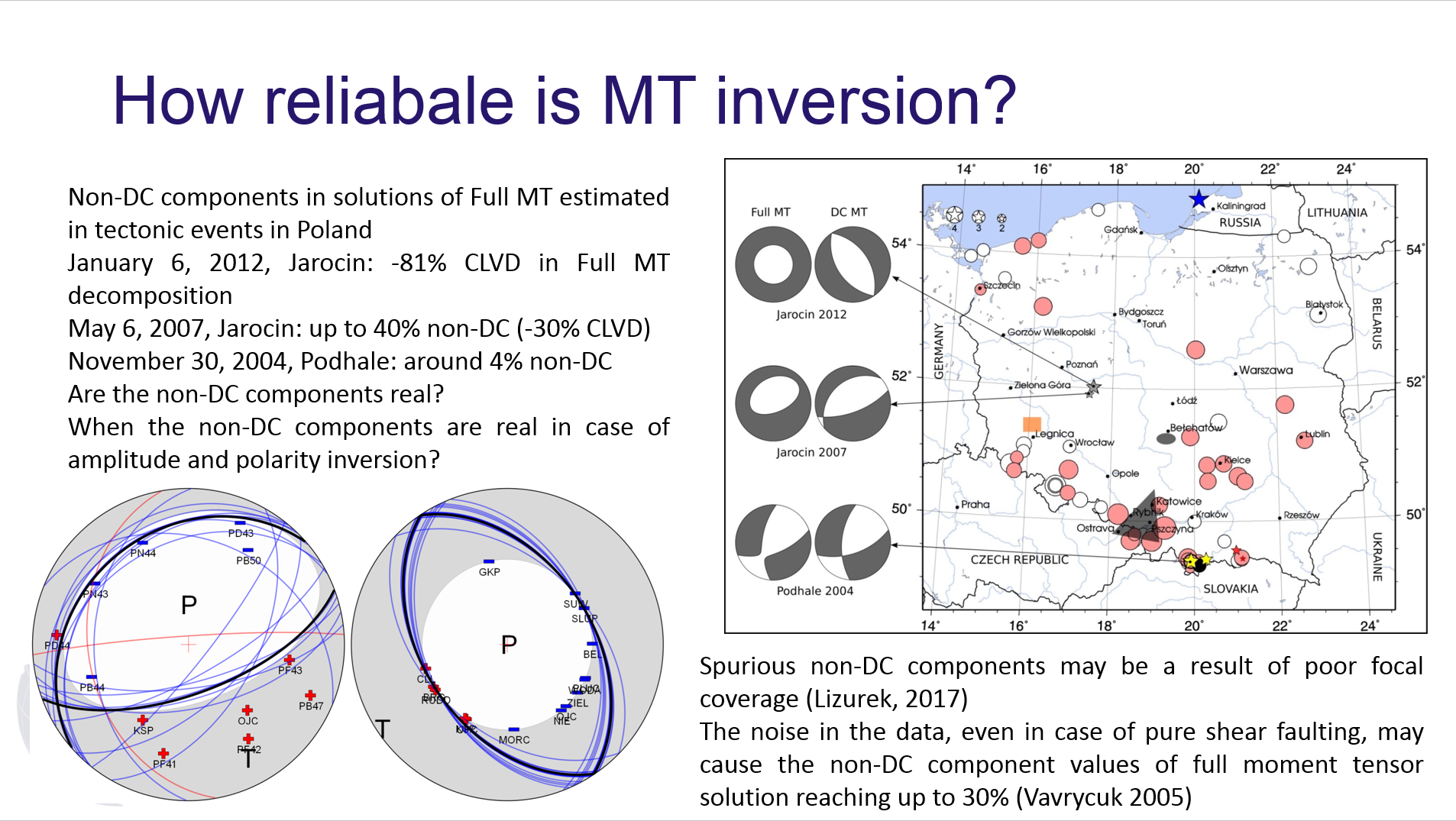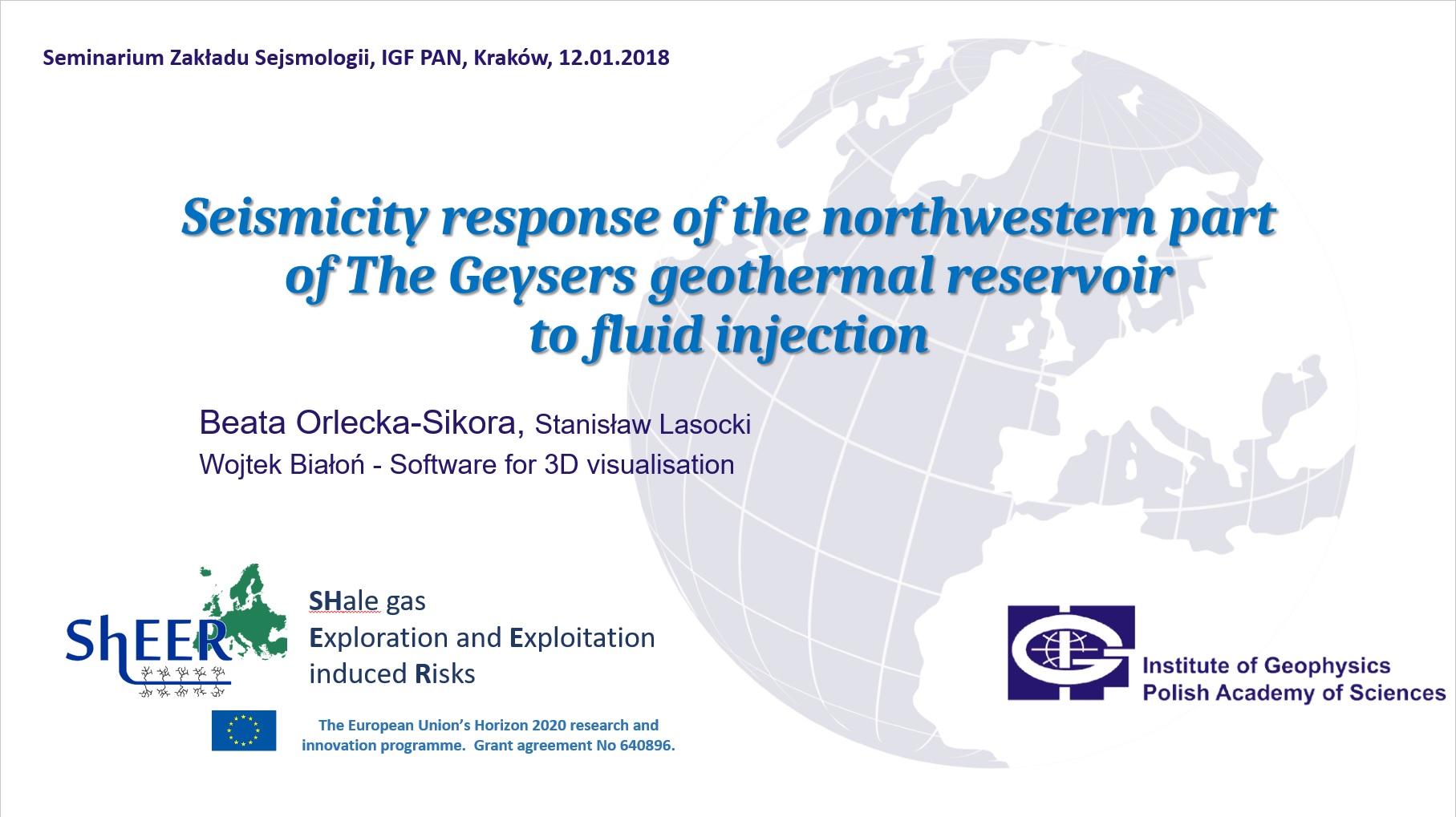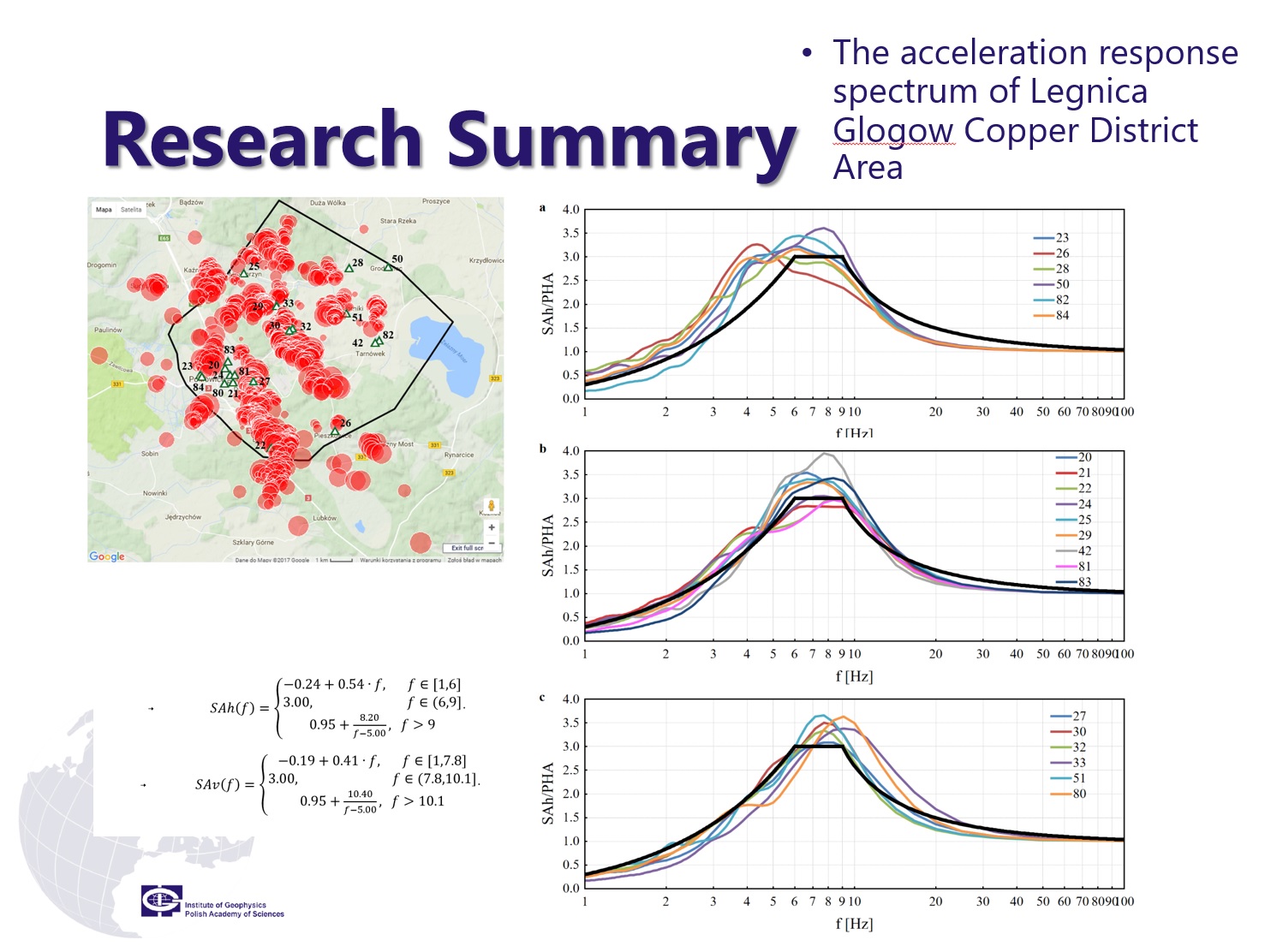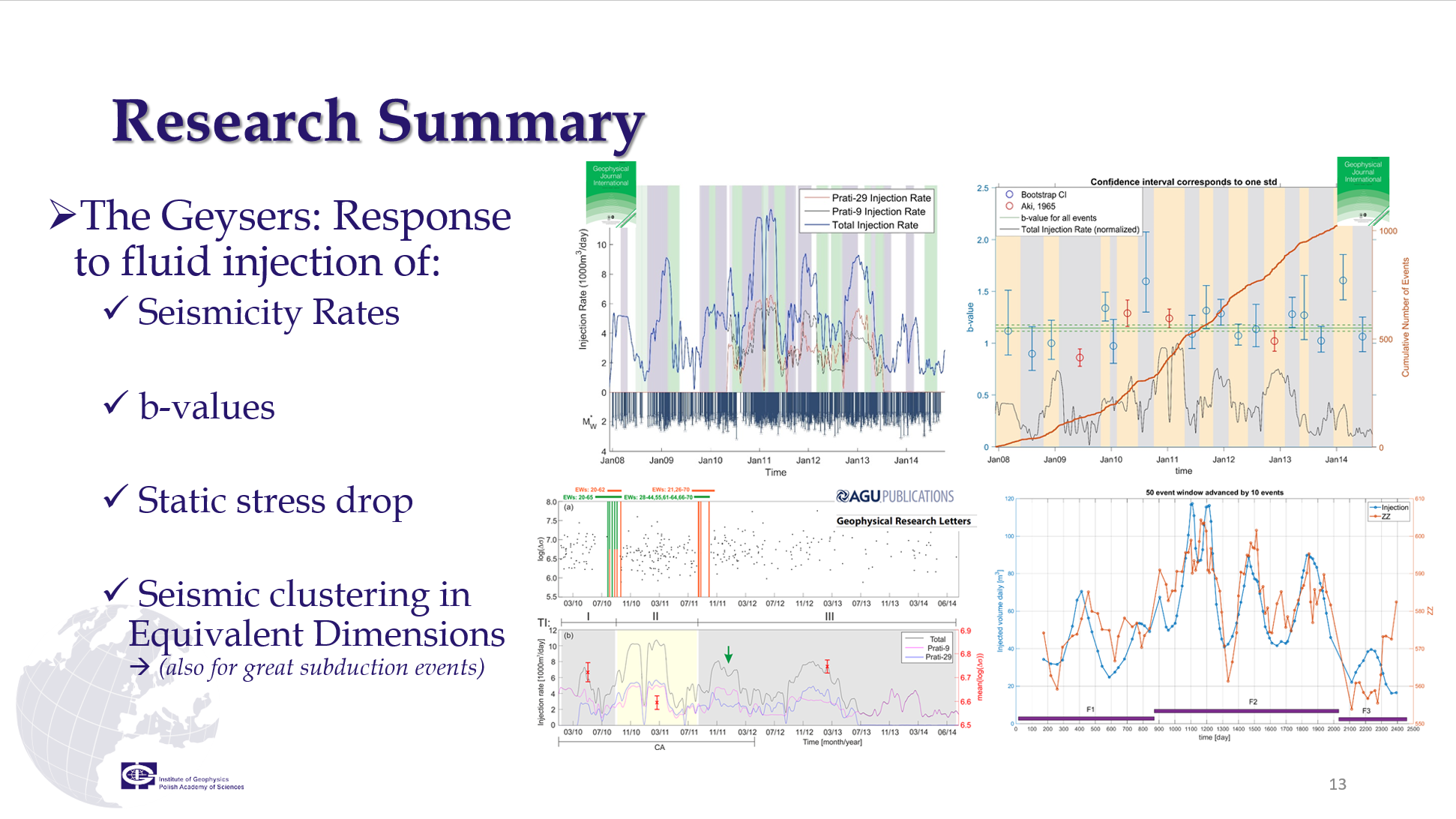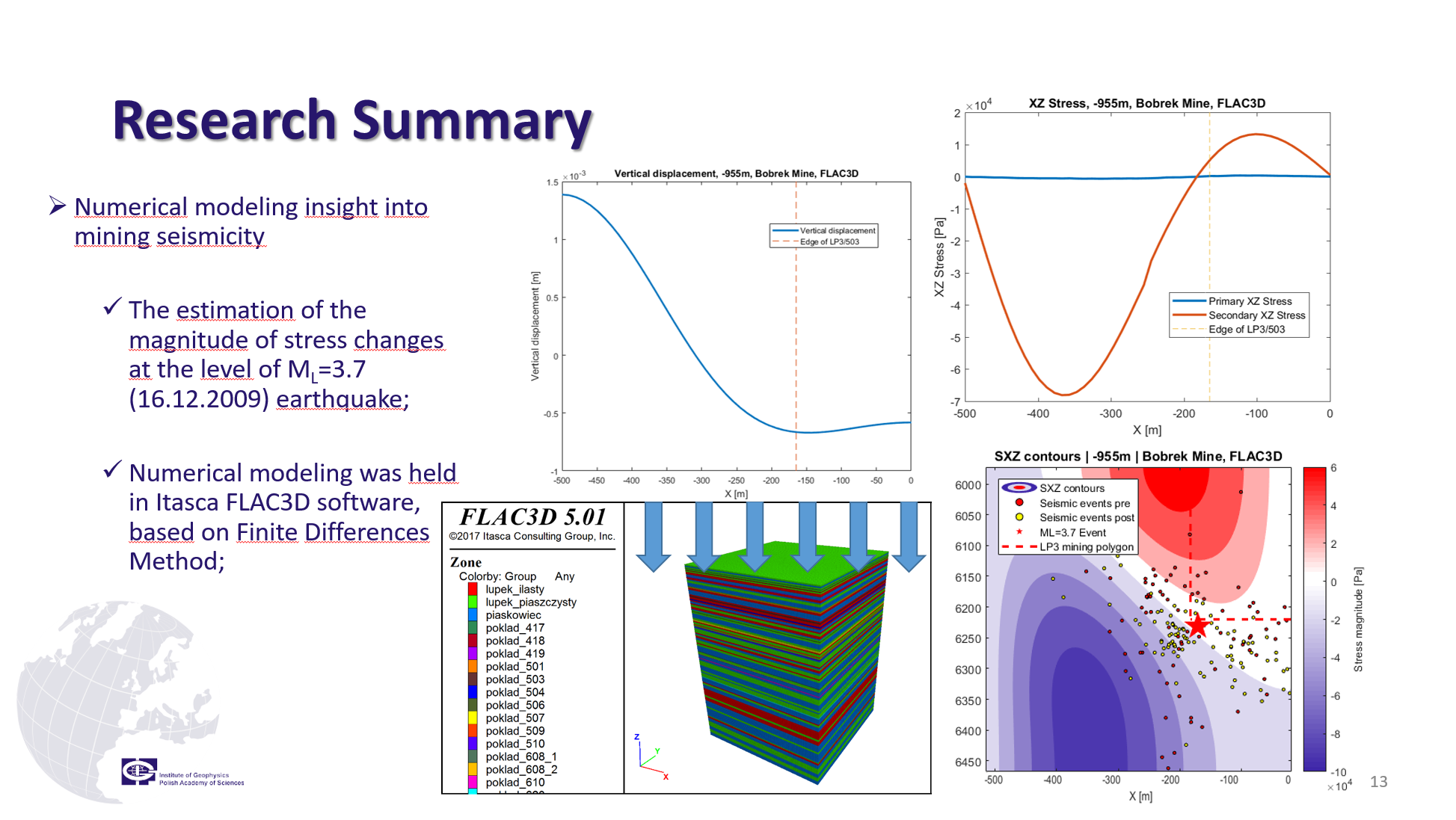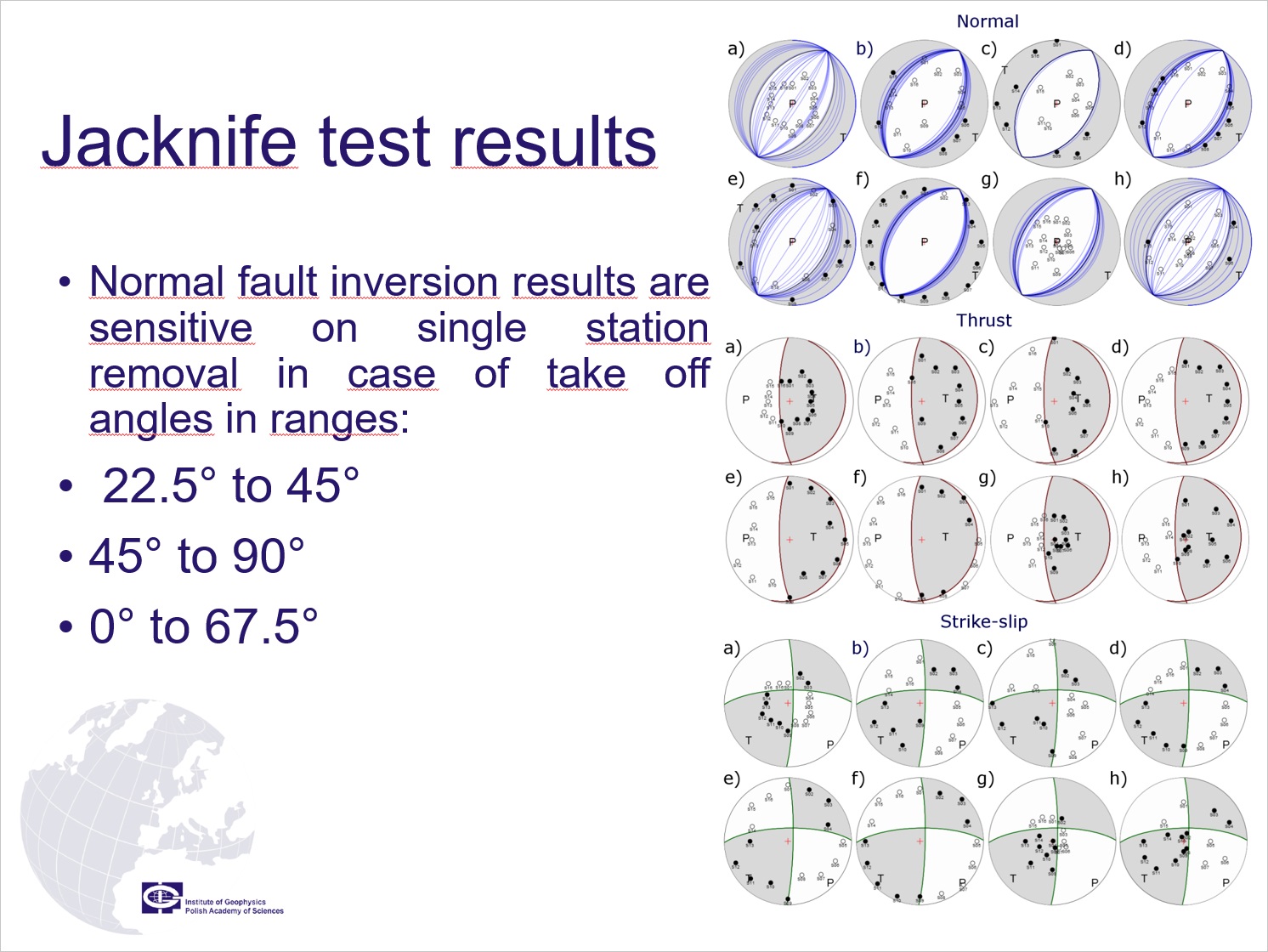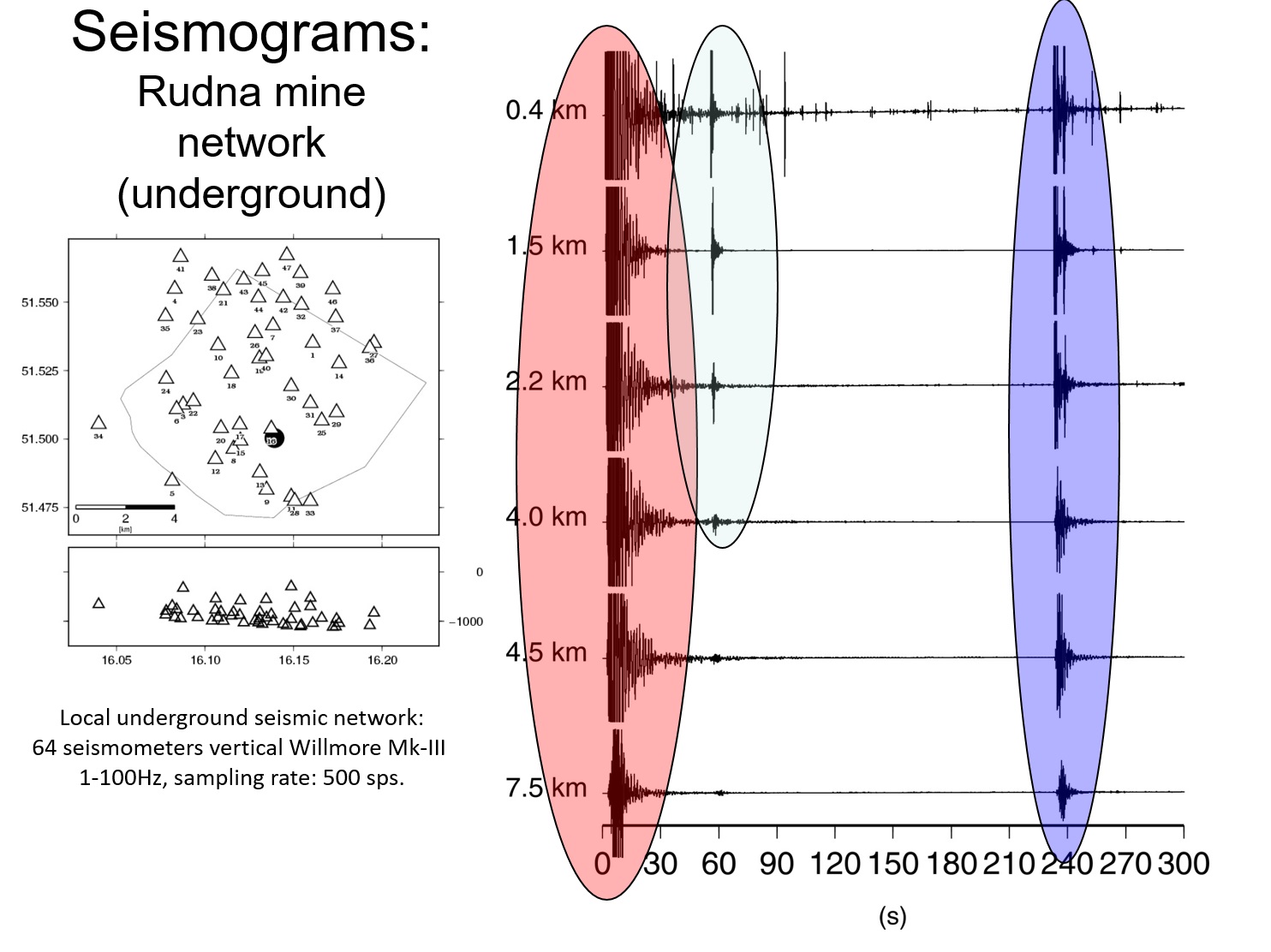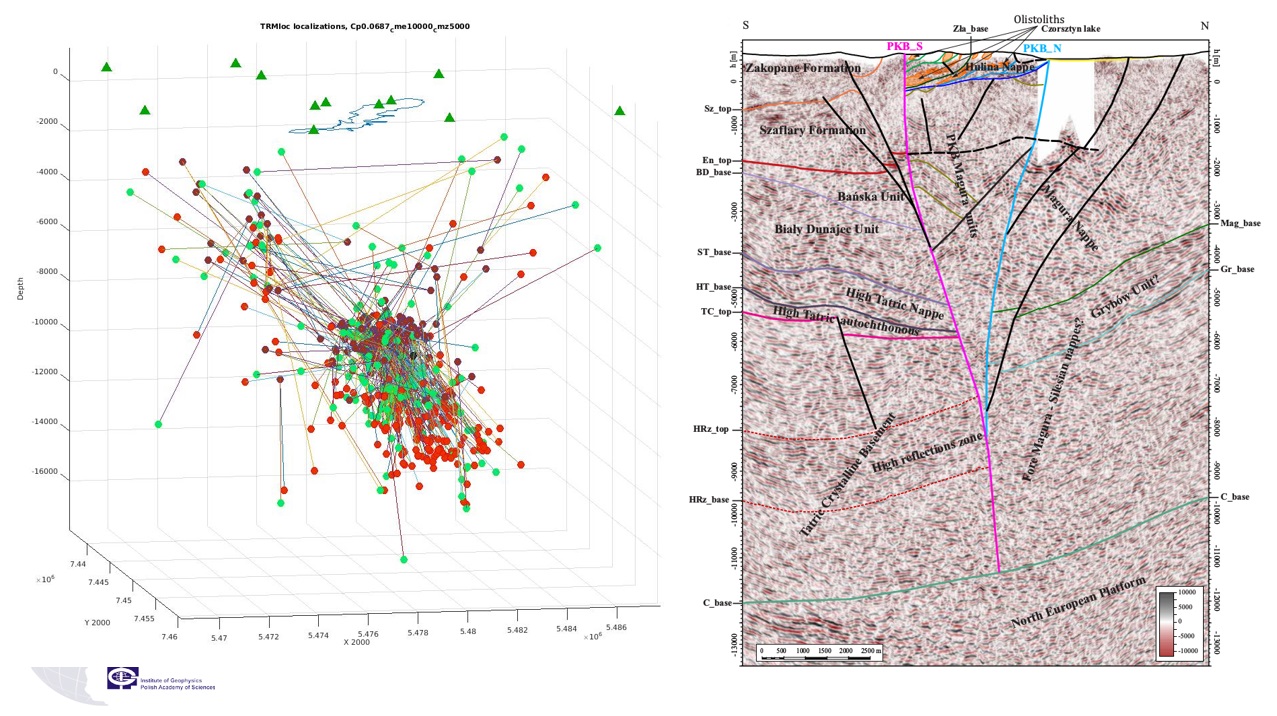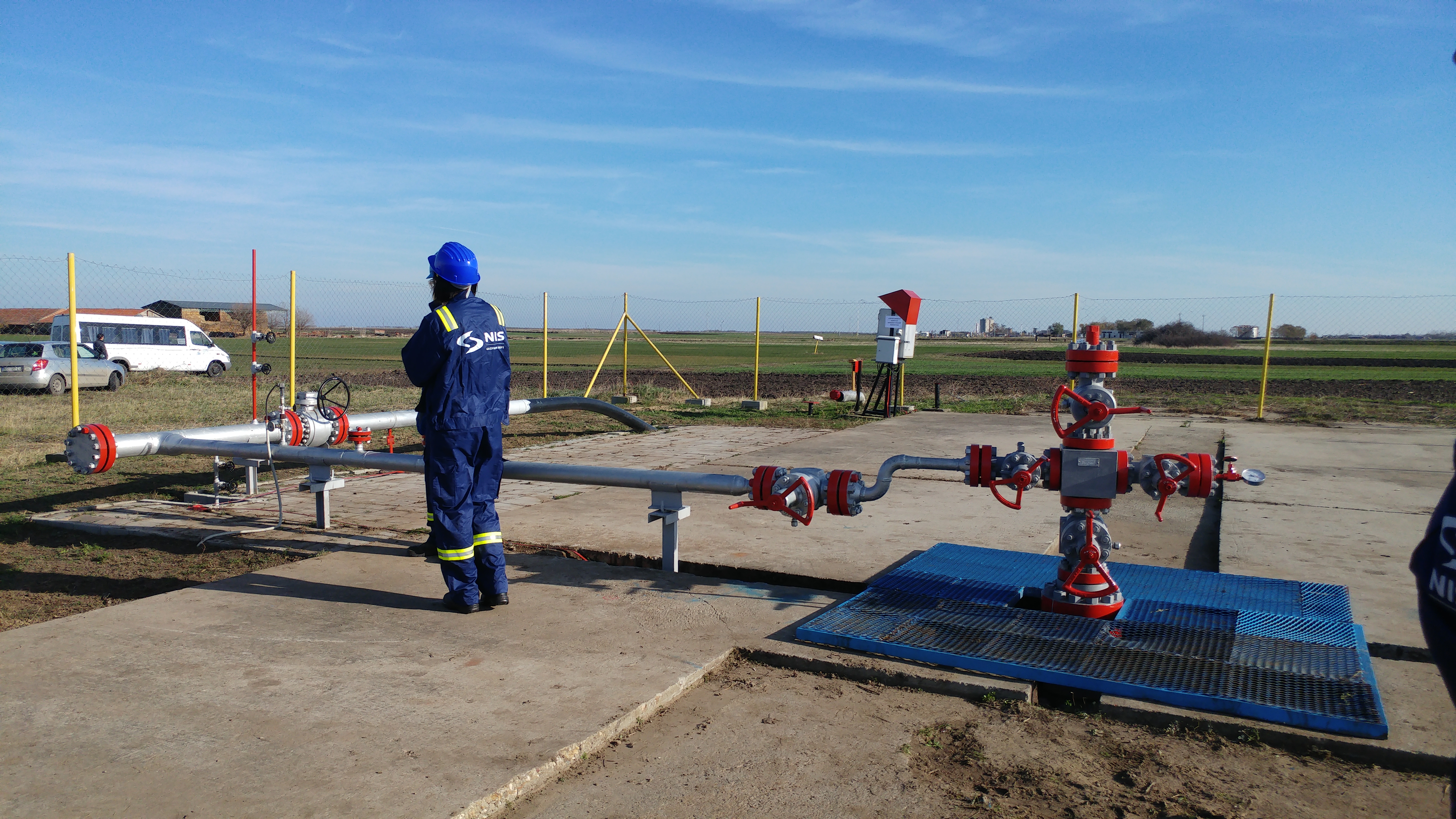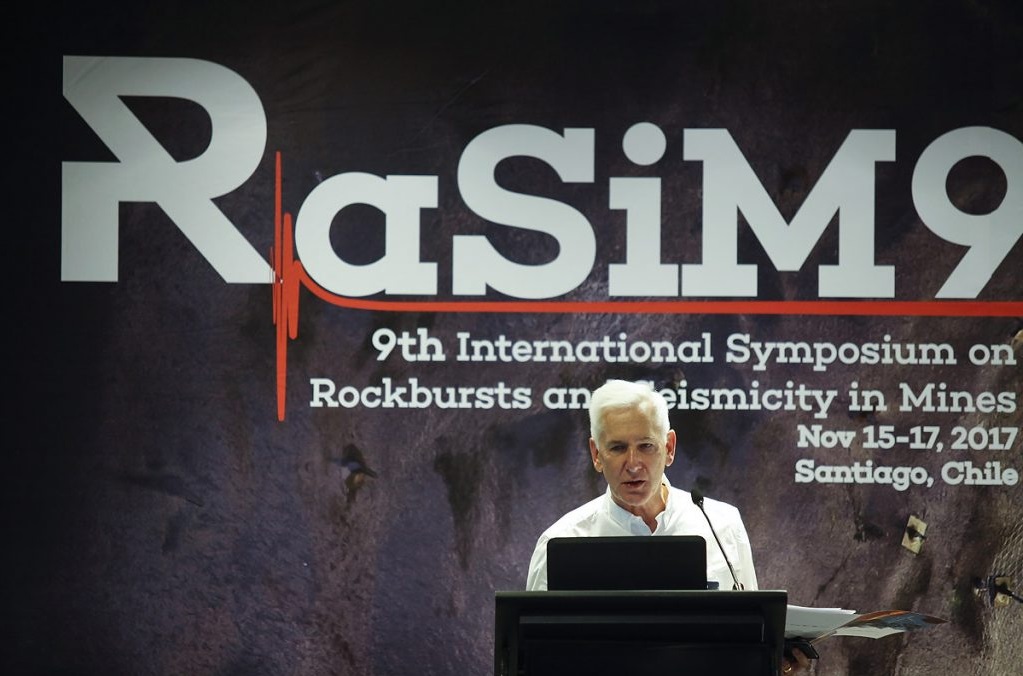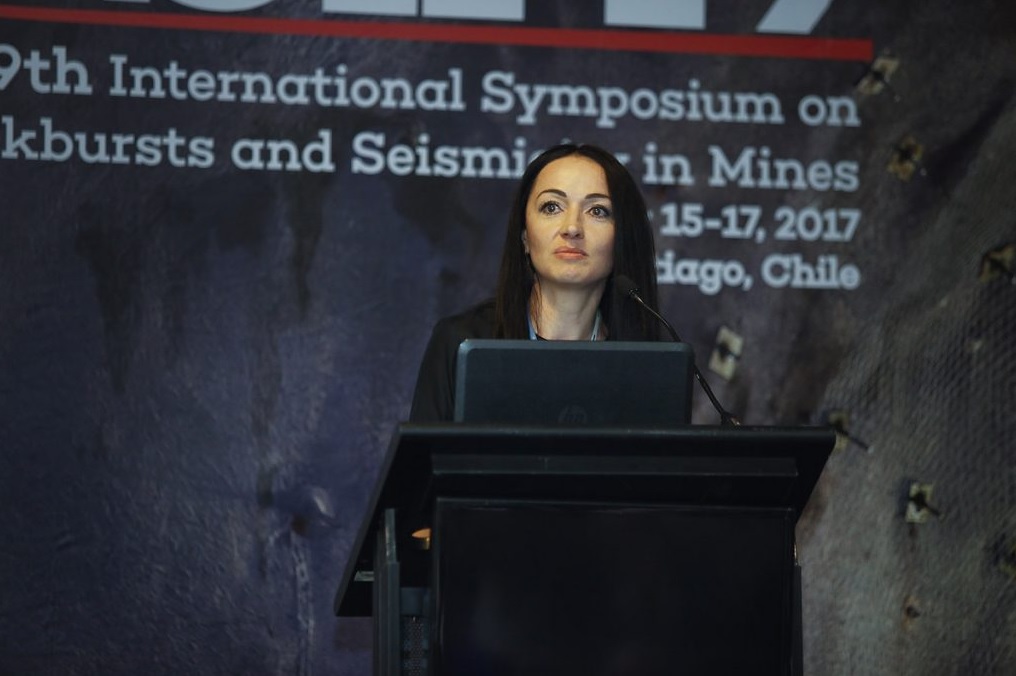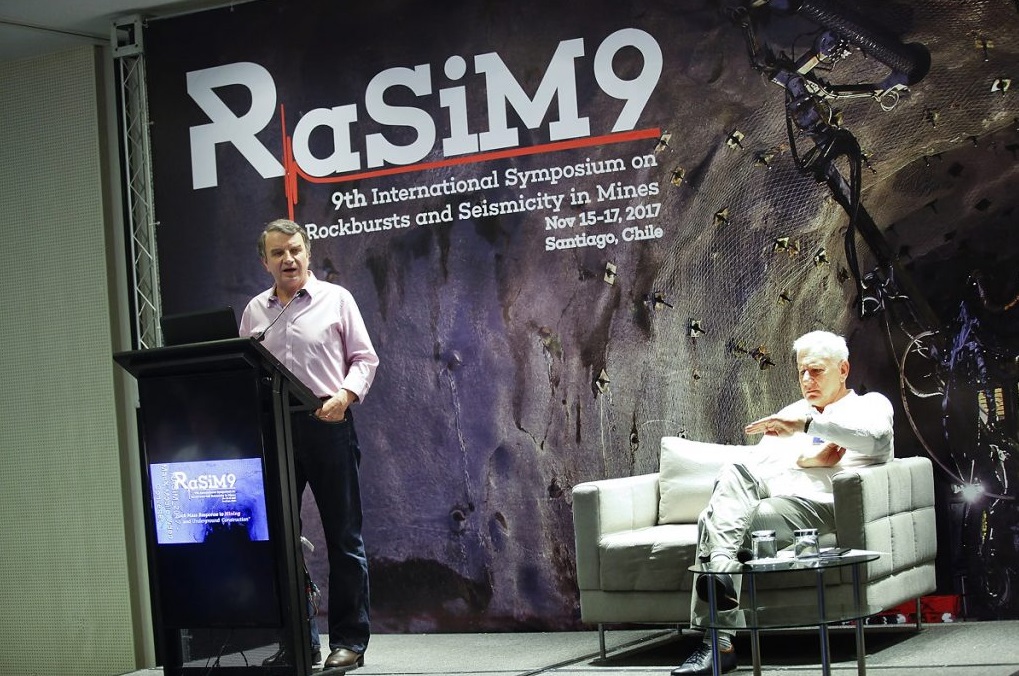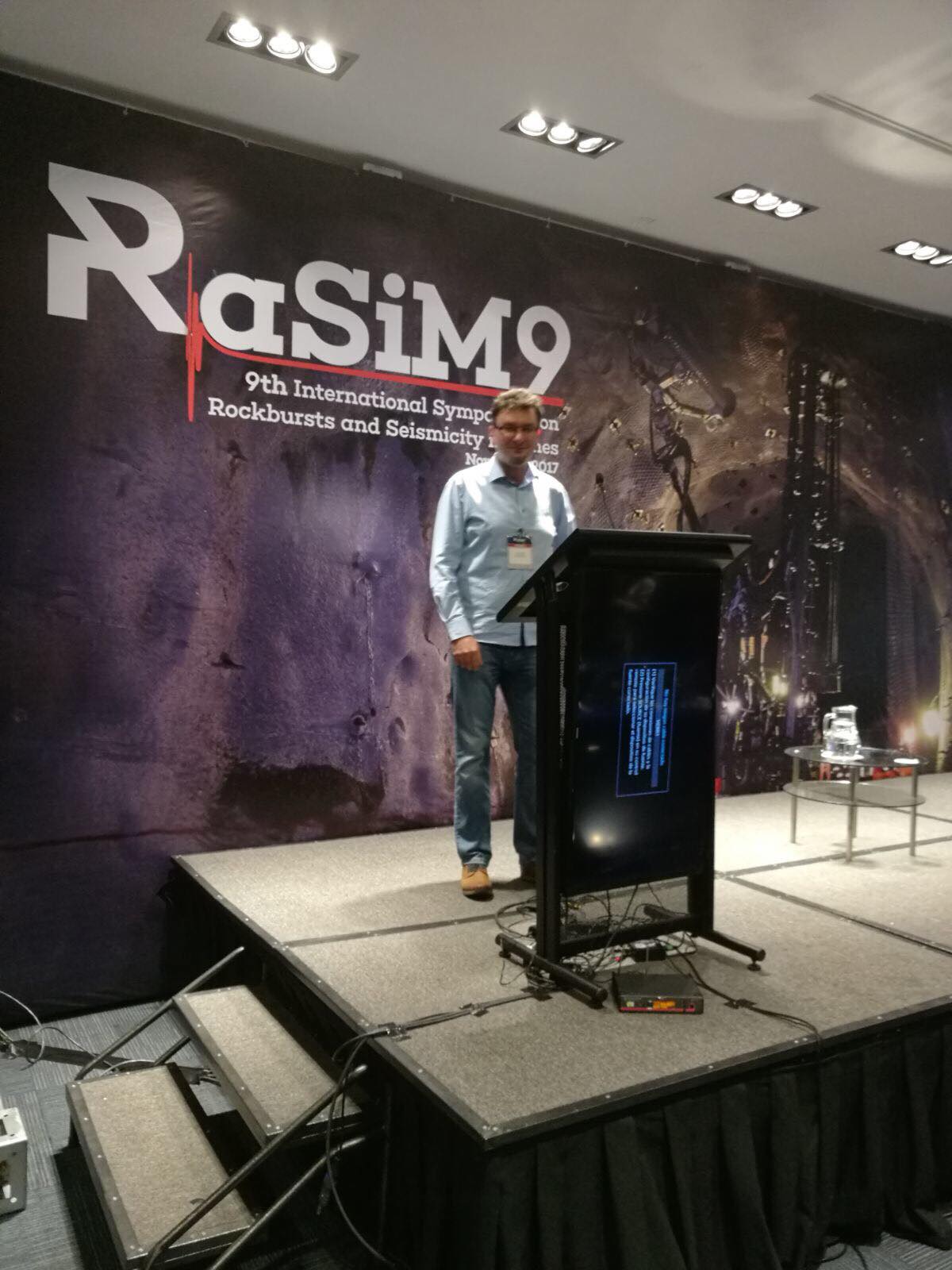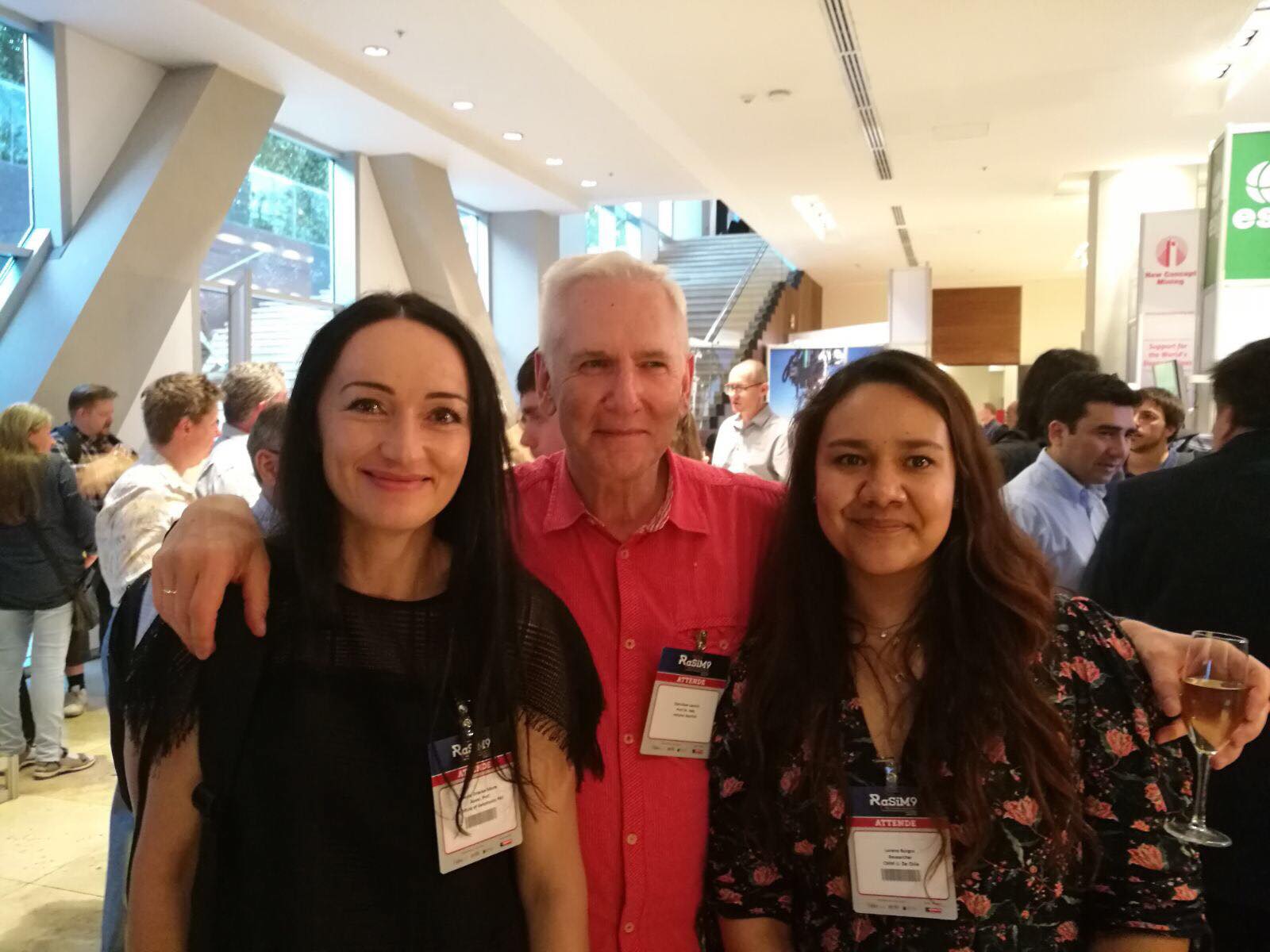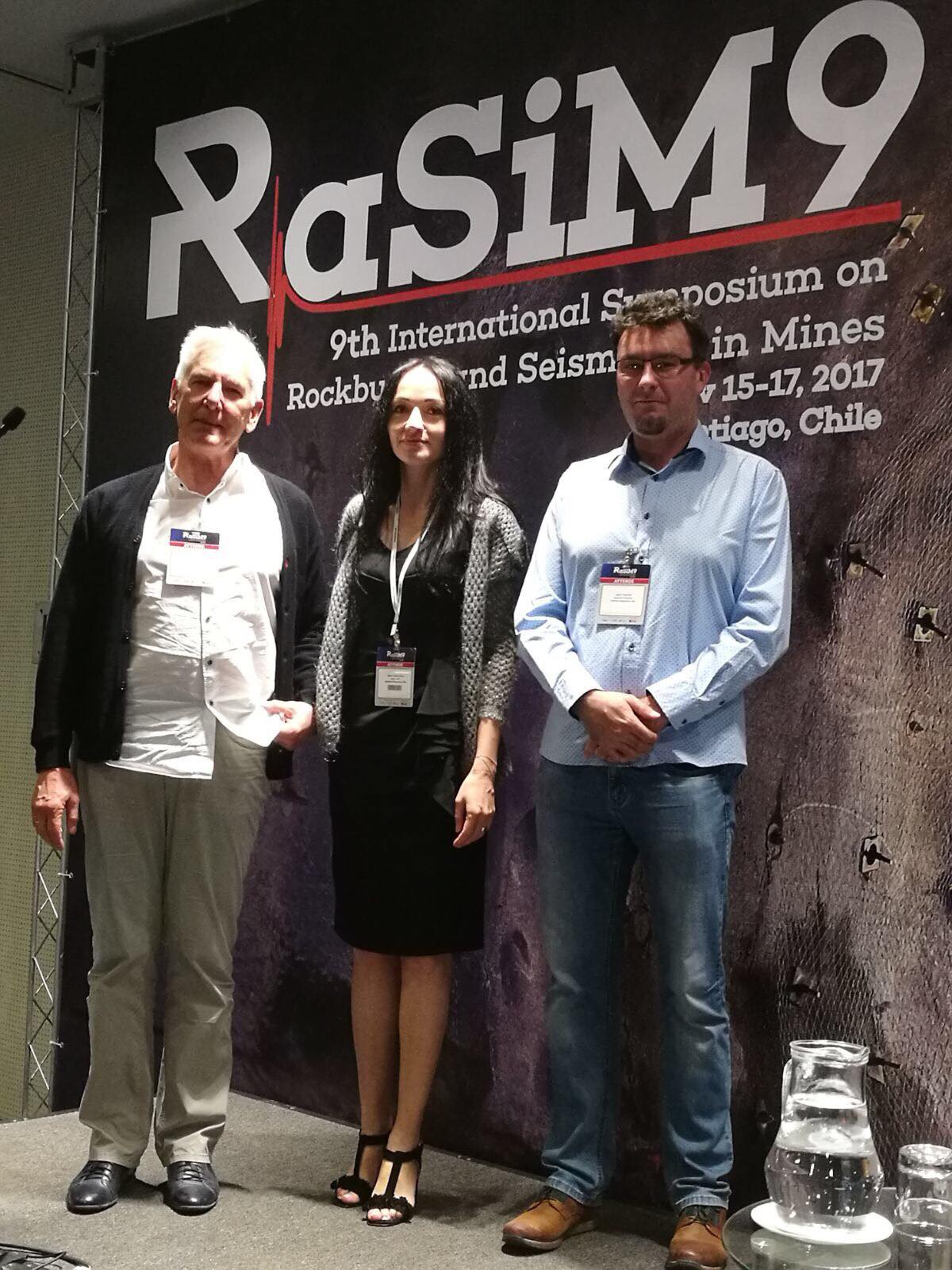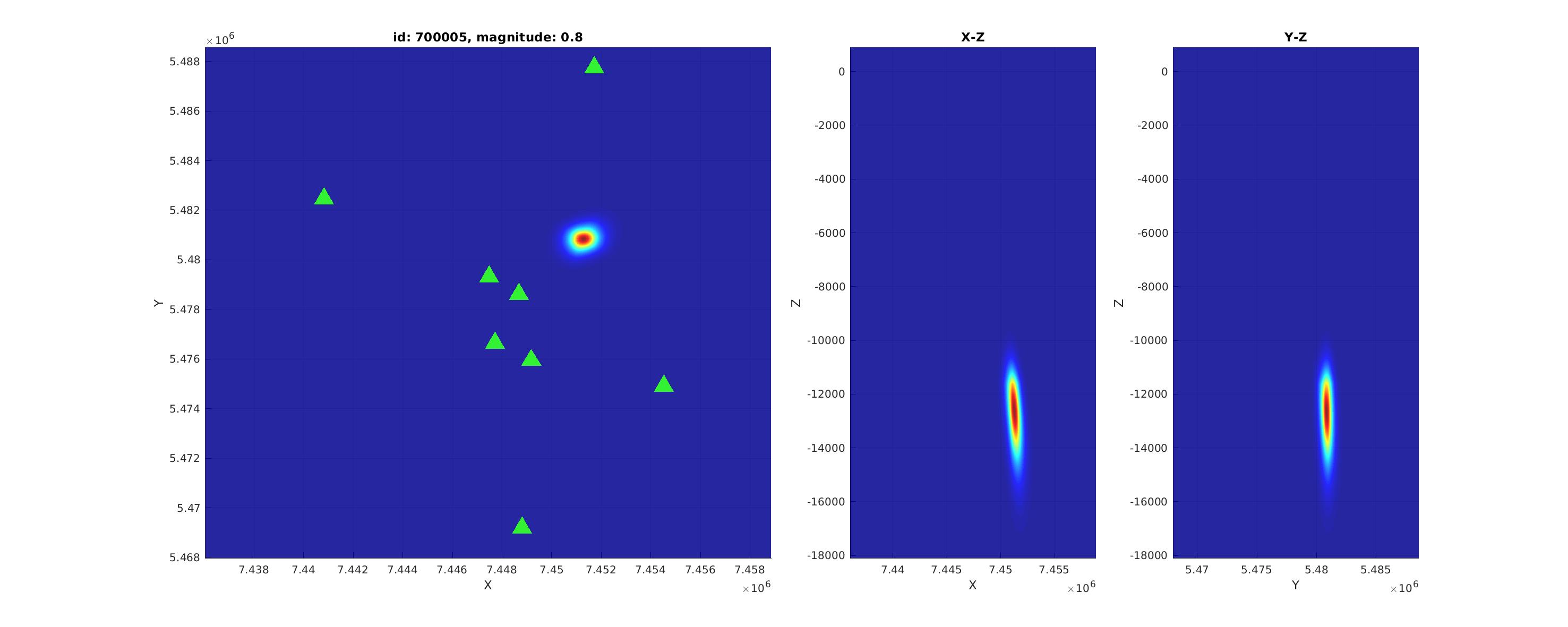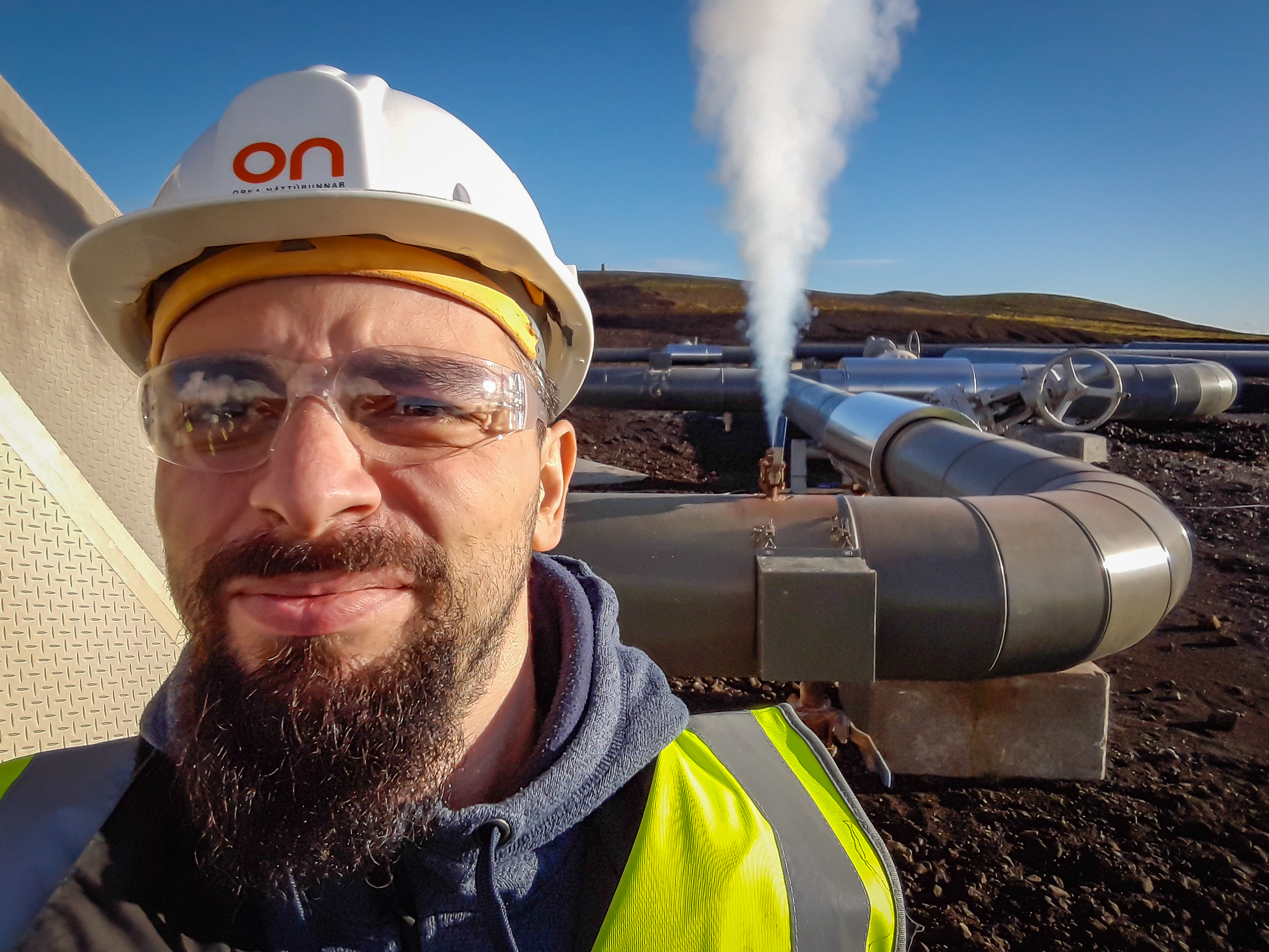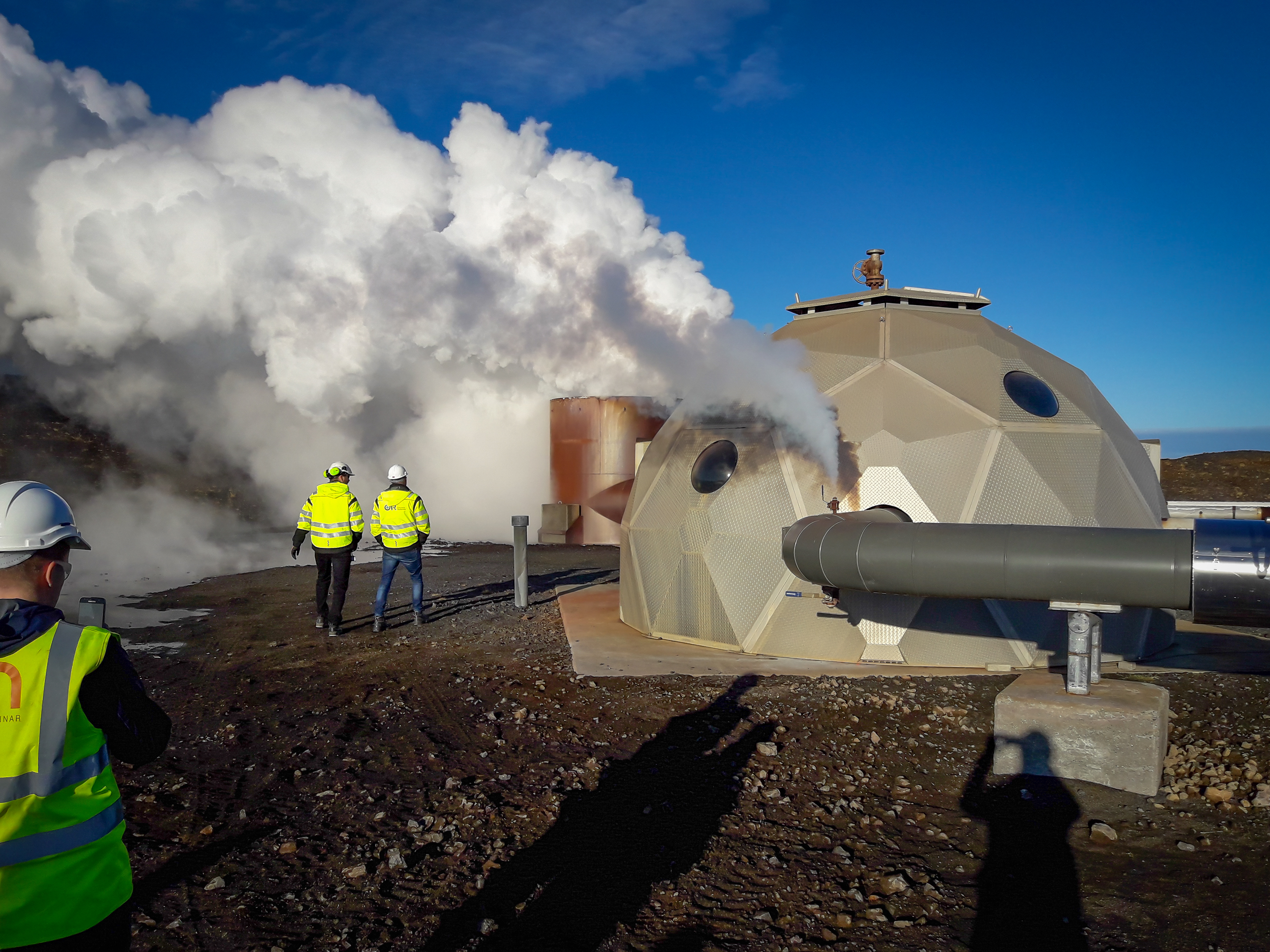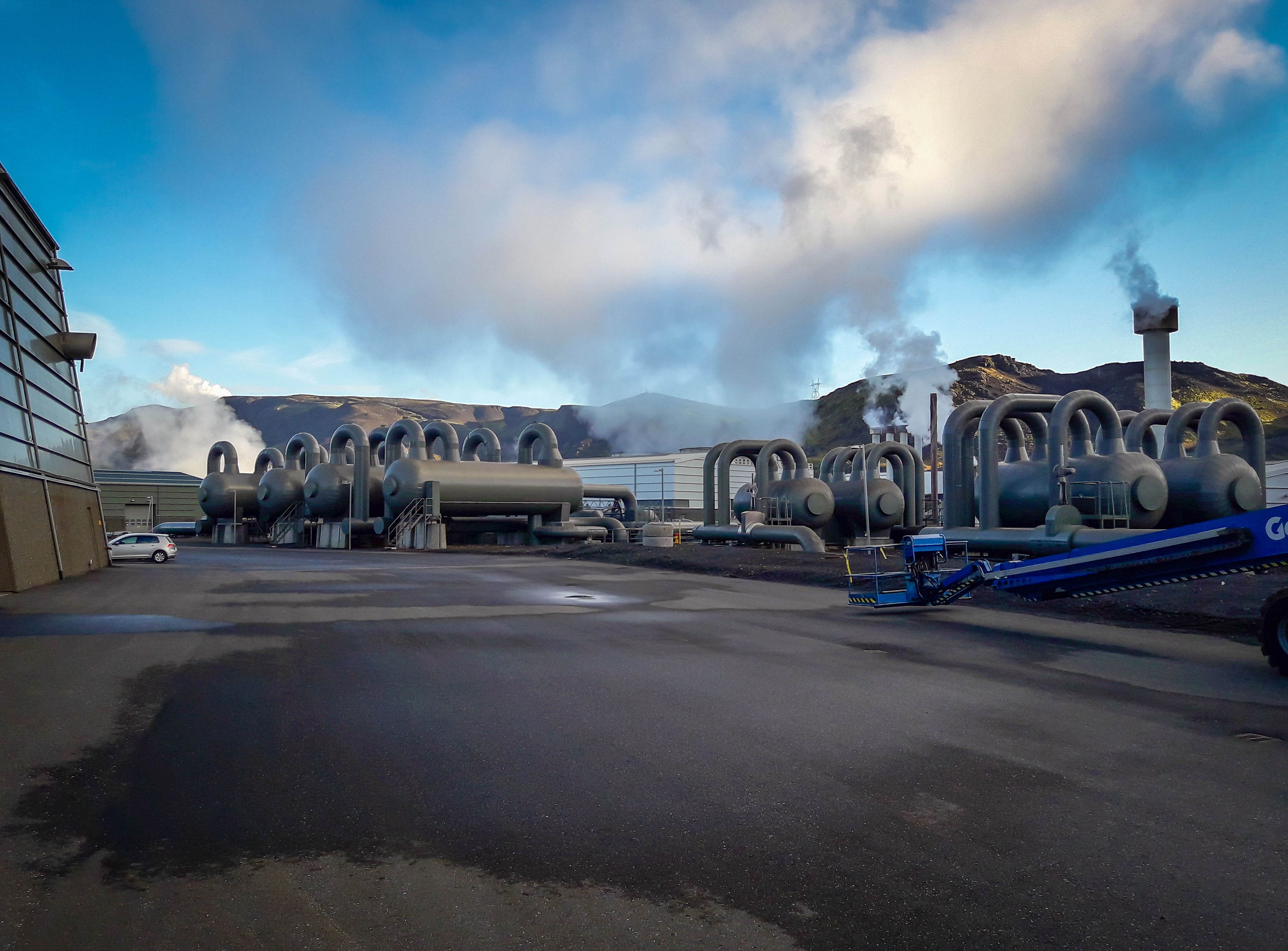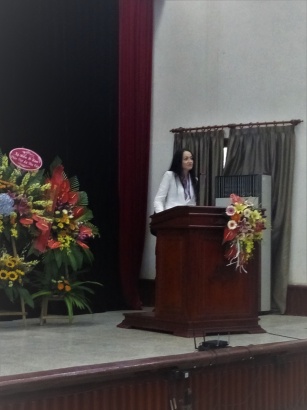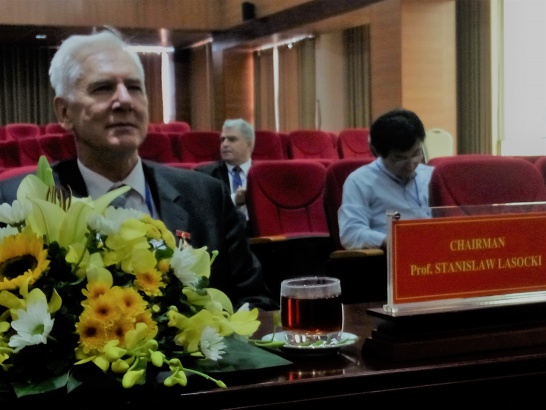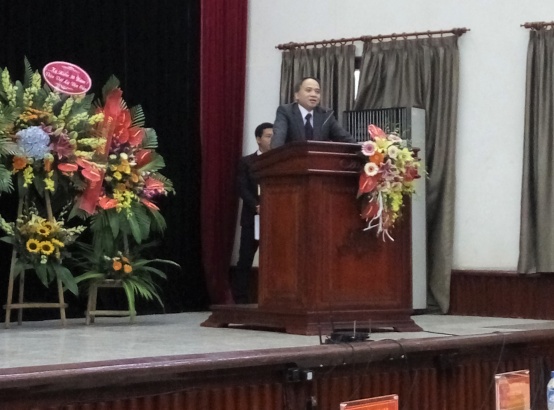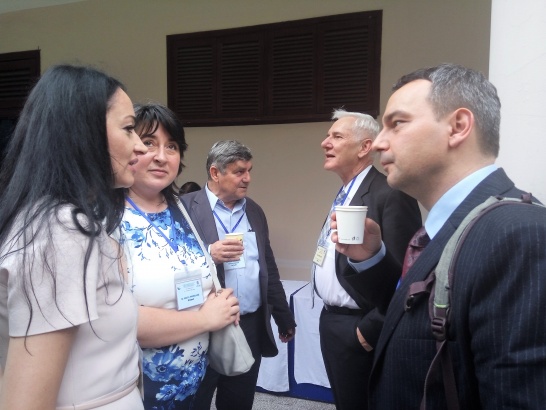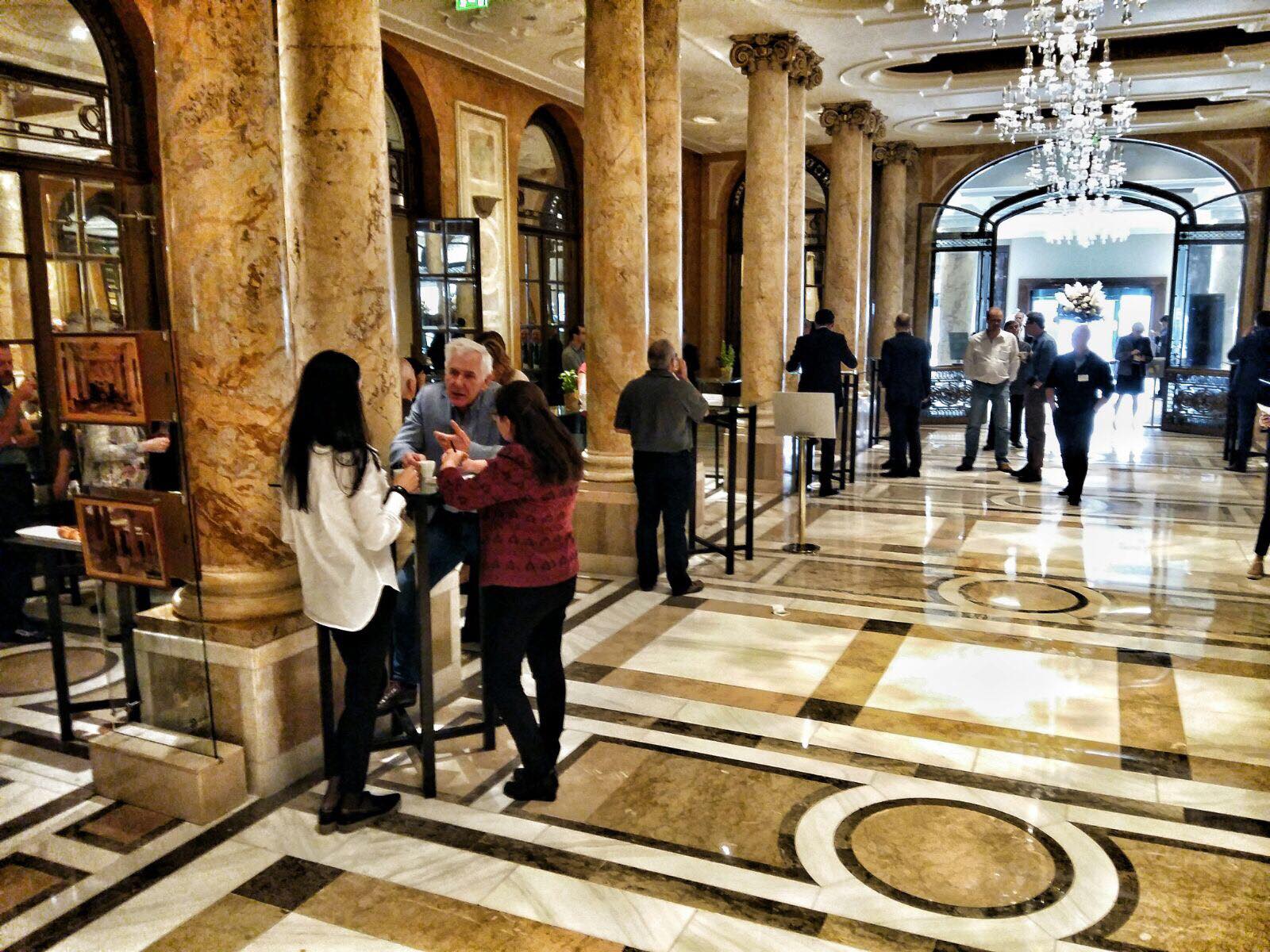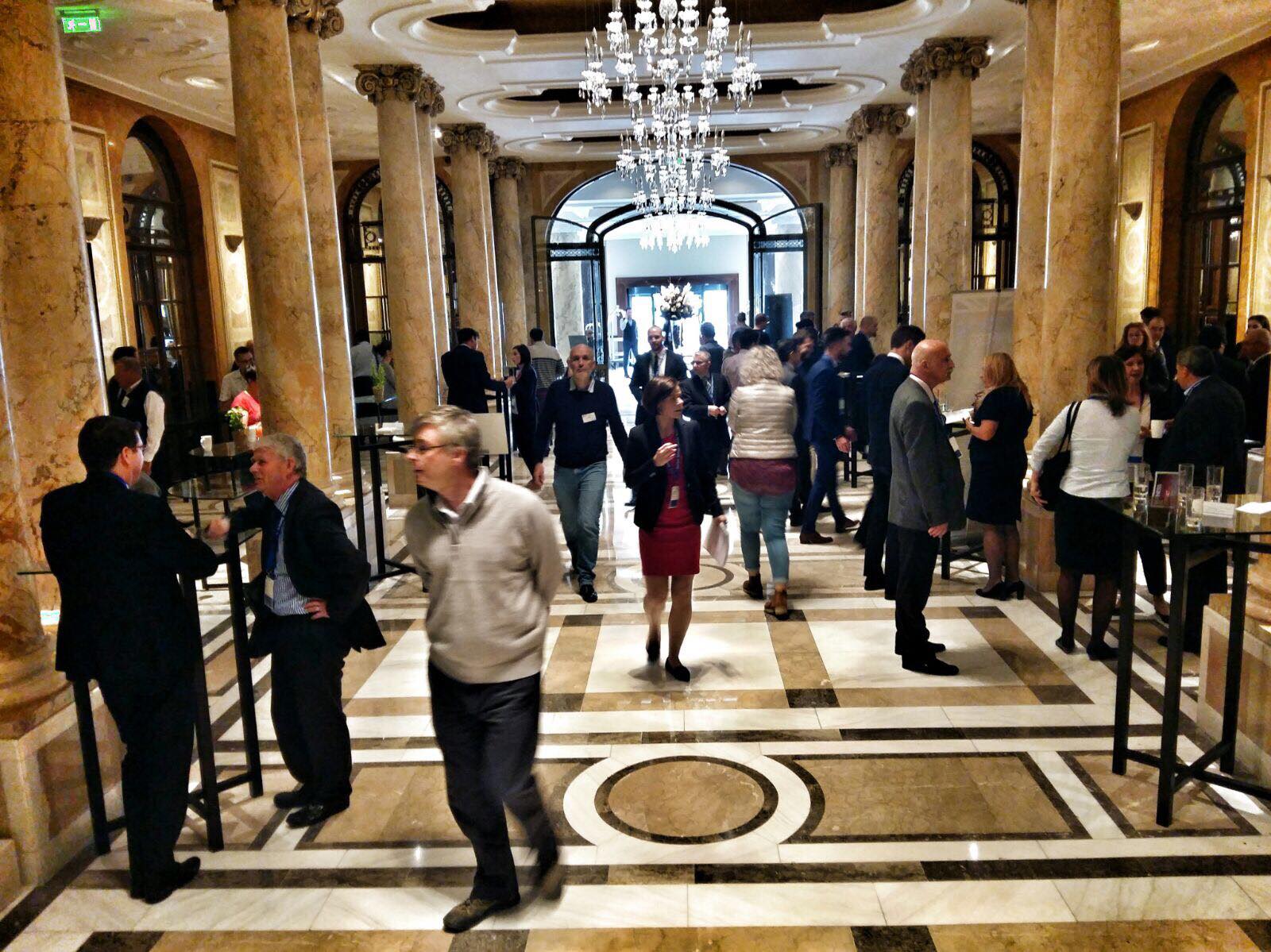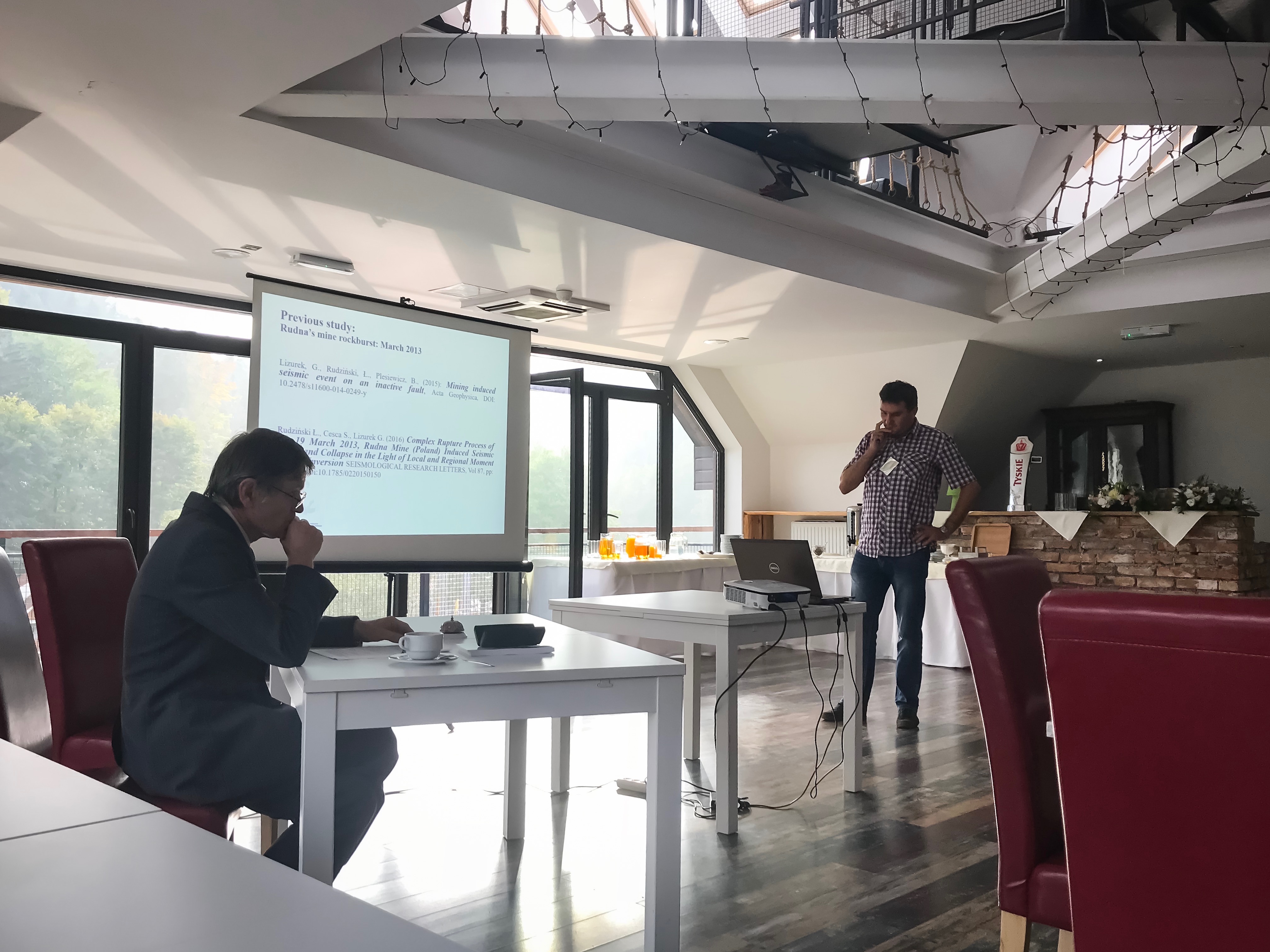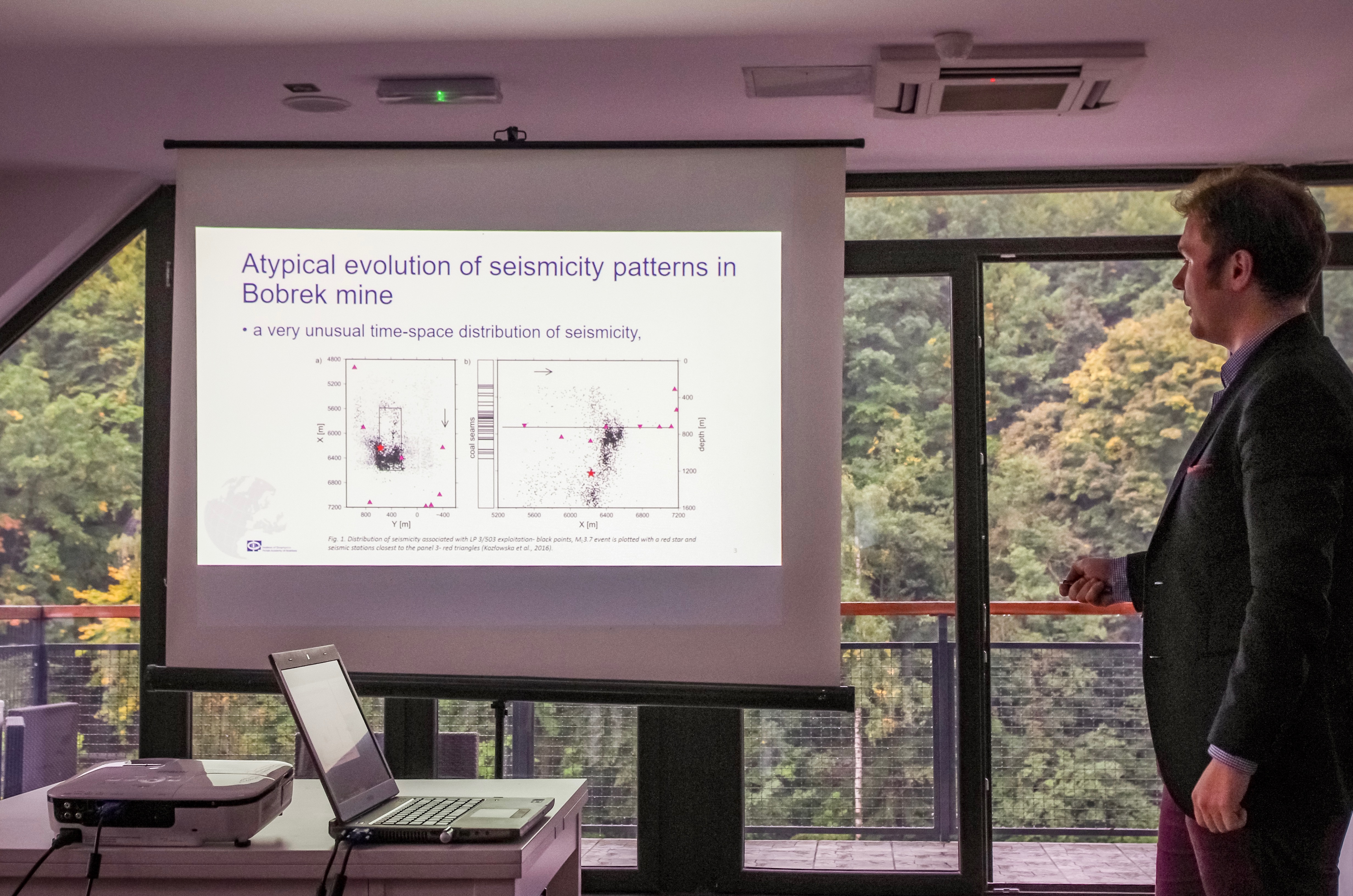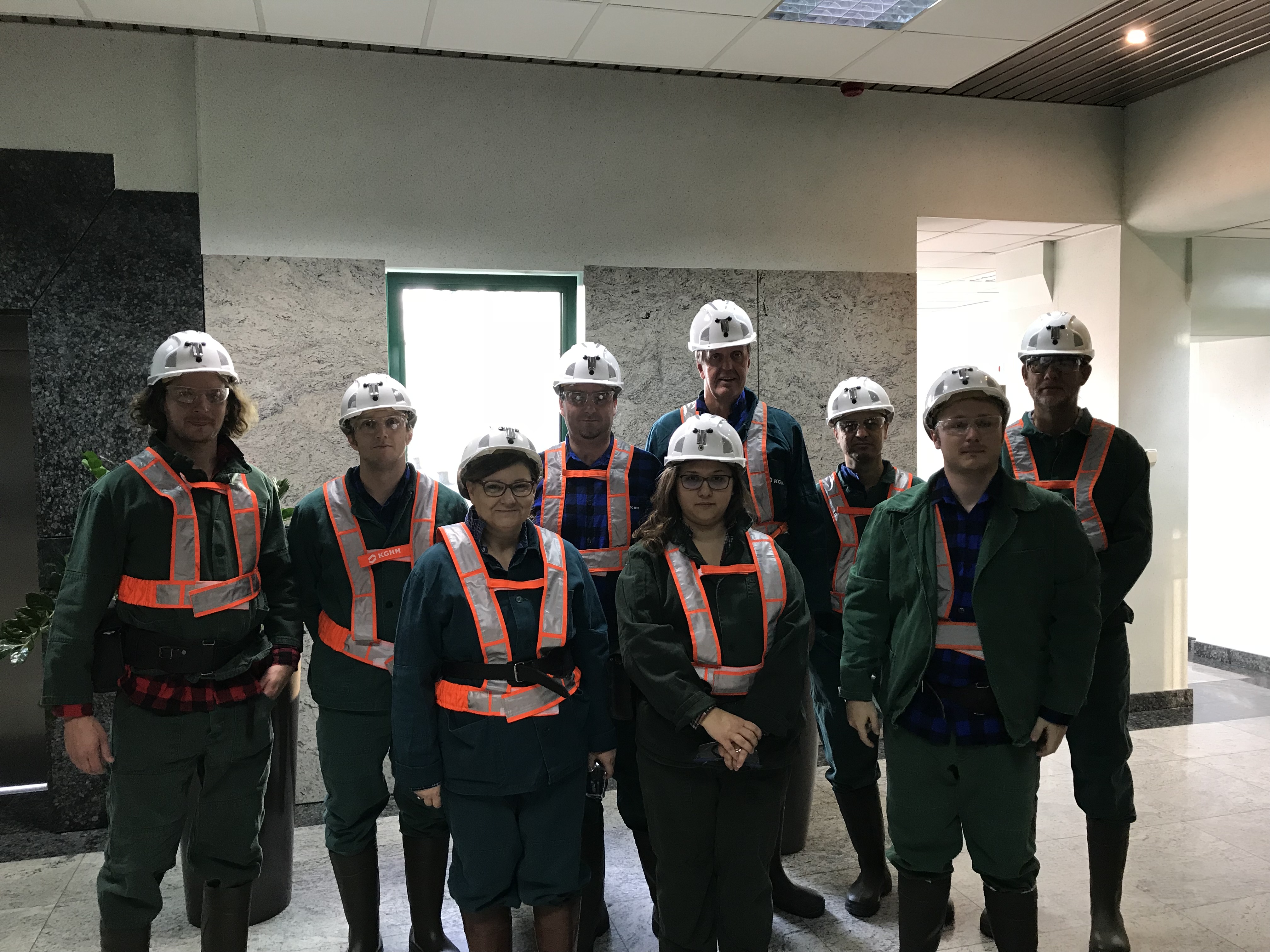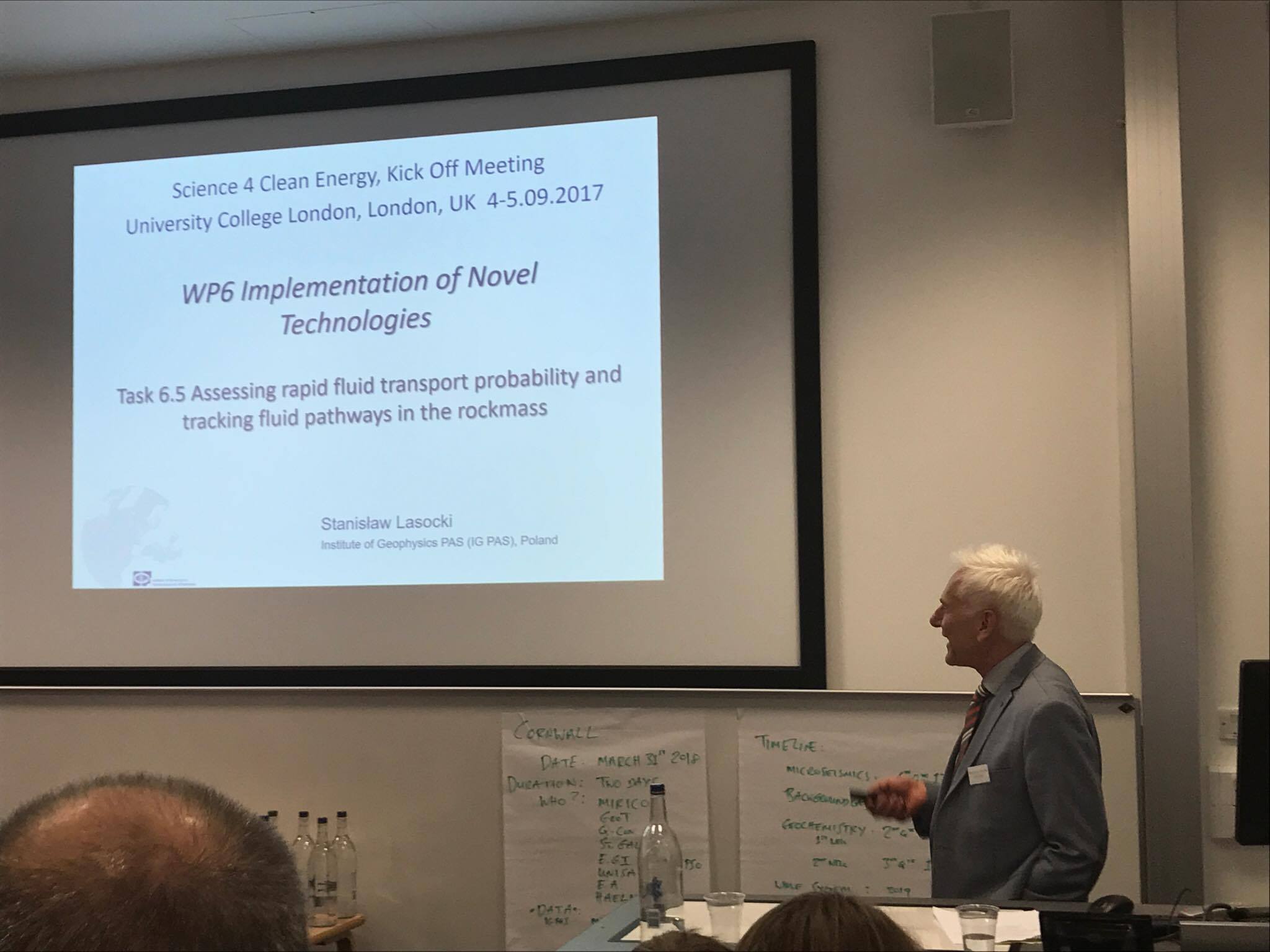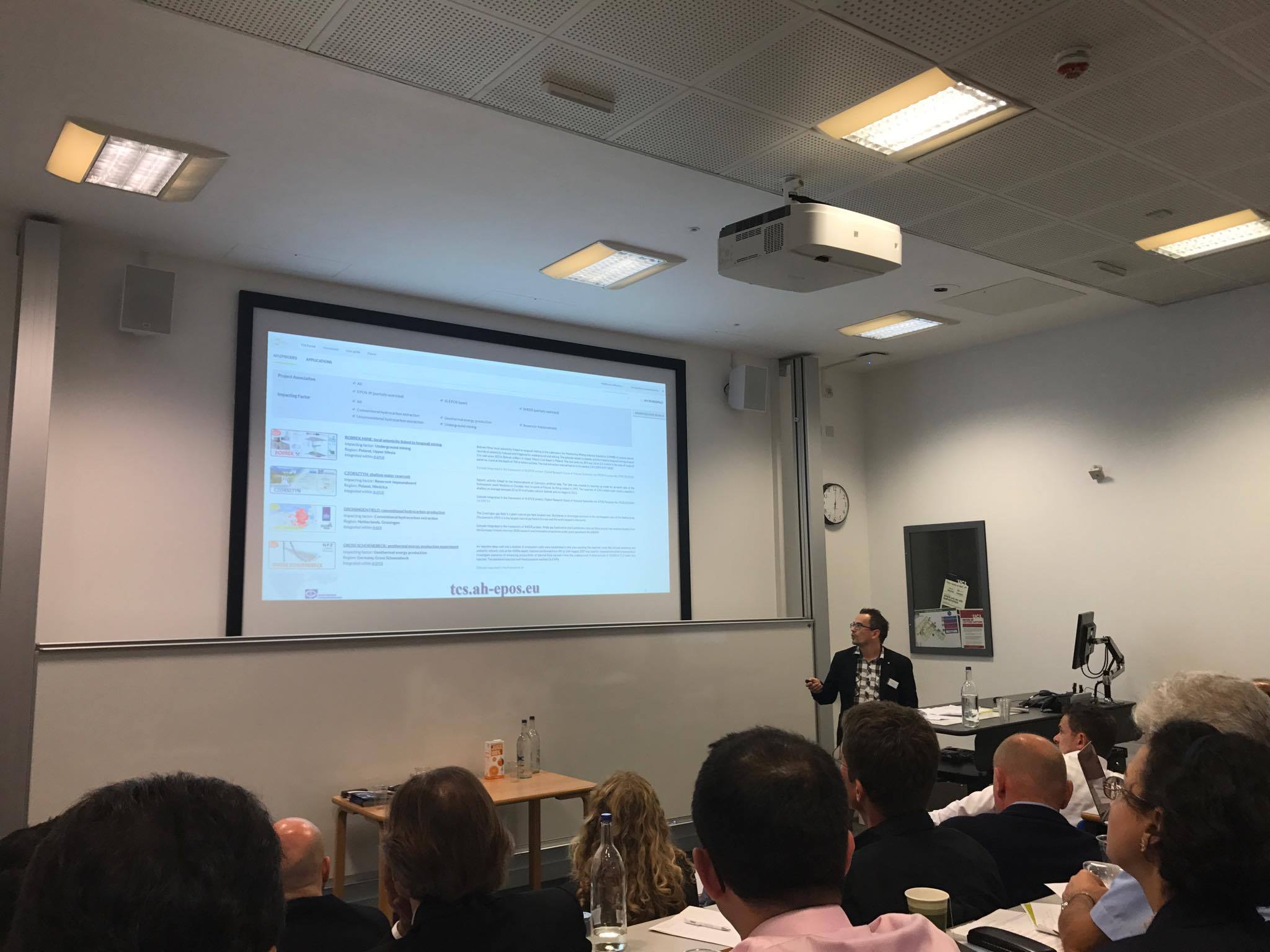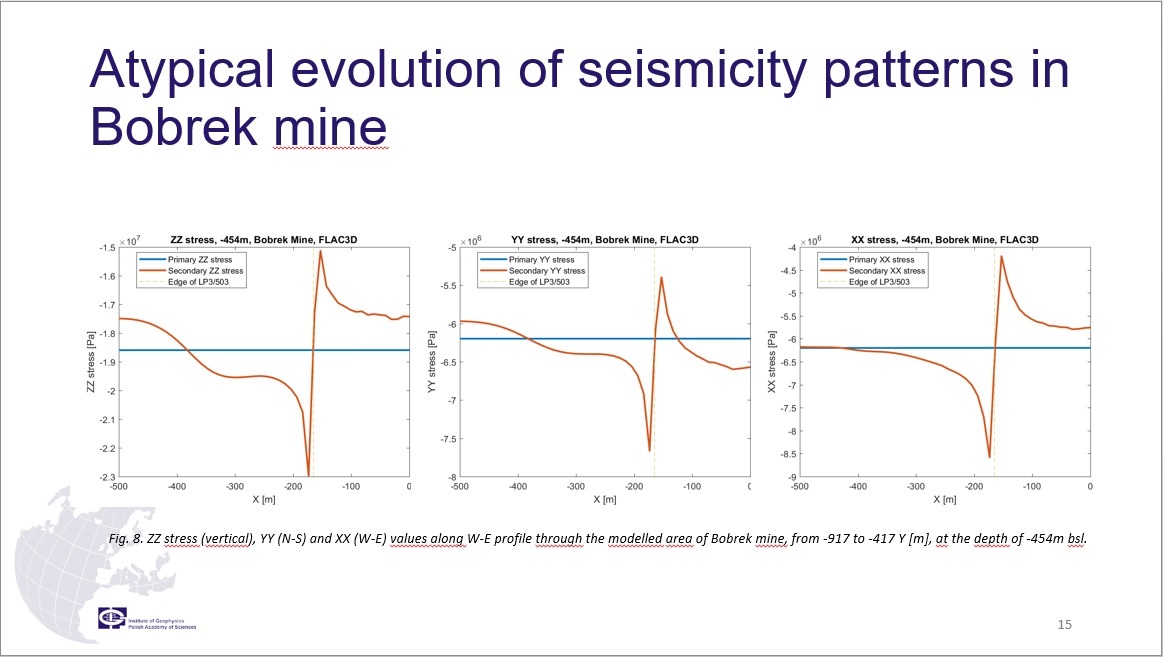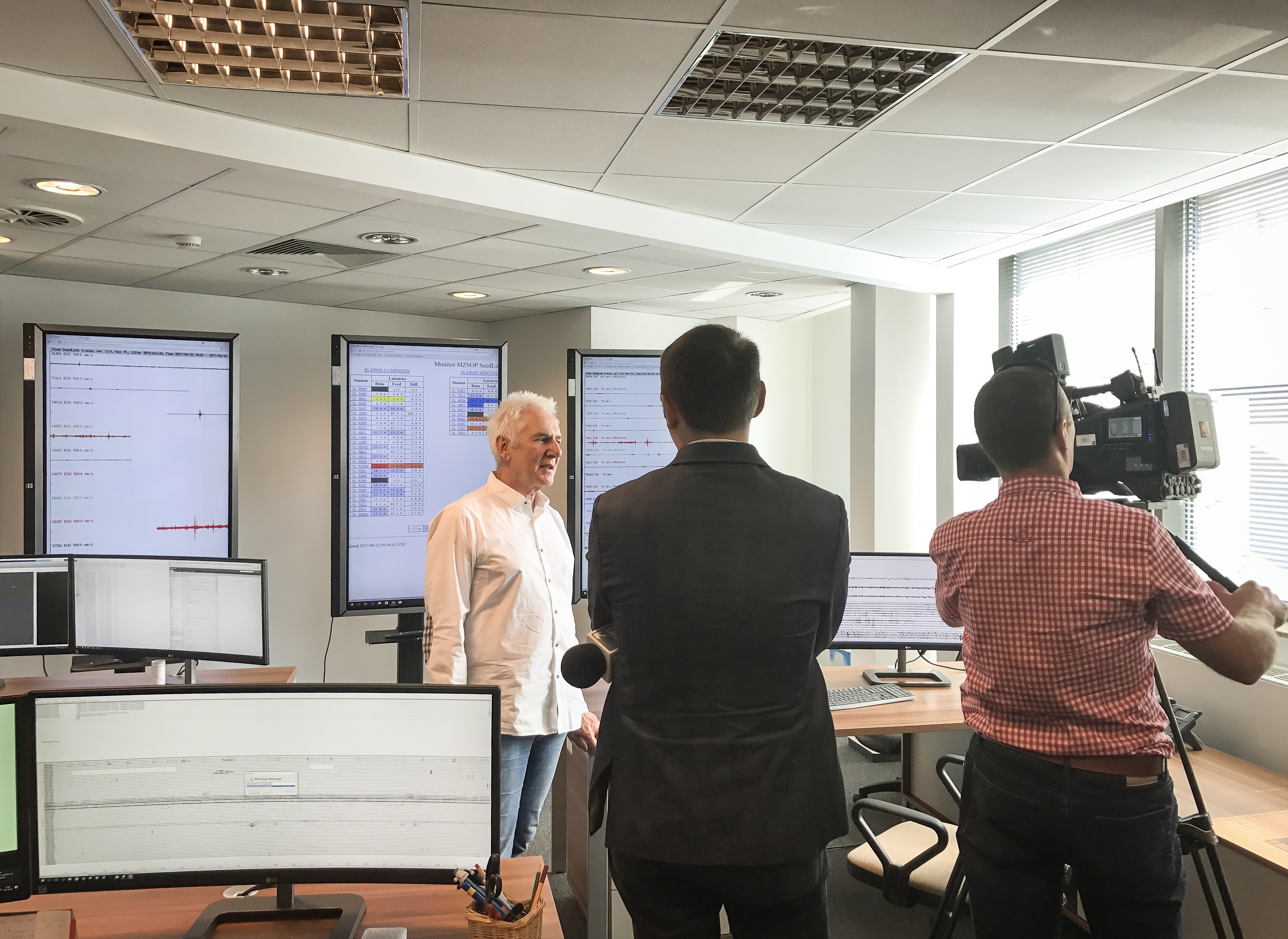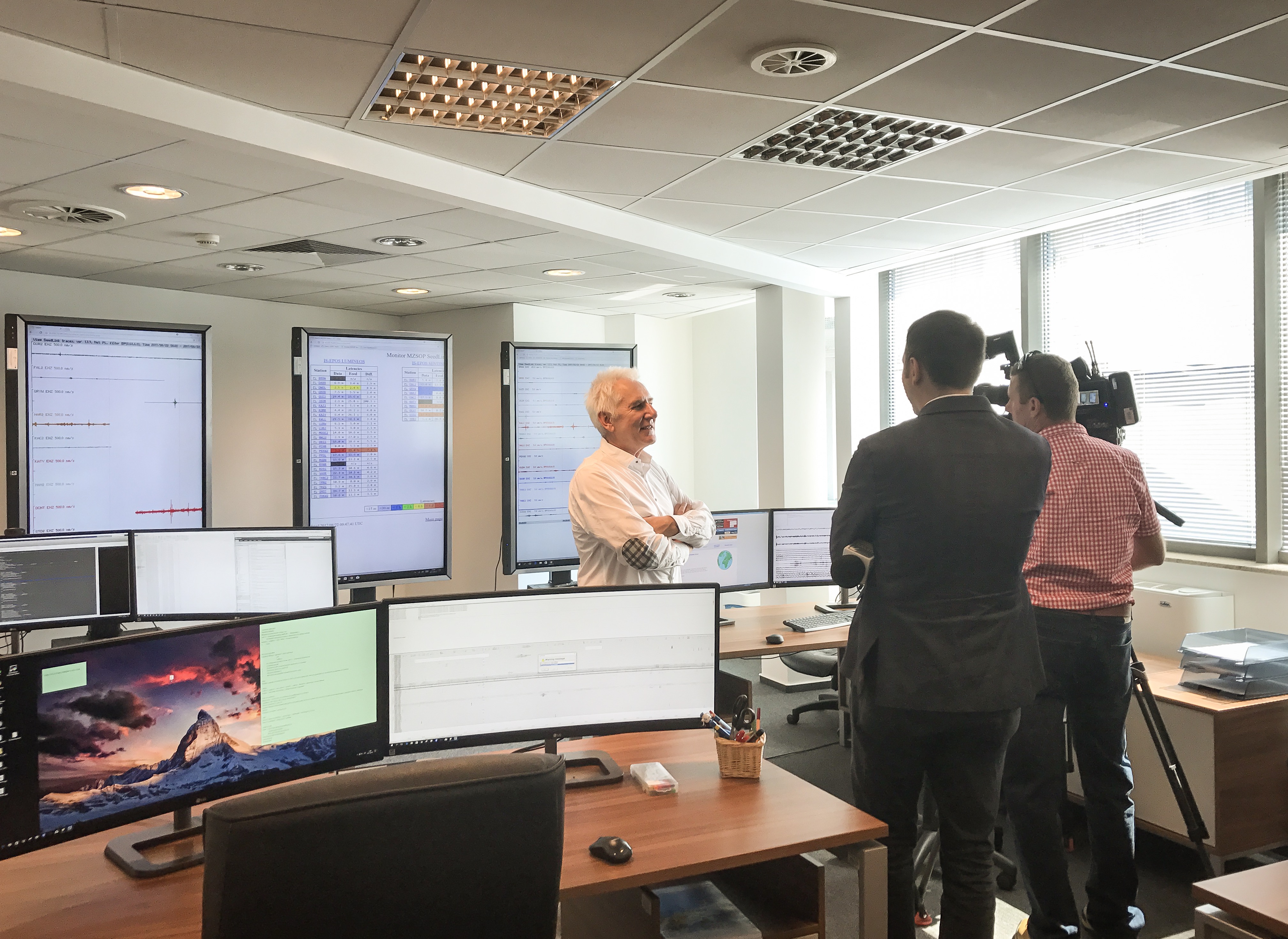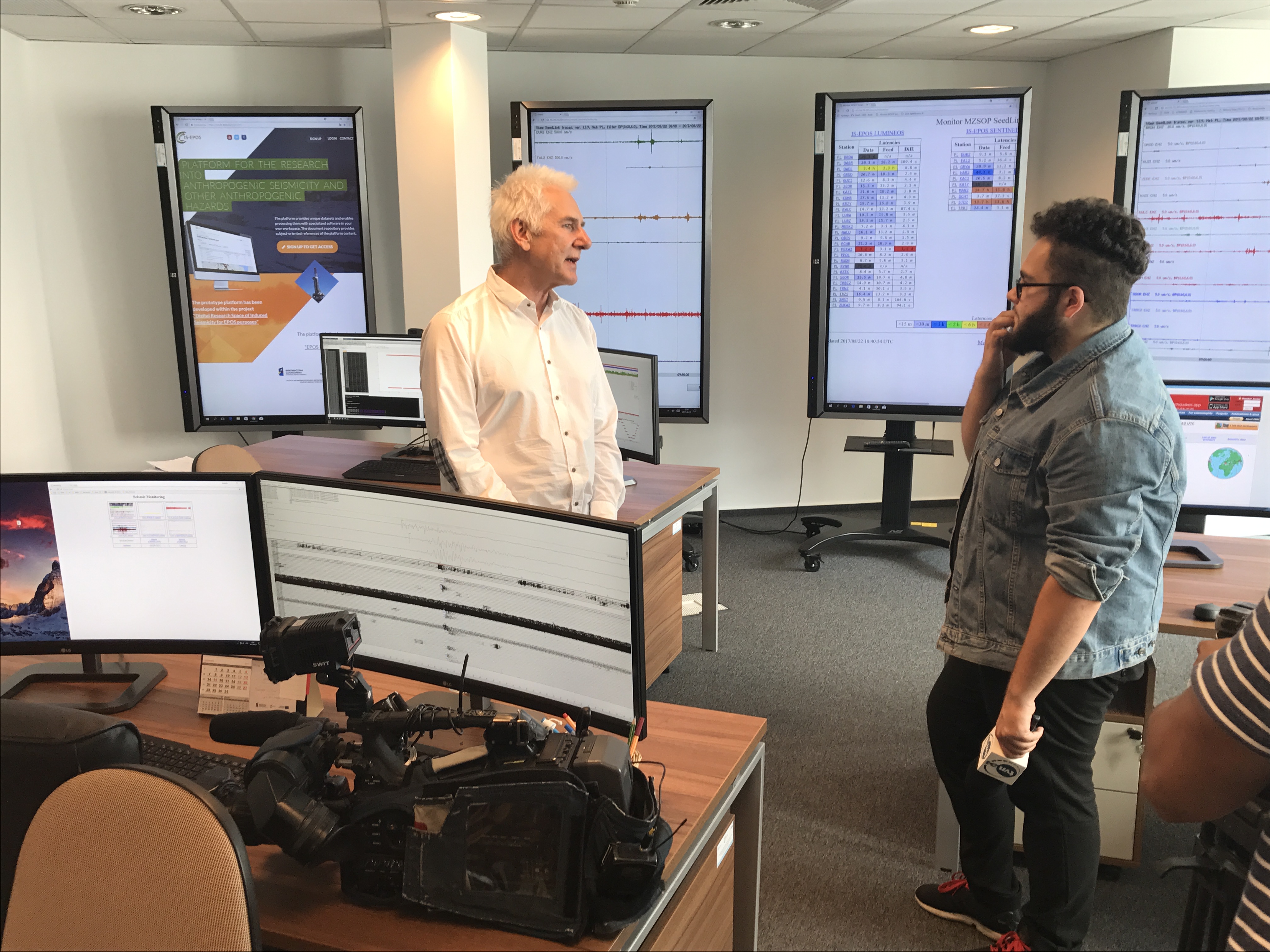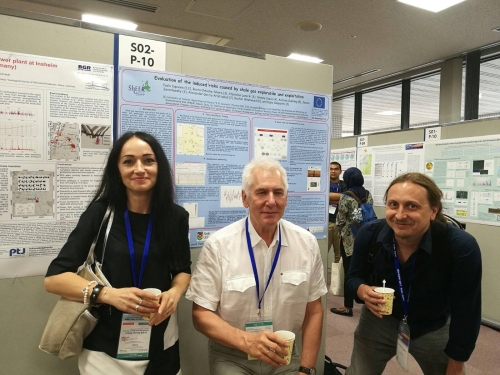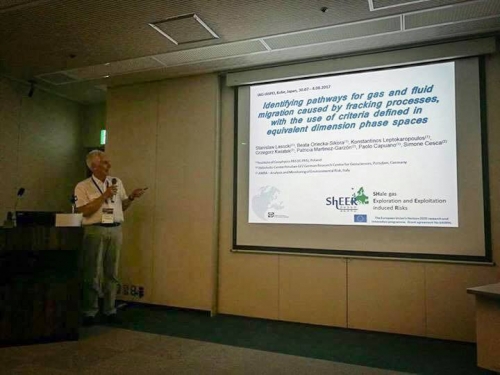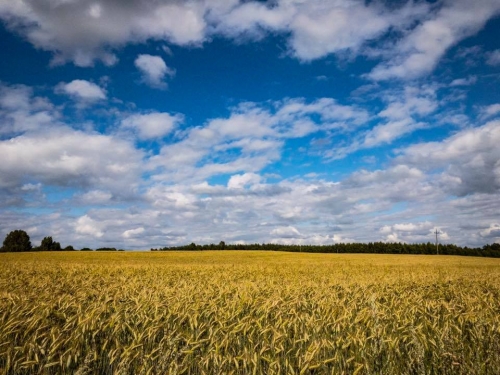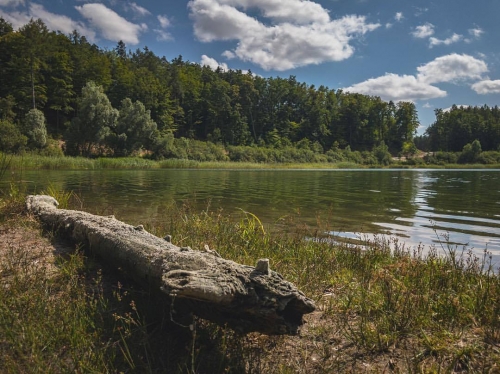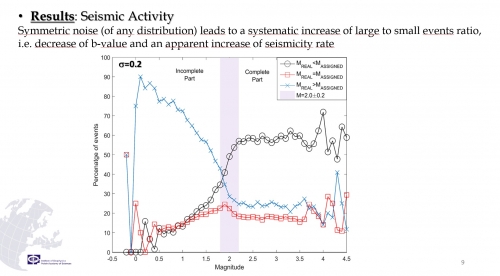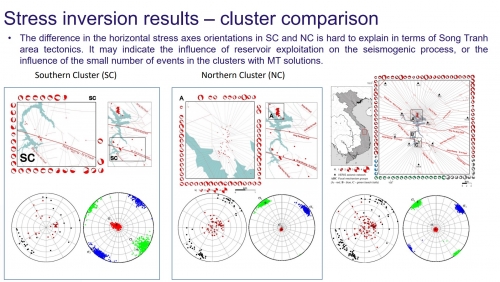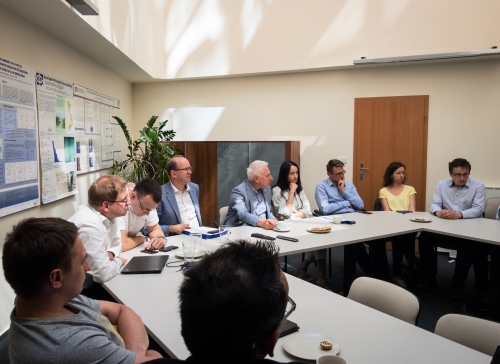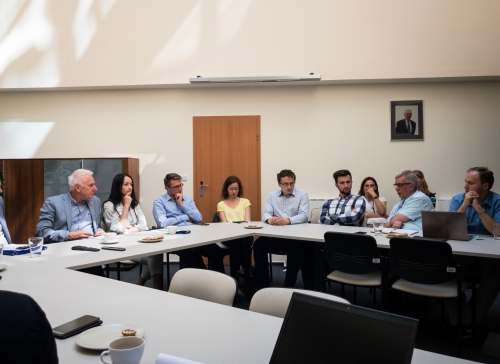News
EVENTS
2019
DECEMBER:
American Geophysical Union Conference, 9th-13th December, San Francisco, USA
- prof. Grzegorz Lizurek with MSc Alicja Caputa attended AGU Fall Meeting
- Grzegorz had an oral presentation "Reservoir triggered seismicity in areas of moderate and low seismicity. Case studies from Vietnam and Poland" as well as a poster "Moment tensor inversion as a tool in stress field interpretation of anthropogenic seismicity"
- Alicja presented a poster "Seismological view on post-blasting seismicity in deep mine environment"
NOVEMBER:
Seminar, 29th of November 2019, 10:00, Kraków.
- dr inż. Konstantinos Leptokaropoulos- "Magnitude Distribution Properties Variation in The Geysers Geothermal Field"
OCTOBER:
28th October 2019, Meeting celebrating the end of the European project EPOS-IP, ACK Krakow.
- On October 28, 2019, a meeting was held at ACK AGH Krakow to celebrate the end of the European EPOS-IP project. You can learn more about the project:
Scintific Meeting, 10th October, 2019, Cambridge, UK.
- On October 10, 2019, in Cambridge, UK, the workshop on Opportunities and Challenges associated with Geothermal Energy took place.
- The workshop was organized by TWI and aimed to identify challenges with geothermal exploitation and demonstrate the techno-economic solutions through contributions of H2020 projects S4CE and Geo-Coat.
- The representative of Department of Seismology IG PAS has attended the workshop and presented the Thematic Core Service Anthropogenic Hazards - Step-change in Tackling Grand Challenges of Hazards Associated with Exploitation of Geo-resources slides, also attached below:
Seminar, 8th of October 2019, 11:00, Kraków.
- dr inż. Jan Wiszniowski- "Artificial Neural Network detection"
SEPTEMBER:
"No Risk No Energy "Summer School
-
Within S4CE project, the "No Risk No Energy" Summer School took place in Salerno, Italy from 16th to 18th of September 2019. IGF participated with 2 presentations performed on the second day of the Summer School. The first one entitled as "Induced seismicity during exploitation and exploration of energy georesources" was performed by Professor Beata Orlecka-Sikora who introduced the students on Anthropogenic Seismicity and the corresponding risks. This was followed by an introduction on TCS-AH and an interactive tutorial of the IS-EPOS platform demonstrated by Dr. Kostas Leptokaropoulos. Both presentations were followed by open discussion among the participants.
AUGUST:
11th International Workshop on Statistical Seismology
-
On August 18-21, 2019, in Hakone, Japan, workshops on statistical seismology took place.
-
Workshop was attended by prof. Lasocki with prof. Beata Orlecka-Sikora.
-
Professor Orlecka-Sikora gave a presentation on "Indications to assess the seismic potential of the injection-induced earthquakes" during sessions "Extending Statistical Seismology Beyond Seismicity"Professor Lasocki performed the poster presentation "Application of the equivalent dimensions method for the study of fracture network development"
JULY:
A tragic shock at KWK Murcki-Staszic
-
Yesterday, 1st of July, 2012 at 14:12:06.765 (12:12: 06.765 UTC) in the Upper Silesian Coal Basin there was a seismic event combined with a tremor in the longwall of KWK Murcki - Staszic. The moment magnitude determined from the recordings of the Polish Seismological Network (PLSN) was M2.9. Below a seismogram from selected PLSN stations is presented.
JUNE:
PROF. DR HAB. INŻ. BEATA ORLECKA-SIKORA RECEIVED PROFESSOR NOMINATION
Seminar, 14th of June 2019, 09:00, Kraków.
- prof. Makoto Okubo "Magma/gas intrusion process of Shinmoedake Eruption in 2017 suggested by volcanic tremors location with ASL method".
- prof. Makoto Okubo visited us from Kochi University Natural Science Cluster
MAY:
Seminar, 14th of May 2019, 10:00, Kraków.
- dr Ansie Smit with prof. Andrzejem Kijko: "UP Natural Hazard Centre- Whowe are and what we are doing"- guests from University of Pretoria, Natural Hazard Centre
- University of Pretoria - Natural Hazard Centre
EPOS-IP Annual Meeting, 06-10.05.2019, Pisa, Italy
- This week EPOS WP14 members gathered in beautiful Pisa for the 4th and final annual meeting to discuss the progress and successes of the EPOS IP project and the consortium plans for the future.
- A data/episode review workshop was also held.
APRIL:
Geosfera 2019, Chęciny:
- Geosfera is an annual workshop aimed at geophysics for Earth Sciences students of various fields.
- Geosfera 2019 workshop was organised by Students Scientific Group PREM from Faculty of the Earth Sciences at University of Silesia.
- It took place in a beautifully location: European Centre for Geological Education of University of Warsaw in Korzecko quarry near Chęciny.
- This year, TCS AH prepared the anthropogenic seismicity workshop dedicated for students. It covered the basics of the anthropogenic seismicity research concepts and the IS-EPOS platform (tcs.ah-epos.eu) training.
- During two days of the workshop students were able to learn how to calculate basic statistical parameters of seismic catalog and how to perform time-dependent hazard analysis in induced seismicity cases. Basics of the physical description of seismic process was also presented with examples and exercises covering location of the events, focal mechanism, moment magnitude calculations and spectral parameters estimations. Students were satisfied with the possibility to work on real data cases and the opportunity to tackle the scientific challenges similar, which they might face in the future.
- Photos from https://www.epos-ip.org/anthropogenic-seismicity-epos-platform-workshop-students-geosfera-2019
Seminar of Department of Seismology, Institute of Geophysics PAS, 29th April 2019, Kraków:
- dr inż Maria Kozłowska: "What governs the productivity of aftershocks in mining environment?"
SUCCESS ! 25.04.2019, Kraków, Warsaw, Seismological World.
- Dr Łukasz Rudziński, during the Scientific Council on 25/04/2019, ceased to be only a Doctor - Welcome to the new Professor in the Department of Seismology.
- Congratulations!
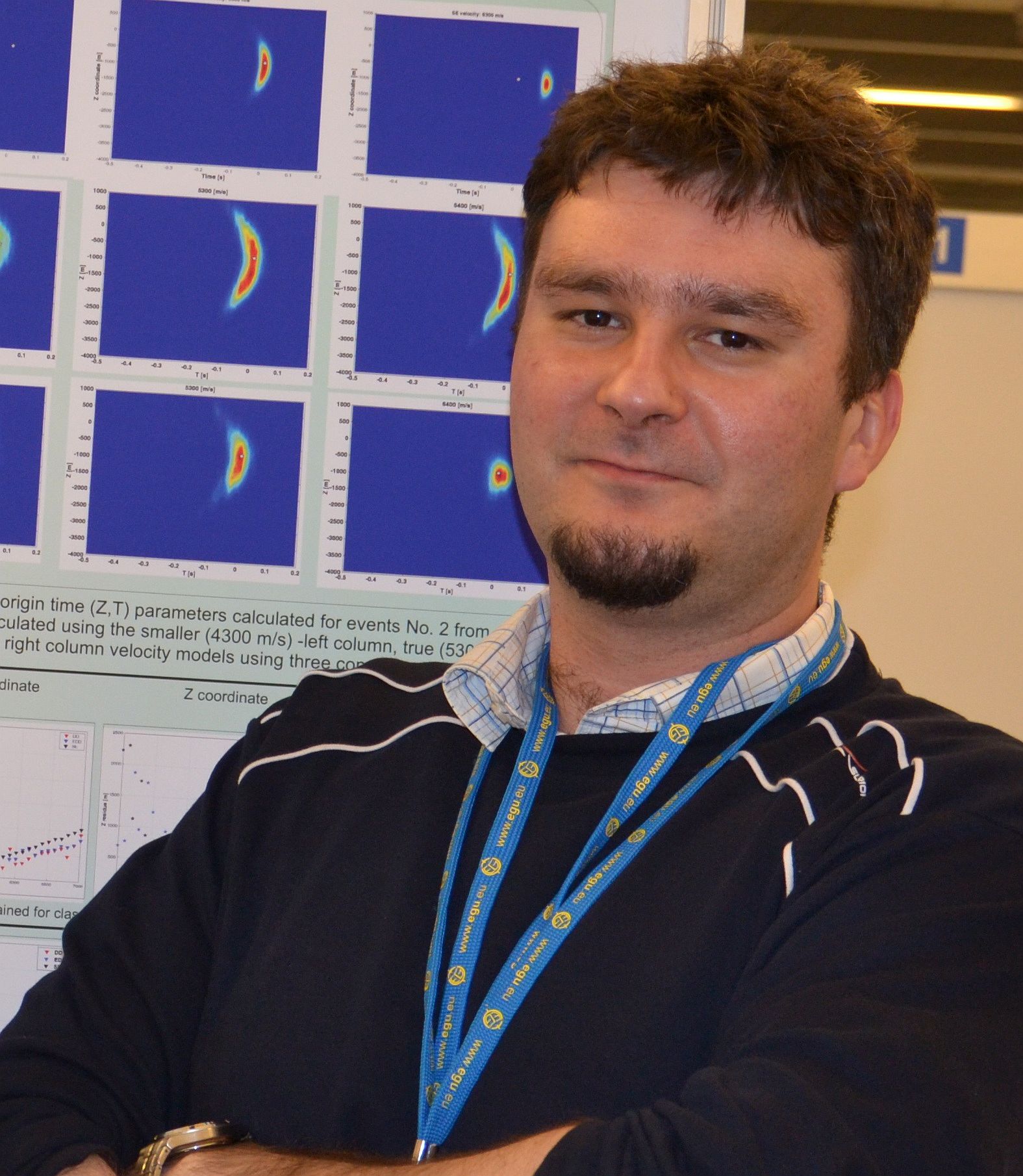
MARCH:
The conference Third Schatzalp Workshop on Induced Seismicity organised by Swiss Seismological Service at ETHZ on March 5-8 in Davos. Our Department was represented by Maria Kozłowska, who presented poster "How to model aftershocks in induced seismicity? Insight into seismicity of Kiruna Mine, Sweden".
FEBRUARY:
Statutory topics implemented in 2018
- 26th-27th February 2019 meeting concerning Statutory topics implemented in 2018 was held in Warsaw in Instytitute of Geophysics PAS.
-
Seismology department was represented by:
- Prof. S. Lasocki: High injection rates counteract formation of far-extending fluid migration pathways
- Dr hab. B. Orlecka – Sikora: Tracking the growth of the injection-induced fracture networks
- Dr M. Kozłowska: Studying aftershocks in mining induced seismicity
- Dr Ł. Rudziński: Rapid ground deformation corresponding to a mining-induced seismic event followed by a massive collapse
- Dr hab. G. Lizurek: Seismicity induced by water reservoirs
- Dr inż. K. Leptokaropoulos: A summary of the advances in injection-induced seismicity obtained within SHEER project.
- Traditionally, the Director prof. Beata Orlecka-Sikora awarded prizes for outstanding publishing activities in 2018. This year, the laureates included: prof. Zbigniew Czechowski, prof. Krzysztof Mizerski, dr hab. Adam Piotrowski, dr Magdalena Mrokowska and dr Mateusz Moskalik.
- dr Maria Kozłowska was awarded for the best presentation of the second day of the meeting, congratulations!
JANUARY:
Seminar of Department of Seismology, Institute of Geophysics PAS, 29th January 2019, Kraków:
- dr Vaclav Vavrycuk: "Earthquake swarms versus mainshock-aftershock activity in West Bohemia, Czech Republic"
- dr Jan Sileny: "Constrained moment tensors: source models and case studies"
Information about our guestst can be found on the website of Institute of Geophysics Czech Academy of Sciences:
2018
DECEMBER:
Seminar of Department of Seismology, Institute of Geophysics PAS, 14th December 2018, Kraków:
- prof. dr hab. Stanisław Lasocki: "Prediction of seismic impact linked to minig in selected sections of KGHM mines on the Żelazny Most tailings pond"
NOVEMBER:
EPOS-PL Conference, 19-21.11.2018, Jachranka.
- The 1st Scientific and Technical Conference dedicated to the EPOS-PL project (European Plate Observing System) was held on 19-21 November 2018, at the Windsor Hotel in Jachranka – near Warsaw, Poland.
- The first day of the conference was dedicated to the main pillars of the EPOS project – the biggest European infrastructural project in Earth Sciences. During first session, Prof. Stanisław Lasocki presented the road of Poland towards integration with EPOS.
- Assoc. Prof. Beata Orlecka-Sikora explained the history and integration of the EPOS Thematic Core Service Anthropogenic Hazards, that, currently, is being coordinated by the Institute of Geophysics PAS.Ostatnią prezentację w tej sesji wygłosił przedstawiciel strategicznego konsorcjanta przemysłowego Pan mgr inż. Adam Barański z Polskiej Grupy Górniczej S.A.– "Rola PGG S.A. w projekcie EPOS-PL – nasz wkład i oczekiwania"
- The last presentation in this session was given by representative of a strategic industrial consortium MSc. Adam Barański from Polska Grupa Górnicza S.A. - "The role of PGG S.A. in the EPOS-PL project - our contribution and expectations".
- More information on the EPOS-PL Conference can be found on the official website of the project: https://epos-pl.eu/i-konferencja-naukowo-techniczna-projektu-epos-system-obserwacji-plyty-europejskiej-epos-pl,60,pl.html
Seminar of Department of Seismology, Institute of Geophysics PAS, 9th November 2018, Kraków:
- mgr Alicja Caputa: "Source analysis of post-blasting events recorded in Rudna copper mine"
-
dr inż. Dorota Olszewska: "A study of site effect using surface-downhole seismic data in a mining area"
OCTOBER:
Project meeting of contractors and consultants Vinnova SIP STRIM Project in Furufjärdens Gästgård, Sweden; 3-4.10.2018
- This project is to determine the criteria for temporary closure and return of operation in seismically active mines.
- The meeting was attended by representatives of the Lulea University, LKAB and Boliden company and consultants from Italy and Poland, including the employees of our Institute: Director Beata Orlecka-Sikora, prof. Stanisław Lasocki, dr Maria Kozłowska and dr Konstantinos Leptokarapoulos.
SEPTEMBER:
36th General Assembly of EUROPEAN SEISMOLOGICAL COMISSION, 2-7.09.2018, Malta.
-
36th General Assembly of the European Seismological Commission (GA ESC) was held from the 2nd to the 7th September 2018 in Valletta, Malta.
-
The Assembly was primarily a meeting ground for academics and researchers working in the field of seismology and related applications, including applied and social aspects of seismology, such as earthquake hazard and risk, earthquake engineering, education and awareness, and risk prevention.
-
Over 40 sessions have been proposed covering different areas of seismology and more.
-
The conference, from the Department of Seismology, was attended by dr hab. Grzegorz Lizurek and mgr inż. Szymon Cielesta, who gave oral presentations and a poster.
AUGUST:
Peter Bormann Young Seismologists Training Course on Array Seismology, 27th-31st.08.2018, Malta.
-
The programme involved a series of lectures, seminars, discussions and practical exercises focused on Array Seismology. Topics tackled during YSTC:
- Introduction to seismic arrays and their configuration, Accessing seismic array data, Stacking seismic traces, Time-domain slowness estimation, Time-domain back-projection, Array based location of microseisms
- The International Monitoring System network CTBTO and many others!
Seminar of Department of Seismology, Institute of Geophysics PAS, 24th August 2018, Kraków:
- mgr inż. Szymon Cielesta: "Seismic response and fracture growth due to fluid injection"
-
dr inż. Maria Kozłowska: "Two types of seismicity accompanying hydraulic fracturing in Harrison County, Ohio. Implications for seismic hazard and seismogenic mechanism."
An article in the Academic Forum promoting the Department of Seismology and the Institute of Geophysics PAS
https://prenumeruj.forumakademickie.pl/media/fa/okladki/fa_07-08_2018_1.jpg
MAY:
Seminar of Department of Seismology, Institute of Geophysics PAS, 21th MAY 2018, Kraków:
- dr hab. prof. IG PAS Artur Cichowicz: "Monitoring and Routine Interpretation of Seismological Data in the Department of Seismology, April 2018"
APRIL:
SHEER final meeting, 26 - 28 of April, 2018, Kraków, Poland.
The official final meeting of SHEER (Shale Gas Exploration and Exploitation Induced Risks) project took place in Kraków, Poland between 26 - 28 of April, 2018. Project was carried out in framework of an international consortium of scientific institutions from Italy, Germany, the Netherlands, UK, USA and Poland. Participants summarized and discussed 3 years of sciene researches in the project. Meeting and discussion led Prof. dr hab. Stanisław Lasocki (Head of Department of Seismology). Photo report of final meeting below.
Meeting with swedish scientists, 16 - 18 of April 2018, Kraków, Poland.
In the Department of Seismology between 16 - 18 of April we were hosting our swedish colleagues:
- prof. Savka Dineva (Luleå tekniska universitet)
- Ville Toernman (Luleå tekniska universitet / LKAB)
- Jesper Martinsson (LKAB)
The main point of this meeting was to evaluate our international cooperation. Moreover scientics from Poland and Sweden were discusing and analyzing the problems they are working on in their departments.
Department of Seismology (IG PAS) was reprezented by:
- prof. dr hab. Stanisław Lasocki
- dr inż. Konstantinos Leptokaropoulos
- dr inż. Maria Kozłowska
- mgr inż. Szymon Cielesta
Photos from the meeting below:
Workshop for teachers, 16 of April 2018, Kraków, Poland
Next part of workshop of ERIS project (Exploitation of Research results in School practice) dedicated for techers. In this time participants from Kraków were introducted how to use a results from scientific research in school lectures. The main topic of the meeting was the physics of earthquakes. Teachers were introduced to possibillities of IS-EPOS platform and how to interepretate and analyze research data.
Workshop was leded by dr Łukasz Rudziński.
Workshop on SWIP 5 system, 12-13 of April 2018, Department of Seismology, Kraków, Poland.
- dr inż. Jan Wiszniowski led the workshop on new SWIP 5 system
- Participants were acquinted with new opportunities of the system
-
Photos from the meeting below:
Workshop for teachers, 9 of April 2018, Warsaw, Poland
Workshop of ERIS project (Exploitation of Research results in School practice) dedicated for techers. Participants were introducted how to use a results from scientific research in school lectures. The main topic of the meeting was the physics of earthquakes. Moreover teachers were introducet how to use IS-EPOS platform and how to exploit avaliable application for data analysis and interpretation.
Workshop was leded by dr hab. Grzegorz Lizurek.
MARCH:
European Geosciences Union General Assembly 2018, 9 - 13 of April 2018, Vienna, Austria.
The main topic of the meeting: "Integrating data and services in solid Earth science".
Department of Seismology was reprezented by:
- dr Monika Sobiesiak
- proh. dr hab. Stanisław Lasocki
dr Monika Sobiesiak: "Developements on the IS - EPOS platform for Analysing Anthropogenic Hazard".
PhD seminar, 28 of March, Warsaw, Poland.
-
mgr Alicja Caputa: "Analysis of post-blasting seismic sources recorded after rockurst active prevention - ideas and syntetic thesis"
Workshops: "Seventh EAGE Workshop on Passive Seismic 2018", 27-29 of March, Cracow, Poland.
-
Department of Seismology IG PAS in this meeting was represented by:
- dr hab. inż. prof. IG PAS Beata Orlecka - Sikora
- prof. dr hab. Stanisław Lasocki
- prof. dr hab. inż. Henryk Marcak
- dr inż. Konstantinos Leptokaropoulos
-
mgr inż. Szymon Cielesta
-
Photos from the meeting:
Workshops on induced seismicity, 21 - 22 of March 2018, Bologna, Italy.
-
Department of Seismology IGF PAS in this meeting was represented by:
- dr hab. inż. (prof. IG PAS) Beata Orlecka - Sikora (director of IG PAS)
- prof. dr hab. Stanisław Lasocki (head of Department of Seismology)
- dr inż. Konstantinos Leptokaropoulos
- mgr inż. Alicja Caputa
-
mgr inż. Szymon Cielesta
-
The main topic being eveolved during this meeting was: "Induced Seismicity: from monitoring of non-stationary processes to definition of performance-based mitigation strategies”.
-
Photos from the event:
EPOS Implementation and Validation Workshop, 12-15.03.2018r, Lisbon, Portugal
- From The Departament of Seismology: prof. Stanisław Lasocki, prof. Beata Orlecka-Sikora oraz dr hab. Grzegorz Lizurek took part in the meeting.
- The main issue being disscused during the meeting was "Critical issues to the effective implementation and validation of EPOS services".
-
Photos from "User strategy and training" session taken by Karolina Chodzińska:
Workshop on data preparation for the MUSE Database Center and TCS Platform, 1-2/03/2018, conference room, Kraków, IGF PAN
- dr inż. Jan Wiszniowski on 01-02/03/2018 in Krakow, led the Workshop on the data preparation for the MUSE Database Center and TCS Platform.
- The workshops concerned in particular the most popular seismic data formats and SeisComp software.
-
Pictures from the event below:
februarY:
Seminar of Department of Seismology, Institute of Geophysics PAS, 19th February 2018, Kraków:
- dr hab. Grzegorz Lizurek : "Noise influence on P-wave amplitude moment tensor decomposition".
JANUARY:
Seminar of Department of Seismology, Institute of Geophysics PAS, 12th January 2018, Kraków:
- prof. Beata Orlecka-Sikora : "Seismicity response of the northwestern part of The Geysers geothermal reservoir to fluid injection.".
2017
December:
Internal report - scientific topics in 2017, 18th December 2017, Kraków
- On December 18, 2017 in the Department of Seismology in Krakow, internal revisions of scientific subjects realized in 2017 took place.
-
Presentations were given by: mgr inż. Wojciech Białoń, mgr inż. Szymon Cielesta, MA Alicja Caputa, dr inż. Konstantinos Leptokaropoulos, dr hab. Grzegorz Lizurek, dr inż. Dorota Olszewska, dr Łukasz Rudziński, dr inż. Jan Wiszniowski.
-
We wish you even more success in the upcoming 2018!
November:
S4CE Project- field visit 23-23.11.2017r, Belgrade, Serbia
- On November 22, 2017, within S4CE project, a visit to the site of the planned seismic monitoring of the Rusanda oil field, the "RUS-17" borehole took place,
- Participants familiarized themselves with the facilities and installations for gas processing "Elemir Oil and Gas Preparation and Transportation Unit", and saw the equipment and work of the geotechnical lab "NIS Scientific and Technological Center (NTC) Laboratory",
-
On November 23, 2017, technical consultations regarding monitoring of works carried out in the Rusanda field took place. 3D / 4D data acquisition (NIS), micro seismicity monitoring (IGF / UNISA), gas emission monitoring (MIRICO), water quality monitoring (UNINA).
RaSiM 9th - Rock Mass Response to Mining and Underground Construction, 15-17 Nov, Santiago, Chile
- The following topics were discussed in RaSiM9: Seismic hazard, Pasive and active seismicity, Mechanism of seismic events and rockbursts, Acquisition, processing and interpretation of seismic data, Induced and tectonic seismicity, Integration of modeling, mine planning and design, Mining and construction under high stress conditions, Rock mass preconditioning, Dynamic support, Laboratory studies, Case studies.
- prof. Beata Orlecka-Sikora, prof. Stanisław Lasocki and dr Łukasz Rudziński attended RaSiM conference and gave speeches:
- IS-EPOS Platform for Anthropogenic Seismicity Research: a modern e-tool of EPOS Thematic Core Service „Anthropogenic Hazards”, designed to integrate infrastructures and facilitate research of human induced seismicity. Rudziński, Ł. Lasocki, S., Orlecka – Sikora, B. Institute of Geophysics PAS, Poland,; Szepieniec, T. Academic Computer Center Cyfronet AGH, Poland; Leptokaroupolos, K. Institute of Geophysics PAS, Garcia-Aristizabal, A. AMRA, Italy; Grasso, J.-R Observatoire Multidisciplinaire des Instabilités de Versants, France and Kwiatek; G. German Research Centre for Geosciences, Germany.
- Complex Mechanism of Rockburst observed on Polish Copper Mines. Rudziński, Ł. Institute of Geophysics Polish Academy of Sciences, Poland; Cesca, S. GFZ German Research Centre for Geosciences, Germany, Talaga, A., Koziarz, E. KGHM Polska Miedź S.A. Rudna Copper Mine, Poland
-
Towards Energy Magnitude for Mining-Induced Seismicity. Rudziński, Ł. Institute of Geophysics Polish Academy of Sciences, Poland; Dineva, S. Department of Civil, Mining and Environmental Engineering, Luleå University of Technology, Sweden
- prof. Lasocki had an invited lecture: A catastrophic event in Rudna copper-ore mine in Poland on 29 November, 2016: what, how and why. Stanisław Lasocki, Institute of Geophysics PAS, Poland
-
prof. Lasocki was the Chair of the Seismic Hazard and Seismic Monitoring Session.
1st, 2nd and 3rd photo is taken from www.rasim.cl/images webpage.
october:
Seminar of Department of Seismology, Institute of Geophysics PAS, 30th October 2017, Kraków:
- prof. dr hab. Stanisławo Lasocki : "The transformation to equivalent dimensions applied to study correlations between seismic and technological activity: the case of The Geysers.",
-
mgr inż. Wojciech Białoń: “Relocation of seismic events from the Niedzica area by the TRMloc program”.
S4CE project- field trip 23-25.10.2017r , Reykjavik, Islandia
- On the 24th of October, a field trip to the Hellisheidi Power Plant, Iceland, took place under the framework of S4CE Project. 15 representatives from 7 institutions including 5 members of the host company, Reykjavik Energy (OR) participated.
- Kostas Leptokaropoulos represented IG-PAS for topics related to WP6.5 (Assessing rapid fluid transport probability and tracking fluid pathways in the rockmass) and WP9.7 (S4CE Database on Is-Epos platform).
- After gathering at the headquarters of OR a short introduction and a safety briefing was given to the participants by OR members. The group then moved to the Hellisheidi ~25 km from Reykjavik and visited the geothermal power plant and the injection site.
-
The field trip was followed by a workshop where the participants exchanged opinions and discussed about potential cooperation through S4CE project, including data availability, techniques development, instrument installation and application of scientific methodologies on the data acquired from the site.
IG PAS visits Vietnam, 18-22.10.2017r, Hanoi, Vietnam
- The anniversary of the International Geophysical Year 1957-2017 was honored at the International Conference on Research and Development in Geophysics, 18 - 22 October 2017 in Hanoi.
- Apart from the scientific sessions devoted to various branches of geophysics, there were also moments of excitement, especially during a visit to Sa Pa, where 60 years ago Polish scientists from the Institute of Geophysics, headed by prof. Roman Teisseyrem, created the first geophysical observatory, which gave rise to geophysical research in Vietnam.
-
In the presence of representatives from IGF PAS, prof. Jerzy Bulik (member of the expedition to Vietnam 1957-1958) and representatives of the Vietnamese side unveiled a plaque commemorating this historic event.
-
Cooperation with scientists from the Institute of Geophysics of the Vietnamese Academy of Sciences is still very fruitful and takes place in many areas of geophysical research.
- Prof. Beata Orlecka-Sikora with prof. Lasocki and dr Jan Wiszniowski from the Department of Seismology IGF PAN participated in this momentous event.
-
More can be read at http://www.igf.edu.pl/wydarzenia.php?news_id=156(photos from www.igf.edu.pl)
WP14 Members attending EPOS IP Annual Meeting in Bucharest
-
prof. Stanisław Lasocki, prof. Beata Orlecka-Sikora and dr hab. Grzegorzem Lizurkiem attended EPOS IP Annual Meeting in Bucharest
SEPTEMBER:
36 POLISH – CZECH – SLOVAKIAN SYMPOSIUM ON MINING AND ENVIRONMENTAL GEOPHYSICS, 24-27 September, Zagórze Śląskie
- dr Łukasz Rudziński and MSc Eng Szymon Cielesta attended 36 POLISH – CZECH – SLOVAKIAN SYMPOSIUM ON MINING AND ENVIRONMENTAL GEOPHYSICS in Zagórze Śląskie, photos below.
-
In addition, the 36th SPCSG Congress held a meeting "Closing Criteria due to seismic hazard", which was attended by the above mentioned scientists from Poland and prof. Savka Dineva (LTU, Sweden) together with PhD students and engineers from Kiruna and Boliden mines (Sweden).
[*]
September 4th and 5th, 2017, Kick Off Meeting of Science 4 Clean Energy, Londyn
-
Prof. Stanisław Lasocki with dr Grzegorz Lizurek and dr Konstantinos Leptokaropoulos attended this meeting and had a speech
-
Science4CleanEnergy, S4CE, is a multi-disciplinary consortium, of world-leading academics, research laboratories, SMEs and industries.
-
S4CE will develop a project that includes fundamental studies of fluid transport and reactivity, development of new instruments and methods for the detection and quantification of emissions, micro-seismic events etc., lab and field testing of such new technologies, and the deployment of the successful detection and quantification technologies in subsurface sites for continuous monitoring of the risks identified by the European Commission.
Seminar of Department of Seismology, Institute of Geophysics PAS, 1st September 2017, Kraków:
- mgr inż. Szymon Cielesta : "Numerical modeling insight into mining seismicity",
-
dr Łukasz Rudziński: “Complex Mechanism of Rockbursts observed on Polish Copper Mines”.
AUGUST:
Interview for Polsat and TVN24 TV, Kraków 2017
-
Due to the earthquake in Italy on the Ischia island, prof. Lasocki, the head of the Seismology Department, was interviewed by Polsat and TVN24 polish televisions.
JUly:
IAG-IASPEI Conference, Kobe, Japan 2017
-
IG PAS Director, prof. Beata Orlecka-Sikora and Head of Seismology Department prof. Stanislaw Lasocki in a prestigious role at the IASPEI conference in Kobe, Japan.
-
Between July 30 and August 4, a conference was organized by the International Association of Seismology and Physics of the Earth's Interior.
-
This year prof. Stanisław Lasocki is the leading S02 session devoted to anthropogenic seismicity and attend as a chair during the next two sessions, while prof. Orlecka-Sikora is on the committees of seismic studies in Koyna, India, congratulations!
-
Both are going to present: "Identifying pathways for gas and fluid migration caused by fracking processes, with the use of criteria defined in equivalent dimension phase spaces", "Evaluation of the induced risks caused by shale gas exploration and exploitation" and "IS-EPOS e- platform of EPOS Thematic Core Service ANTHROPOGENIC HAZARDS – a virtual laboratory for collaborative research experimentation".
-
During the conference prof. Lasocki together with prof. Orleka-Sikora met with our SHEER friends, here a photo with dr. Simone Cesca from GFZ Potsdam
Field works at Wysin, Pomerania, Poland
-
On July 11-13, a delegation to Wysin in Kashubia, within SHEER project, took place. The purpose of the delegation was fieldwork, and more specifically the elimination of all seismic stations operating throughout most of the duration of the SHEER project. These stations were used for seismic monitoring during hydrofracturing of Wysin-2H and 3H borehole. Wysin as always fascinated us with his views, here are a few of them:
JUNE:
Seminar of Department of Seismology, Institute of Geophysics PAS, 30th June 2017, Kraków:
- dr inż. Konstantinos Leptokaropoulos : "Implications of magnitude uncertainties on completeness magnitude and b-value estimations",
-
dr hab. Grzegorz Lizurek: “Moment tensor and stress inversion of reservoir triggered seismicity in Song Tranh2 vicinity”.
Meeting with scientists from Wrocław University of Environmental and Life Sciences, Cracow
-
On June 13, a meeting with a group of scientists of the Institute of Geodesy and Geoinformatics of Wrocław University of Environmental and Life Sciences was held. The meeting is supposed to be the start of scientific cooperation between the mentioned Institute and the Institute of Geophysics Polish Academy of Sciences.
-
During the meeting the scientists presented each other areas of scientific interest and some specific research topics.
-
Dr hab. Grzegorz Lizurek presented research topics conducted at the Department of Seismology and prof. Aleksander Pietruczuk presented selected scientific issues in the Department of Atmospheric Physics. Then dr hab. Grzegorz Lizurek and dr Łukasz Rudzinski discussed the main research works they lead.
-
The meeting was attended by all the staff of the Department of Seismology IG PAS, while the participants of the UPWr reported are:
-
prof. dr hab. inż. Jarosław Bosy
-
prof. dr hab. inż. Andrzej Borkowski
-
dr hab. inż. Witold Rohm
-
dr hab. inż. Krzysztof Sośnica
-
dr inż. Tomasz Hadaś
-
3 PhD students
-
Second SHEER Annual Meeting, Blackpool
-
On 7th June 2017, second SHEER Annual Meeting took place in Blackpool, UK. Department of Seismology IG PAS was represented by prof. Stanisław Lasocki, prof. Beata Orlecka-Sikora, prof. Henryk Marcak, Ph.D. Konstantinos Leptokaropoulos, Monika Staszek and Annna Lisowska.
MAY:
IS-EPOS Platform Workshop, Potsdam
-
On 12th May 2017, IS-EPOS Platform Workshop took place in Potsdam, Germany. During the workshop, IS-EPOS platform was presented to Ph.D., Master students and other people interested in learning how e-research studies can be conducted with all the tools and data provided by IS-EPOS platform.
EPOS-IP meeting, Potsdam
-
On 10th - 11th May 2017, EPOS-IP WP14 meeting was held in Potsdam, Germany. Representatives of 13 institutions involved in WP14 TCS AH were present during the meeting. Crucial activities connected witth TCS AH implementation were discussed and summary of last 18 months of work was conducted.
APRIL:
The European Geosiences Union (EGU) General Assembly 2017, Vienna
-
The European Geosciences Union (EGU), General Assembly 2017 took place in Vienna, Austria, from 24th to 28th of April, 2017. There were 5 participants to represent the Department of Seismology, IG-PAS, namely Dr Konstantinos Leptokaropoulos, Alicja Caputa, Mateusz Lasak, Monika Staszek and Paweł Urban, and also Damian Kula, master's student under supervision of Ph.D. Dorota Olszewska. A total of 12 presentations took place, among them 3 oral, 8 posters and 1 PICO presentation and 14 members of the Department of Seismology IG-PAS were involved in them. Most of them (seven) were presented within the session “ERE2.1 – Energy, Resources and the Environment: Impact of energy and resource exploitation on the environment - Environmental impacts of hydraulic fracturing: Measurements, monitoring, mitigation and management”. Three presentations took place during the session “SM8.1 – Crustal fluids & Seismic activity (incl. induced & triggered seismicity, volcano seismology): Induced and Triggered Seismic Activity: Observation, Theory and Hazard Analysis”. One poster was presented during the co-organized session “SM5.1/ESSI2.10/GI1.6 Integrated research infrastructures and services in geosciences (co-organized)” and the PICO presentation took place within the session “CR2.3 - Applied geophysics and in-situ methods in cryospheric sciences”. From the three oral presentations two were performed by Seismology Department of IG-PAS members Mateusz Lasak and Monika Staszek on Monday, April 24th. Both speakers presented summary and findings of their teams’ research and provided additional information to attendees who asked them questions during their presentations. On Wednesday, April 26th, Dr. Konstantinos Leptokaropoulos performed an one and half hour presentation/demonstration of the IS-EPOS platform in the EPOS booth, entitled as “EPOS Thematic Core Service (TCS) – Anthropogenic Hazards (AH) Demonstration Session”. Discussion with the audience took place during the presentation and demonstration of the platform. All department participants attended oral and poster sessions regarding (among others) earthquake source processes, seismic forecast and hazard assessment, statistical seismology, general seismology, induced seismicity, geothermal resources and environmental impacts of hydraulic fracturing. The seismology department members followed several scientific discussions with other participants and speakers concerning details and future aspects of methods and results.
FEBRUARY:
Inaugaration of EPOS project, Warsaw
- Officialy, with presence of Management, representatives of National Contact Point for Research Programmes of the European Union, National Information Processing Institute and all consortium members, EPOS project (European Plate Observing System) was inaugurated. Aim of the project, cofinanced with resources from European Regional Development Fund, is creating of the research infrastructure in the field of the Earh sciences on the local and national level, and its strict integration with international, european and global databases, services in the framework of EPOS programme.
- Project funds: 62 558 323,87 PLN; Financing from the reseources of European Regional Development Fund: 47 399 281,47 PLN
- Consortium members: Institute of Geophysics Polish Academy of Sciences, ACK Cyfronet AGH, Central Mining Institute, Institute of Geodesy and Cartography, Wrocław University of Environmental and Life Sciences, Military University of Technology, and PGG Coal Company.
-
Head of the project is Ph.D. Dorota Olszewska from Department of Seismology, IG PAS.
EPOS Newsletter
http://us2.campaign-archive2.com/?u=e92e0dec8f1c53a43c7b3f656&id=22a8cd9eed
JANUARY:
Does earthquake threaten us in Poland?
-
On 31st January 2017, Ph.D. Łukasz Rudziński and Ms.C. Ewa Zarzycka were guests of Radio Kraków audition: "Przed hejnałem". Representatives of Department of Seismology were answering the questions about earthquakes in Poland and predicting of earthquakes.
Beginning of the EPOS-PL project, Warsaw
- EPOS (European Plate Observing System) Project agreement was signed on 19th January 2017 in Warsaw.
Project is realised by the Institute of Geophysics Polish Academy of Sciences in cooperation with ACK Cyfronet AGH, Central Mining Institute, Institute of Geodesy and Cartography, Wrocław University of Environmental and Life Sciences, Military University of Technology, and PGG Coal Company.
In the framework of this project a reasearch infrastructure, EPOS-PL, will be created - multilayered, multidisciplinary and interoperable research infrastructure, where data are stored and collected from various, scattered seismic networks, and then the data are processed, standarized and integrated within databases and correspondig metadata. Access to the data is provided through web page with appropriate services/analytical applications and dedicated visualisations.
EPOS-PL project is a part of larger endeavour. Created within the project, new infrastructure EPOS-PL is strictly connected with pan-European infrastructure for solid Earth science and EPOS will be its integral part.
SHEER 4 Newsletter
Earthquakes in central Italy
-
4 events with magnitudes from M5.2 to M5.7 occurred in central Italy on 18 January 2017 within 4 hours. The strongest event took place at 10:14 UTC. All tremors had epicenters located south from Amatrice, town devastated by tragic earthquake with M6.2, occurred on 24th September 2016 and earthquake with M6.5 occurred on 30th October 2016. Both of them were located north from Amatrice. 18th January earthquakes should be considered as a series of aftershocks after October 2016 earthquake, and specifically as a result of activating consecutive fault segments in Amatrice area. Strongest event recorded by PLSN network is shown below:
2016 summary meeting on statutory activities, Warsaw
- On 17th - 17th January 2017, during the meeting summarizing 2015 year in Warsaw, Ph.D. Łukasz Rudziński presented accomplishments of Department of Seismology in the field of statutory activities. Additionaly, 1st edition of Institute of Geophysics Mentors Awards took place.
-
Institute of Geophysics Mentors Awards honoured prof. Stanisław Lasocki, prof. Michał Malinowski, and prof. Krzysztof Mizerski.
16th World Conference on Earthquake Engineering, Chile
-
On 9th - 13th January 2017, 16th World Conference on Earthquake Engineering took place in Chile. Representatives of Department of Seismology were present during the conference: Ph.D. Dorota Olszewska and Ph.D. Konstantinos Leptokaropoulos. Ph.D. Dorota Olszewska presented a paper: "Ground Motion Prediction Equations for mining induced seimicity in Legnica - Glogow Copper District in Poland", and Ph.D. Konstantinos Leptokaropoulos presented: "IS-EPOS: A Digital Research Space to facilitate integrated approach to Anthropogenic Seismic Hazards".
2016
DECEMBER:
2016 Departmenf of Seismology summary meeting, Kraków
- On 19th December 2016, Department of Seismology summary meeting took place in Kraków, with presence of Deputy Scientific Director, assoc.prof. Mariusz Majdański. Summary meeting had a form a seminar - presented topics are listed below:
- Kula, D., Olszewska D. "Comparative analysis of ERT and seismic noise changes in time for purpose of active layer investigations", 35th General Assembly of the European Seismological Commision (poster),
- Marcak H., Lasak M., Mirek J. "Using the velocity of seismic waves estimated from ambient seismic noise to assess the results of hydro-fracturing and the exploitation of shale-rock formations", Pure And Applied Geophysics (under review),
- Leptokaropoulos K. M. and Gkarlaouni C. G. (2016), "A Magnitude Independent Space-Time Earthquake Clustering Algorithm (MISTIC)", Bull. Geol. Soc. Greece, XLVΙII ,
- Lizurek G. (2016) "Full moment tensor inversion as a practical tool in case ofdiscrimination of tectonic and anthropogenic seismicity in Poland", PAGEOPH, DOI:10.1007/s00024-016-1378-9,
- Mirek K., Mirek J. (2016) "Observation of Underground Exploitation Influence on Surface in Budryk, Sośnica and Makoszowy Coal Mine Area". Polish Journal of Environmental Studies Tom: 25 Zeszyt: 5A,
- Olszewska, D., Lasocki S., Leptokaropoulos K. "Non-Stationarity and internal correlations of the occurrence process of mining – induced seismic events", Acta Geophysica (under review),
- Rudziński Ł., Cesca S., Lizurek G. (2016) "Complex Rupture Process of the 19 March 2013, Rudna Mine (Poland) Induced Seismic Event and Collapse in the Light of Local and Regional Moment Tensor Inversion", SEISMOLOGICAL RESEARCH LETTERS, Vol 87, pp:274-284 doi:10.1785/0220150150,
- Staszek M., Orlecka-Sikora B., Lasocki S., Kwiatek G., 2016, "Static stress drop of induced earthquakes in seismic hazard assessment: Preliminary results from The Geysers geothermal site", 35th General Assembly of the European Seismological Commission, 4-10 September, Trieste, Italy,
- Wiszniowski, J., 2016, "Applying the General Regression Neural Network to Ground Motion Prediction Equations of Induced Events in the Legnica-Głogów Copper District in Poland", Acta Geophys. 64, 2430-2448,
-
Kozłowska, M., Orlecka-Sikora B., "Assessment of quantitative aftershock productivity potential in mining-induced seismicity", Pure and Applied Geophysics, DOI:10.1007/s00024-016-1432-7.
Prof. Stanisław Lasocki a member of Council of National Science Centre (Poland) for the years 2016 - 2018
- On 14th December 2016, new members of Council of National Science Centre (Poland) were elected. NSC Council comprises twenty four distinguished scientists from various fields. Tasks of NSC Council include: supporting excellent research projects in all fields of science and humanities, funding doctoral scholarships and post-doctoral internships, financing research projects carried out by experienced researchers aimed at implementing pioneering research important for the development of science, inspiring international cooperation in basic research, supervising the implementation of the awarded research projects
-
Members of NSC Council for the years 2016 - 2018: https://ncn.gov.pl/o-ncn/rada-ncn/struktura-rady
Source: https://www.ncn.gov.pl/aktualnosci/2016-12-15-nowy-sklad-rady-ncn
December workshops
-
On 2nd December 2016, another IS-EPOS Platform workshop took place on AGH University of Science and Technology in Cracow. Event was organized by Institute of Geophysics Polish Academy of Sciences and Academic Scientific Group "GEOFON". Three days later Platform was presented by Szymon Cielesa at the workshop on a Luleå University of Technology, Sweden.
New location of Department of Seismology in Kraków
-
Since 1st December 2016, Department of Seismology has new address: ul Gabrieli Zapolskiej 44, 30-126 Kraków.
NOVEMBER:
Tragic tremor in Rudna Mine, Polkowice
- On 29th November 2016, tragic tremor occurred in the area of Rudna Mine. Following cover caving killed 8 miners and injured 3 more.
-
Tremor was recorded on IG PAS measurement units located in the vicinity of Polkowice. Magnitude of the event (M=3.5) was calculated on the basis of PLSN network and local seismic network. It was strong tremor although in the LGCD area, since the beggining of the mining exploaitation, stronger events took place (strongest event had mangitude M4.5).
Professor Paolo Gasparini Memorial Day, Napoli
-
On 25th November 2016, Professor Paolo Gasparini Memorial Day took place, following his sad passing on 28th July 2116. The ceremony was organized in Università degli Studi di Napoli Federico II.
IS-EPOS Platform Workshop, Katowice
-
On 22th November 2016, IS-EPOS Platform Workshop was held at University of Silesia in Katowice. Event was organized by Institute of Geophysics Polish Academy of Sciences and Academic Scientific Group "PREM". During workshop, participants had opportunity to explore the subject of induced seismicity in easy nad informative way.
III Science Conference, cycle: Construction - Infrastructure - Mining, Kraków
-
On 21st - 22nd November 2016, III Science Conference "Sustainable development of mining areas", from the cycle Construction - Infrastructure - Mining, took place. The event was held on Tadeusz Kościuszko Cracow University of Technology. Ph.D. Dorota Olszewska and Ph.D. Janusz Mirek were representatives of Department of Seismology IG PAS. IS-EPOS platform was presented during conference and Ph.D. Janusz Mirek has shown LUMINEOS seismic network.
Earthquake in Japan
-
On 21st November 2016, strong eaqrthquake with magnitude M6.9 struck near Japan coast. The event happened in close location to 2011 enormours M9.0 earthquake, which triggered powerful tsunami waves, reaching up to 40,5 m, and which caused almost 16.000 casualties. Present earthquake was located at the depth of 11 km under the bottom of the Pacific Ocean (closer to the Japan coast than 2011 event). Earthquake mechanism was a type of normal fault plane solution. 2011 event had reverse fault plane solution and was located deeper (30 km under the bottom of the ocean) and closer to the border of Pacific and North American Plates, which is subduction zone. Tectonics of Japan region is very complicated due to presence of 4 tectonic plates and very active tectonic subduction zone between two aforementioned plates. Pacific Plate is moving under North American Plate with velocity up to 9 cm / year. Additionaly, on the southern edge of Japan Region, there is place of collision of 3 tectonic plates, where 3 tectonic trenches intersect - The Boso Triple Junction. The name originated from the penisula on Honsiu Island, which closes Tokyo Bay from the east, separating it from the Pacific Ocean.
Earthquake in New Zealand
- On 13rd November 2016 at 11:02 UTC, earthquake with magnitude M7.8 struck in New Zealand. It was located 23 km beneath the surface of South Island and 90 km from largest city on the island - Christchurch. Mechanism of event corresponds with reverse fault with maximum displacement on the fault plane about 4 m and 200 km long rupture surface. Earthquake occurred in the southern edge of the Australian Plate; this region has very large seismic activity.
-
In the region of New Zealand there is collision zone, which is boundary between Australian and Pacific Plates. Relative movement of Pacific Plate under Australian Plate is approximately 46 mm / year. South Island of New Zealand is located between two subduction zones and it is a transition zone between Hikurangi and Puysegur Trenches. Second one is a boudary, where Pacific Plate moves under Australian with velociy about 38 mm / year. Tectonics of region is complicated. Relative subduction velocities are rather big, therefore seismic acitivity is large and generates earthquakes with high magnitudes.
Epicenter location of earthquake in New Zealand and range of the ground motions (source: USGS).
OCTOBER:
Earthquakes in Italy
-
2 strong earthquakes struck central Italy on 26th and 30th October, 2016. First one, with magnitude 6.1 , took place 30 km from Amatrice - town previously hit by 6.1M earthquake on September this year. Epicentre of second tremor was located 6 km north from Norcia. Shown below are records of these events registered by PLSN (Polish Seismological Network):
26.10.2016 30.10.2016
-
Interview with prof. Lasocki: http://tvnmeteo.tvn24.pl/informacje-pogoda/swiat,27/naukowcy-ostrzegaja-ze-moga-nastapic-kolejne-trzesienia-ziemi,215898,1,0.html
Committee of Geophysics PAS Meeting, Warsaw
-
Special open meeting of Committee of Geophysics PAS, dedicated to the memory of prof. Adam Dziewoński, was held in Warsaw on 20th October 2016.
Adam Marian Dziewoński (November 15, 1936 – March 1, 2016) was a Polish-American geophysicist who made seminal contributions to the determination of the large-scale structure of the Earth's interior and the nature of earthquakes using seismological methods. He spent most of his career at Harvard University, where he was the Frank B. Baird, Jr. Professor of Science.
EPOS 2 Newsletter
Article about IS-EPOS platform
-
Article: "IS-EPOS: digital research space to facilitate an integrated approach to induced seismicity" was published in newest bulletin of the Mineral and Energy Economy Intitute of the PAS. Authors of article are: prof. Stanisław Lasocki, prof. Beata Orlecka-Sikora, Ph.D. Konstantinos Leptokaropoulos, Ph.D. Grzegorz Lizurek, Ph.D. Mariusz Sterzel, Tomasz Szepieniec, prof. Grzegorz Mutke.
Inauguration of academic year 2016/2017, Warsaw
-
11th October 2016, 11:00 a.m., Warsaw - Inauguration of academic year 2016/2017 with presence of Alicja Caputa, newest doctoral student in Department of Seismology, IG PAS.
EPOS-IP meeting, Madrid
-
On 5th - 7th October 2016, during IPC in Madrid, WP14 Splinter meeting was held. Crucial Legal & Governance and IPR issues were discussed.
SEPTEMBER:
Damian Kula, master's student under supervision of Ph.D. Dorota Olszewska awarded during GA ESC, Trieste
-
Damian Kula, student of master's degree studies in Geophysics at University of Silesia in Katowice, currently preparing master's thesis under supervision of Ph.D. Dorota Olszewska in Institute of Geophysics PAS, was awarded during the 35th General Assembly of the European Seismological Commission (GA ESC) in Trieste, on 5th - 9th September 2016. His paper: Comparative analysis of ERT and seismic noise changes in time for purpose of active layer investigations gained award as a best student poster (http://www.esc-web.org).
Seminar 22st September 2016, 11:00 a.m., conference room, Warsaw
Seminar of Department of Seismology, Institute of Geophysics PAS, 22st September 2016, Warsaw - two presentations given by out respected guests from Greece:
- Prof. Vasilios Karakostas : "Recent strong earthquakes in central Ionian Islands ",
-
Prof. Eleftheria Papadimitriou: “Evolutionary stress field and triggered seismicity”.
Defense of doctoral thesis of Maria Kozłowska, Warsaw
-
21st September 2016, Warsaw - public PhD defense of Maria Kozłowska from Department of Seismology IG PAS. Doctoral thesis: "Studying a possible inclusion of selected methods of estimating stress field changes and seismic activity to the analysis of anthropogenic seismic processes" was written under supervision of prof. Beata Orlecka-Sikora.
PhD thesis reviewers:
- Prof. Józef Dubiński, Central Mining Institute, Katowice
- Prof. Marco Bohnhoff, Freie Universität Berlin
There is possibility to get acquainted with mentioned doctoral dissertation in IG PAS Library (room 6, 9:00 a.m. - 3:00 p.m.).
Prof. Stanisław Lasocki in Brussels
- Conference: ESFRI and national research infrastructures – current challenges from perspective of V4 countries took place o 13th August 2016, in Pernament Representation of the Republic of Poland to the European Union in Brusels. Representatives of science community and Ministry of Science and Higher Education discussed about challenges connected with development and financing of science infrastructure in Europe: Jak wzmacniać infrastrukturę badań? Dyskusja w SP RP.
-
Prof. Stanisław Lasocki, Head of Department of Seismology IG PAS, gave presentation: Integrated approach to geophysical hazards induced by exploration and exploitation of georesources – to facilitate the way of attaining excellence.
North Korean nuclear test
-
The government of North Korea conducted his fifth nuclear test on 9th September 2016. The detonation induced large manmade earthquake - United States Geological Survey (USGS) reported that earthquake occured on 9:30 a.m. (local time) and had magnitude 5.3 in Richter scale. The video footage containing interview with prof. Stanisław Lasocki: http://wiadomosci.tvp.pl/26620356/09092016-1930 (23:37 min)
European Seismological Commission 2016, Trieste
-
Strong representation of Department of Seismology IG PAS was present during the 35rd General Assembly of the European Seismological Commission (GA ESC) in Trieste, on 4th - 10th September 2016.
Anthropogenic Seismicity Workshop, Nancy
- On 1st - 2nd September 2016, Anthropogenic Seismicity Workshop took place in Campus ARTEM, School of Mines, Nancy, France. TCS-AH platform was presented and prof. Stanisław Lasocki gave two presentations:
Integrated approach to geophysical hazards induced by exploration and exploitation of georesources - to facilitate the way of attaining excellence
Probabilistic Analysis of The Time-varyingHazard Dueto AnthropogenicSeismicity – How we do itin WP14 (TCS AH) of EPOS
AUGUST:
EPOS-IP WP14 meeting, Nancy
-
On 30th - 31st August 2016, EPOS-IP WP14 meeting was organized in Campus ATREM School of Mines, Nancy, France, to discuss work progress within the project, legal issues necessary for further project realisation and plans for future. Institute of Geophysics, PAS, and School of Mines in France were co-organisers of meeting
SHEER 3 Newsletter
Strong earthquake in Italy
- Almost 300 people died in effect of large earthquake with magnitude 6.2 in Richter scale, which occured 24th August 2016 at 03:36 (01:36 UTC). Prof. Stanisław Lasocki in interview for TVN about aftershocks: http://tvnmeteo.tvn24.pl/informacje-pogoda/swiat,27/pojawiaja-sie-wstrzasy-wtorne-ale-o-mniejszej-magnitudzie,209808,1,0.html.
-
Prof. Beata Orlecka-Sikora anwers question about predicting earthquakes in radio interview for Jedynka: http://www.polskieradio.pl/7/5347/Artykul/1659330,Czy-naukowcy-moga-przewidziec-trzesienie-ziemi.
JULY:
EPOS 1 Newsletter
Vietnam
-
Ph.D. Janusz Mirek and Ph.D. Jan Wiszniowski travelled to Quang Nam province in Vietnam in order to modernize and extend VERIS seismic network.
JUNE:
LACSC, Costa Rica
-
On 20th - 22nd June 2016, in San José (Costa Rica), The Latin America and Caribbean Seismological Commission (LACSC) 2nd Regional Accembly was held. Participants of this conference were prof. Beata Orlecka-Sikora and prof. Stanisław Lasocki.
Ph.D. Grzegorz Lizurek talks to Karolina Głowacka on TOK FM radio about SHEER project
-
People can cause earthquakes. How is this possible? Ph.D. Grzegorz Lizurek explains this phenomena during radio interview with Karolina Głowacka: http://audycje.tokfm.pl/odcinek/Ludzie-potrafia-powodowac-trzesienia-ziemi-Jak-to-mozliwe-Wyjasnia-dr-Grzegorz-Lizurek-w-rozmowie-z-Karolina-Glowacka/38854
Popular scientific article, written by Ph.D. Grzegorz Lizurek, published by portal Science Online
-
In the newest issue of magazine ACADEMIA Ph.D. Grzegorz Lizurek writes about earthquakes induced by human impact on inner structure of rocks: http://www.naukaonline.pl/nasze-teksty/nauki-o-ziemi/item/2817-wzburzenie-skal
First SHEER Annual meeting, Naples
-
On 7th-9th June, 2016 in Napoli took place SHEER First Annual Meeting. Department of Seismology IG PAS was represented by: prof. Beata Orlecka-Sikora, prof. Stanislaw Lasocki, Ph.D. Dorota Olszewska, Ph.D. Grzegorz Lizurek, Monika Staszek and Anna Lisowska. Leaders of WP2 (prof. Beata Orlecka-Sikora) and WP3 (prof. Stanisław Lasocki) lead respective parts of meeting, summarizing all activities within packages.
Applied Geophysics scientific symposium, Gdańsk
- Applied Geophysics scientific symposium was held on 1st - 3rd March 2016 in Gdańsk. Main topics of conference were: Geophysical Methods for Civil and Industrial Construction Applications, Mining Geophysics Engineering, Environmental Geophysics. During symposium Ph.D. Grzegorz Lizurek presented capabilities of IS-EPOS platform and gave presentation: "IS-EPOS: a digital research space to facilitate integrated approach to induced seismicity".
-
Prof. Henryk Marcak presented: "Phase change between the reflected and refracted waves in GPR measurements of ground wave"
MAY:
Seminar, 31st May 2016, 2:00 p.m., conference room, Kraków
-
Szymon Cielesta: The effect of intermediate principal stress (sigma2) on seismicity in mine.
SHEER 2 Newsletter
APRIL:
Seminar, 27th April 2016, 11:00 a.m., conference room, Kraków
-
Monika Staszek: Evaluation of static stress drop influence on seismicity distribution at The Geysers geothermal area.
EGU, Vienna
-
Ph.D. Łukasz Rudziński, Maria Kozłowska and Alicja Caputa participated in European Geosciences Union General Assembly 2016, which took place in Vienna on 17th - 22nd April 2016.
Seminar, 5th April 2016, 11:00 a.m., conference room, Kraków
-
Maria Kozłowska: Investigating untypical seismicity distribution in Upper Silesia hard coal mine - insight into natural, human-induced and coseismic stress change.
FEBRUARY:
Seminar, 29th February 2016, 12:00 p.m., conference room, Kraków
-
Prof. Henryk Marcak: Use of Seismic Interferometry for Assessment of the Environment Risk Related to Exploitation of Shale Gas.
Nanometrics measuring units training course, Kraków
-
On 2nd - 3rd February 2016, Nanometrics measuring units training course took place in the Department of Seismology, IG PAS, Kraków. Training was lead by Robert Statham, canadian representative of Nanometrics.
JANUARY:
Seminar, 27th January 2016, 3:00 p.m., room 213, Warsaw
-
Ph.D. Konstantinos Leptokaropoulos, Szymon Cielesta, Monika Staszek: Characteristics of seismicity related to hydro-fracturing. Review and Case Studies.
2015 summary meeting, Warsaw
-
On 29th January 2016, during meeting summarizing 2015 year in Warsaw, Ph.D. Łukasz Rudziński presented accomplishments of Department of Seismology in the field of statutory activities.
SHEER 1 Newsletter
Sucess of IS-EPOS project appreciated in Europe
- Project RICH 2020 (Research Infrastructures Consortium for Horizon 2020). the European Network of National Contact Points (NCPs) for Research Infrastructures in Horizon 2020, facilitates transnational cooperation between NCPs, promotes the effective implementation of the RI programme, supports transnational and virtual access to RIs and highlights the opportunities offered by Research Infrastructures - at the European and international level. Integrated approach to geophysical hazards induced by exploration and exploitation of georesources to facilitate the way of attaining excellence, prof.Stanisław Lasocki and prof. Beata Orlecka-Sikora, Institute of Geophysics, PAS.
2015
NOVEMBER:
IS-EPOS Platform presented to general public, Katowice
OCTOBER:
Children's Univeristy in Department of Seismology, Kraków
-
In October - November 2015, series of 13 lectures took place in the framework of Children's University programme. Events were held in the Department of Seismology in Kraków. The main topic of the lectures was answering the children to the question: "Will it be an earthquake in Kraków?". M.Sc. Maria Kosłowska explained to more than 200 children why there are no strong earthquakes in Kraków, history of seismicity in Poland, where and how earthquakes are recorded. Children had an opportunity to analyze seismograms and generate their own "earthquake".
MAY:
Seminar, 29th May 2015, 10:30 a.m., conference room, Kraków
- Ph.D. Jan Wiszniowski Applying the General Regression Neural Network to ground motion prediction equations of induced events.
-
Ms.C. Katarzyna Nowak Stress analysis based on full moment tensor solutions from the region Song Tranh 2 reservoir.
Kick - off meeting of SHEER project
-
The kick-off meeting of international SHEER (Shale gas Exploration and Exploitation induced Risks) project took place in Cracow on May 5th-7th. The consortium includes partners from Italy, United Kingdom, Poland, Germany, the Netherlands and USA.
The objective of SHEER is to develop best practices for assessing and mitigating the environmental footprint of shale gas exploration and exploitation. It will develop a probabilistic procedure for assessing short and long-term risks associated with groundwater contamination, air pollution and induced seismicity. An important part of SHEER will be devoted to monitor and understand how far enhanced permeability pattern, which may develop as an unwanted by-product of the fracking processes, will develop both in space and time. SHEER will develop methodologies and procedures to track and model fracture evolution around shale gas exploitation sites and a robust statistically based, multi-parameter methodology to assess environmental impacts and risks across the operational lifecycle of shale gas. The developed methodologies will be applied and tested on a comprehensive database consisting of seismicity, changes of the quality of ground-waters and air, ground deformations, and operational data collected from past case studies. Representatives of all institutions involved in the project were present during the kick-off meeting.
All data collected during SHEER project will be integrated within IS-EPOS platform (http://is-epos.eu/).
APRIL:
Seminar, 30th April 2015, 10:30 a.m., conference room, Kraków
-
Ms.C. Maria Kozłowska Earthquake spectral analysis using empirical Green's function (EGF) method.
MARCH:
Seminar, 26th March 2015, 11:30 a.m., conference room, Kraków
- Ms.C. Wojciech Białoń Seismicity of Czorsztyn Lake region: A case of reservoir triggered seismic process?
-
Alicja Caputa Analysis of post blasting source mechanism of mining induced seismic events occured on Rudna copper mine, Poland.
Visit of guests from Egypt
-
On 3rd - 27th March 2015, Department of Seismology IG PAS was visited by Prof. Haggag Hamed Mohamed and Ph.D. Ezzat Mohamed Elamin from The Academy of Scientific Research & Technology (ASRT) in the Arab Republic of Egypt. Recorded data from Aswan dam area was presented and relation between seismicity ratio and annual changes of water level in repository was discusssed. in the framework of the visit. Exemplary recordings of seismic events were used to conduct focal mechanism analysis and spectral analysis. Further frames of cooperation were determined in the area of observational seismology.
February:
Seminar, 26th February 2015, 11:30 a.m., conference room, Kraków
- Ph.D. Łukasz Rudziński Source mechanism of March 19th Rudna's mine rockburst in a view of local and regional seismic data.
-
Ms.C. Paweł Urban Violations of Gutenberg-Richter relation in anthropogenic seismicity.
January:
Seminar, 15th January, 11:00 a.m., conference room, Kraków
- Ph.D. Grzegorz Lizurek Focal mechanisms of the induced seismic events from Song Trahn2 reservoir (Vietnam).
-
Ms.C. Monika Staszek Converted waves modeling and evaluation of CCP stacking efficiency.
2014
NOVEMBER:
Seminar, 27th November 2014, 10:00 a.m., conference room, Kraków
- Ms.C. Konstantinos Leptokaropoulos Modeling seismicity rate changes by studying the effect of stress field variation on seismicity.
-
Ms.C. Szymon Cielesta Numerical modeling of dynamic phenomena occurring in the rock mass.
MAY:
Seminar, 14th May 2014, 11:00 a.m., room 213, Warsaw
- Ms.C. Konstantinos Leptokaropoulos Completeness Magnitude Determination for Seismicity Catalogs.
-
Ph.D. Piotr Senatorski prof. PAN Modelling of earthuakes and seismic cycles.
APRIL:
Seminar, 23rd April 2014, 12:00 p.m., room 213, Warsaw
- Ms.C. Katja Thiemann Seismic monitoring in salt mines.
-
Ph.D..Mariusz Białecki On complex systems description of seismicity.
MARCH:
Seminar, 13th March 2014, 09:30 a.m., room 106c, Warsaw
- Ph.D. Zbigniew Czechowski prof. PAN Construction of a Langevin model from time series with a periodical correlation function: Application to wind speed data.
-
Ms.C. Paweł Urban Complexity of distributions of sources of seismic sources in relation with induced seismicity and its consequences.
FEBRUARY:
Seminar, 13th February 2014, 09:30 a.m., room 106c, Warsaw
- Ph.D. Łukasz Rudziński Seismic network LUMINEOS - possibilities and prospects of monitoring of seismicity induced by minining activities.
- Ph.D. Grzegorz Lizurek Fast estimation of spectral parameters of seismic records using BREWS (Bucharest Rapid Early Warning System).
2013
November:
Seminar, 21st November 2013, 11:00 a.m., room 106c, Warsaw
- Ph.D. Jan Wiszniowski and Ms.C. Beata Plesiewicz VERIS seismic network in Vietnam - installation and first registrations.
-
Ph.D. Wojciech Dębski, prof. PAN Inwersja Bayesowska - czy można ilościowo szacować błędy?
OCTOBER:
Seminar, 25th October 2013, 11:00 a.m., room 106c, Warsaw
- Ph.D.. Beata Orlecka-Sikora, prof. PAN Wpływ kosejsmicznych zmian naprężeń głównych na proces sejsmiczny w kopalni Rudna.
-
Prof. Stanisław Lasocki CiD w sejsmiczności indukowanej - przypadek sekwencji trzęsień ziemi Emilia-Romagna 2012.
SEPTEMBER:
Seminar, 23rd September 2013, 1:30 p.m., room 213, Warsaw
-
prof. Tsuyoshi ISHIDA: Dept. of Civil and Earth Resources Engineering Kyoto University C-Cluster, Katsura Campus of Kyoto University - Stress Redistribution with Chamber Excavation. Advantages of CO2 fracturing for shale gas recovery: Evidence from laboratory experiments.
JULY:
Seminar, 11th July .2013, 11:00 a.m., room 106c, Warsaw
-
Ph.D. Jan Kozak and Ph.D. Petr Jedlicka, goście z Czeskiej Akademii Nauk - Prezentacja nowych przyrządów do badań drgań obrotowych.
JUNE:
Seminar, 5th June 2013, 1:30 p.m., room 106c, Warsaw
- Ph.D. Łukasz Rudziński Badania grupowania zjawisk w oparciu o podobieństwo sygnałów w sejsmiczności indukowanej działalnością górniczą.
-
Ph.D. Jan Wiszniowski Zastosowanie sztucznych sieci neuronowych do estymacji regresji.
MAY:
Seminar, 22nd May 2013, 1:30 p.m., room 106c, Warsaw
-
Ph.D. Roman Teisseyre Fracture Processes in Asymmetric Theory.
APRIL:
Seminar, 17th April 2013, 1:30 p.m., room 106c, Warsaw
- Ms.C. Maria Kozłowska Zastosowanie modelu Rate-and-State do modelowania zmian sejsmiczności po wstrząsie w kopalni złota Mponeng.
-
Ph.D. Grzegorz Lizurek Wstrząs z dnia 19.03.2013 z kopalni "Rudna". Zjawisko wyzwolone na uskoku?
MARCH:
Seminar, 20th March 2013, 11:00 a.m., room 106c, Warsaw
- Ph.D. Włodzimierz Bielski, prof. IGF PAN Ograniczenia dla efektywnych stałych materiałowych i zastosowania w sejsmologii.
- Ms.C. Monika Dec USArray a obraz struktury po kolejnych trzęsieniach ziemi.






